Samsung Electronics Co CLP660ND Color Laser Printer User Manual CLP 6xx Series EN
Samsung Electronics Co Ltd Color Laser Printer CLP 6xx Series EN
Contents
- 1. Users Manual 1
- 2. Users Manual 2
Users Manual 1
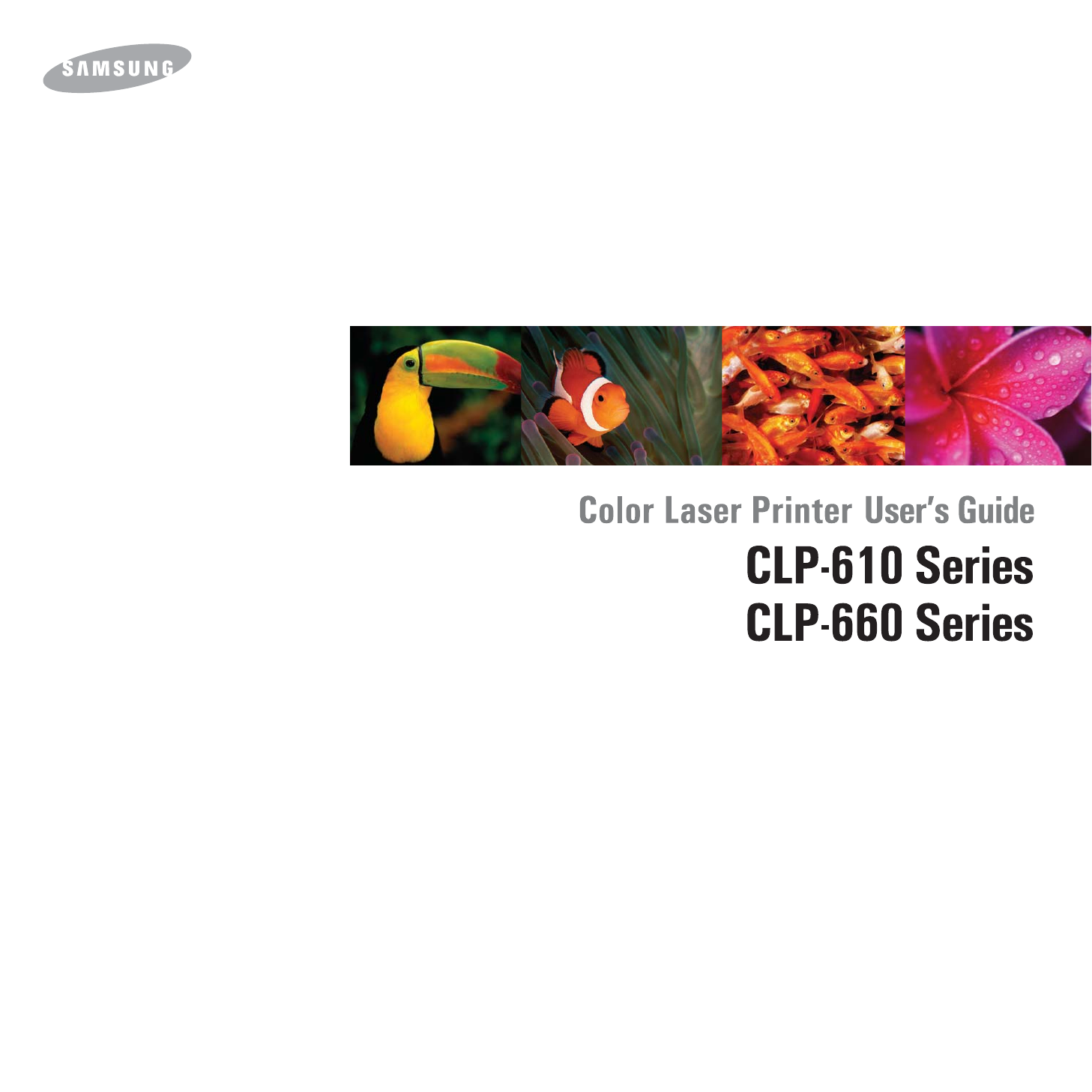
© 2007 Samsung Electronics Co., Ltd. All rights reserved.
This user’s guide is provided for information purposes only. All information included herein is subject to change without notice. Samsung Electronics is not
responsible for any changes, direct or indirect damages, arising from or related to use of this user’s guide.
• CLP-610ND, CLP-660N, and CLP-660ND are model names of Samsung Electronics Co., Ltd.
• Samsung and Samsung logo are trademarks of Samsung Electronics Co., Ltd.
• PCL and PCL 6 are trademarks of Hewlett-Packard company.
• Microsoft, Windows, Windows NT and Windows Vista are either registered trademarks or trademarks of Microsoft Corporation.
• PostScript 3 is a trademark of Adobe System, Inc.
• UFST® and MicroType™ are registered trademarks of Monotype Imaging Inc.
• TrueType, LaserWriter and Macintosh are trademarks of Apple Computer, Inc.
• All other brand or product names are trademarks of their respective companies or organizations.
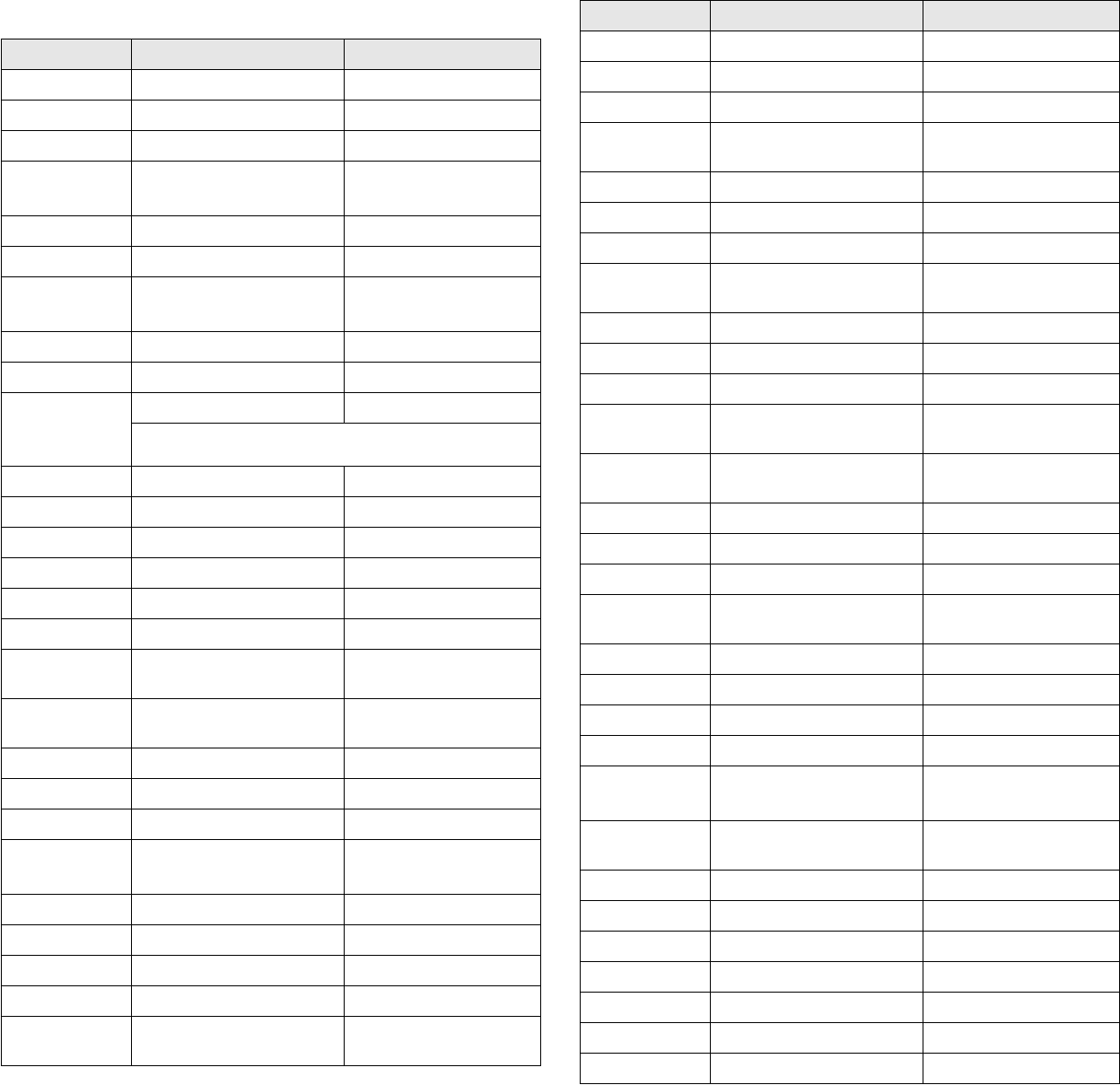
CONTACT SAMSUNG WORLD WIDE
If you have any comments or questions regarding Samsung products,
contact the Samsung customer care center.
Country Customer Care Center Web Site
ARGENTINE 0800-333-3733 www.samsung.com/ar
AUSTRALIA 1300 362 603 www.samsung.com/au
BELGIUM 02 201 2418 www.samsung.com/be
BRAZIL 0800-124-421
4004-0000
www.samsung.com/br
CANADA 1-800-SAMSUNG (7267864) www.samsung.com/ca
CHILE 800-726-7864 (SAMSUNG) www.samsung.com/cl
CHINA 800-810-5858
010- 6475 1880
www.samsung.com.cn
COLOMBIA 01-8000-112-112 www.samsung.com/co
COSTA RICA 0-800-507-7267 www.samsung.com/latin
CZECH
REPUBLIC
844 000 844 www.samsung.com/cz
Distributor pro ýeskou republiku : Samsung Zrt., þeska
organizaþní složka Vyskoþilova 4, 14000 Praha 4
DENMARK 70 70 19 70 www.samsung.com/dk
ECUADOR 1-800-10-7267 www.samsung.com/latin
EL SALVADOR 800-6225 www.samsung.com/latin
ESTONIA 800-7267 www.samsung.ee
KAZAHSTAN 8-800-080-1188 www.samsung.kz
FINLAND 030-6227 515 www.samsung.com/fi
FRANCE 3260 SAMSUNG or
08 25 08 65 65 (€ 0,15/min)
www.samsung.com/fr
GERMANY 01805 - 121213
(€ 0,14/min)
www.samsung.de
GUATEMALA 1-800-299-0013 www.samsung.com/latin
HONG KONG 3698 4698 www.samsung.com/hk
HUNGARY 06-80-SAMSUNG (7267864) www.samsung.com/hu
INDIA 3030 8282
1800 110 011
www.samsung.com/in/
INDONESIA 0800-112-8888 www.samsung.com/id
ITALIA 800-SAMSUNG(7267864) www.samsung.com/it
JAMAICA 1-800-234-7267 www.samsung.com/latin
JAPAN 0120-327-527 www.samsung.com/jp
LATVIA 800-7267 www.samsung.com/lv/
index.htm
LITHUANIA 8-800-77777 www.samsung.com/lt
LUXEMBURG 0032 (0)2 201 24 18 www.samsung.lu
MALAYSIA 1800-88-9999 www.samsung.com/my
MEXICO 01-800-SAMSUNG
(7267864)
www.samsung.com/mx
NETHERLANDS
0900 20 200 88 (€ 0,10/min) www.samsung.com/nl
NORWAY 815-56 480 www.samsung.com/no
PANAMA 800-7267 www.samsung.com/latin
PHILIPPINES 1800-10-SAMSUNG
(7267864)
www.samsung.com/ph
POLAND 0 801 801 881 www.samsung.com/pl
PORTUGAL 80 8 200 128 www.samsung.com/pt
PUERTO RICO 1-800-682-3180 www.samsung.com/latin
REP.
DOMINICA
1-800-751-2676 www.samsung.com/latin
Republic of
Ireland
0818 717 100 www.samsung.com/uk
RUSSIA 8-800-200-0400 www.samsung.ru
SINGAPORE 1800-SAMSUNG (7267864) www.samsung.com/sg
SLOVAKIA 0800-SAMSUNG (726786) www.samsung.com/sk
SOUTH
AFRICA
0860 726 7864 (SAMSUNG) www.samsung.com/za
SPAIN 902 10 11 30 www.samsung.com/es
SWEDEN 0771-400 200 www.samsung.com/se
Switzerland 0800-7267864 www.samsung.com/ch/
TAIWAN 0800-329-999 www.samsung.com/tw
THAILAND 1800-29-3232
02-689-3232
www.samsung.com/th
TRINIDAD &
TOBAGO
1-800-7267-864 www.samsung.com/latin
U.A.E 800-SAMSUNG (7267864) www.samsung.com/mea
U.K 0870 SAMSUNG (7267864) www.samsung.com/uk
U.S.A 1-800-SAMSUNG (7267864) www.samsung.com
UKRAINE 8-800-502-0000 www.samsung.com/ur
UZBEKISTAN 8-800-120-0400 www.samsung.com.uz
VENEZUELA 0-800-100-5303 www.samsung.com/latin
VIETNAM 1 800 588 889 www.samsung.com/vn
Country Customer Care Center Web Site
CONTENTS
About this user’s guide .................................................................................................................................................i
Finding more information .............................................................................................................................................i
Safety and Regulatory Information .............................................................................................................................. ii
1. Introduction
Special features ...................................................................................................................................................... 1.1
Machine overview ................................................................................................................................................... 1.2
Front view ........................................................................................................................................................... 1.2
Rear view ............................................................................................................................................................ 1.3
Control panel overview ............................................................................................................................................ 1.4
Understanding the Status LED ................................................................................................................................ 1.5
Status LED with the print cartridge messages .................................................................................................... 1.5
Understanding the menu map ................................................................................................................................. 1.6
Accessing menus ................................................................................................................................................ 1.6
Menu overview .................................................................................................................................................... 1.6
Description on each menu .................................................................................................................................. 1.7
2. Software overview
Supplied software .................................................................................................................................................... 2.1
Printer driver features .............................................................................................................................................. 2.1
System requirements .............................................................................................................................................. 2.2
3. Getting Started
Setting up the hardware .......................................................................................................................................... 3.1
Setting up the network ............................................................................................................................................ 3.1
Supported operating systems ............................................................................................................................. 3.2
Configuring network protocol via the machine .................................................................................................... 3.2
Installing the software ............................................................................................................................................. 3.3
Printer's basic settings ............................................................................................................................................ 3.4
Altitude Setting after Software Installation .......................................................................................................... 3.4
Changing the display language .......................................................................................................................... 3.5
Setting job timeout .............................................................................................................................................. 3.5
Using power saving feature ................................................................................................................................ 3.5
Setting the default paper size and type .............................................................................................................. 3.5
Setting the default tray ........................................................................................................................................ 3.5
4. Selecting and loading print media
Selecting print media ............................................................................................................................................... 4.1
Guidelines for selecting and storing print media ................................................................................................. 4.1
Specifications on print media .............................................................................................................................. 4.2
Media sizes supported in each mode ................................................................................................................. 4.3
Guidelines for special print media ....................................................................................................................... 4.3
Loading paper ......................................................................................................................................................... 4.4
In the tray ............................................................................................................................................................ 4.4
In the multi-purpose tray ..................................................................................................................................... 4.6
Setting the paper size and type ............................................................................................................................... 4.7
5. Basic printing
Printing a document ................................................................................................................................................ 5.1
Canceling a print job ............................................................................................................................................... 5.1
6. Maintenance
Printing a machine configuration report .................................................................................................................. 6.1
Printing a network report ......................................................................................................................................... 6.1
Monitoring the supplies' life ..................................................................................................................................... 6.1
Cleaning your machine ........................................................................................................................................... 6.1
Cleaning the outside ........................................................................................................................................... 6.1
Cleaning the inside ............................................................................................................................................. 6.1
Maintaining the cartridge ......................................................................................................................................... 6.3
print cartridge storage ......................................................................................................................................... 6.3
Expected cartridge life ........................................................................................................................................ 6.3
Redistributing toner ................................................................................................................................................. 6.3
Replacing the print cartridge ................................................................................................................................... 6.4
Replacing the Paper Transfer Belt .......................................................................................................................... 6.6
Maintenance Parts .................................................................................................................................................. 6.8
Managing your machine from the website .............................................................................................................. 6.8
7. Troubleshooting
Tips for avoiding paper jams ................................................................................................................................... 7.1
Clearing paper jams ................................................................................................................................................ 7.1
In the paper feed area ........................................................................................................................................ 7.1
In the multi-purpose tray ..................................................................................................................................... 7.3
In the fuser unit area ........................................................................................................................................... 7.4
In the paper exit area .......................................................................................................................................... 7.5
In the optional tray .............................................................................................................................................. 7.6
Understanding display messages ........................................................................................................................... 7.7
Solving other problems ......................................................................................................................................... 7.11
Paper feeding problems .................................................................................................................................... 7.11
Printing problems .............................................................................................................................................. 7.11
Printing quality problems .................................................................................................................................. 7.13
Common Windows problems ............................................................................................................................ 7.16
Common PostScript problems .......................................................................................................................... 7.16
Common Linux problems .................................................................................................................................. 7.17
Common Macintosh problems .......................................................................................................................... 7.17
8. Ordering supplies and accessories
Supplies .................................................................................................................................................................. 8.1
Accessories ............................................................................................................................................................. 8.1
How to purchase ..................................................................................................................................................... 8.1
9. Installing accessories
Precautions to take when installing accessories ..................................................................................................... 9.1
Installing a memory module .................................................................................................................................... 9.1
Activating the added memory in the PS printer properties ................................................................................. 9.2
10. Specifications
CLP-610 Series ..................................................................................................................................................... 10.1
CLP-660 Series ..................................................................................................................................................... 10.2
11. Glossary
Index
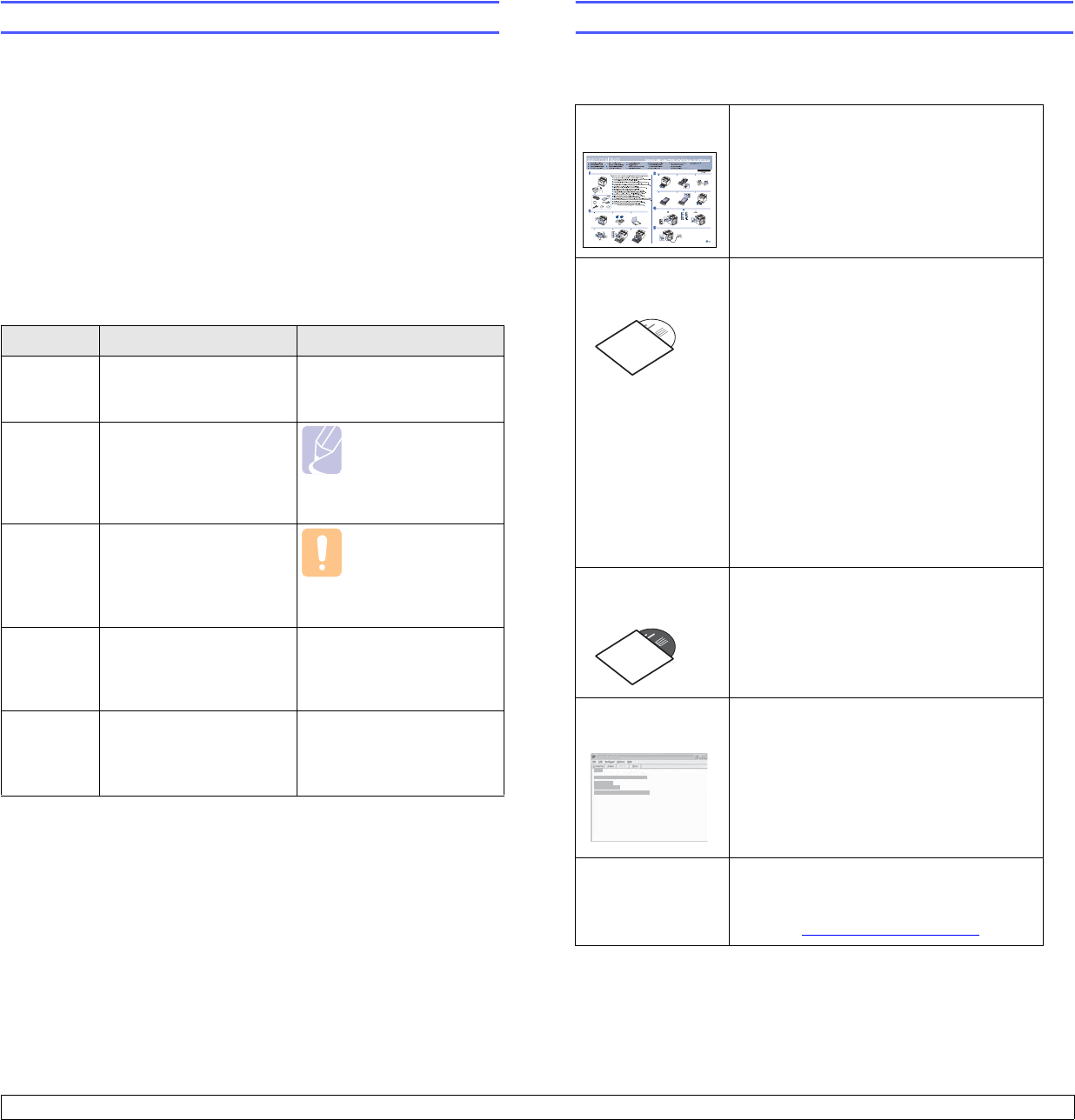
i
About this user’s guide
This user’s guide provides information about basic understanding of the
machine as well as detailed explanation on each step during the actual
usage. Both novice users and professional users can refer to this guide for
installing and using the machine.
This explanation is mainly based on the Microsoft Windows operating
system.
Some terms in this guide are used interchangeably, as below.
• Document is synonymous with original.
• Paper is synonymous with media, or print media.
• The model name such as CLP-6xx Series is synonymous with the
machine.
The following table offers the conventions of this guide.
Convention Description Example
Bold Used for texts on the
display or actual prints on
the machine.
Start
Note Used to provide
additional information or
detailed specification of
the machine function and
feature.
Note
The date format
may differ from
country to country.
Caution Used to give users
information to protect the
machine from possible
mechanical damage or
malfunction.
Caution
Do not touch the
green underside of
the print cartridge.
Footnote Used to provide more
detailed information on
certain words or a
phrase.
a. pages per minute
(See page
1.1 for
more
information)
Used to guide users to
the reference page for
the additional detailed
information.
(See page 1.1 for more
information)
Finding more information
You can find information for setting up and using your machine from the
following resources, either as a print-out or onscreen.
Quick Install
Guide
Provides information on setting up your
machine and this requires that you follow
the instructions in the guide to prepare the
machine.
Online User’s
Guide
Provides you with step-by-step
instructions for using your machine’s full
features, and contains information for
maintaining your machine,
troubleshooting, and installing
accessories.
This user’s guide also contains
Software
section
to provide you with information on
how to print documents with your machine
in various operating systems, and how to
use the included software utilities.
Note
You can access the user’s guide in other
languages from the Manual folder on the
printer software CD.
Network Printer
User’s Guide
Contained on the
Network Utilities CD
, this
guide provides you with information on
setting up and connecting your machine to
a network.
Printer Driver
Help
Provides you with help information on
printer driver properties and instructions
for setting up the properties for printing. To
access a printer driver help screen, click
Help
from the printer properties dialog
box.
Samsung website If you have Internet access, you can get
help, support, printer drivers, manuals,
and order information from the Samsung
website, www.samsungprinter.com.

ii
Safety and Regulatory Information
Important Precautions and Safety Information
When using this machine, these basic safety precautions should always be
followed to reduce risk of fire, electric shock, and injury to people:
1 Read and understand all instructions.
2 Use common sense whenever operating electrical appliances.
3 Follow all warnings and instructions marked on the machine and in the
literature accompanying the machine.
4 If an operating instruction appears to conflict with safety information,
heed the safety information. You may have misunderstood the
operating instruction. If you cannot resolve the conflict, contact your
sales or service representative for assistance.
5 Unplug the machine from the AC wall socket before cleaning. Do not
use liquid or aerosol cleaners. Use only a damp cloth for cleaning.
6 Do not place the machine on an unstable cart, stand or table. It may fall,
causing serious damage.
7 Your machine should never be placed on, near or over a radiator,
heater, air conditioner or ventilation duct.
8 Do not allow anything to rest on the power cable. Do not locate your
machine where the cords will be abused by persons walking on them.
9 Do not overload wall outlets and extension cords. This can diminish
performance, and may result in the risk of fire or electric shock.
10 Do not allow pets to chew on the AC power or PC interface cords.
11 Never push objects of any kind into the machine through case or
cabinet openings. They may touch dangerous voltage points, creating a
risk of fire or shock. Never spill liquid of any kind onto or into the
machine.
12 To reduce the risk of electric shock, do not disassemble the machine.
Take it to a qualified service technician when repair work is required.
Opening or removing covers may expose you to dangerous voltages or
other risks. Incorrect reassembly could cause electric shock when the
unit is subsequently used.
13 Unplug the machine from the PC and AC wall outlet, and refer servicing
to qualified service personnel under the following conditions:
• When any part of the power cord, plug, or connecting cable is
damaged or frayed.
• If liquid has been spilled into the machine.
• If the machine has been exposed to rain or water.
• If the machine does not operate properly after instructions have been
followed.
• If the machine has been dropped, or the cabinet appears damaged.
• If the machine exhibits a sudden and distinct change in performance.
14 Adjust only those controls covered by the operating instructions.
Improper adjustment of other controls may result in damage, and may
require extensive work by a qualified service technician to restore the
machine to normal operation.
15 Avoid using this machine during a lightning storm. There may be a
remote risk of electric shock from lightning. If possible, unplug the AC
power for the duration of the lightning storm.
16 If you continuously print multiple pages, the surface of the output tray
may become hot. Be careful not to touch the surface, and keep children
away from the surface.
17 The Power cord supplied with your machine should be used for safe
operation. If you are using a cord which is longer than 2 m with 110 V
machine, then it should be 16 AWG
1
or bigger.
18 SAVE THESE INSTRUCTIONS.
Environmental and Safety Consideration
Laser Safety Statement
The printer is certified in the U.S. to conform to the requirements of DHHS 21
CFR, chapter 1 Subchapter J for Class I(1) laser products, and elsewhere, is
certified as a Class I laser product conforming to the requirements of IEC 825.
Class I laser products are not considered to be hazardous. The laser system
and printer are designed so there is never any human access to laser
radiation above a Class I level during normal operation, user maintenance, or
prescribed service condition.
Warning
Never operate or service the printer with the protective cover removed from
Laser/Scanner assembly. The reflected beam, although invisible, can
damage your eyes.
1 AWG: American Wire Gauge
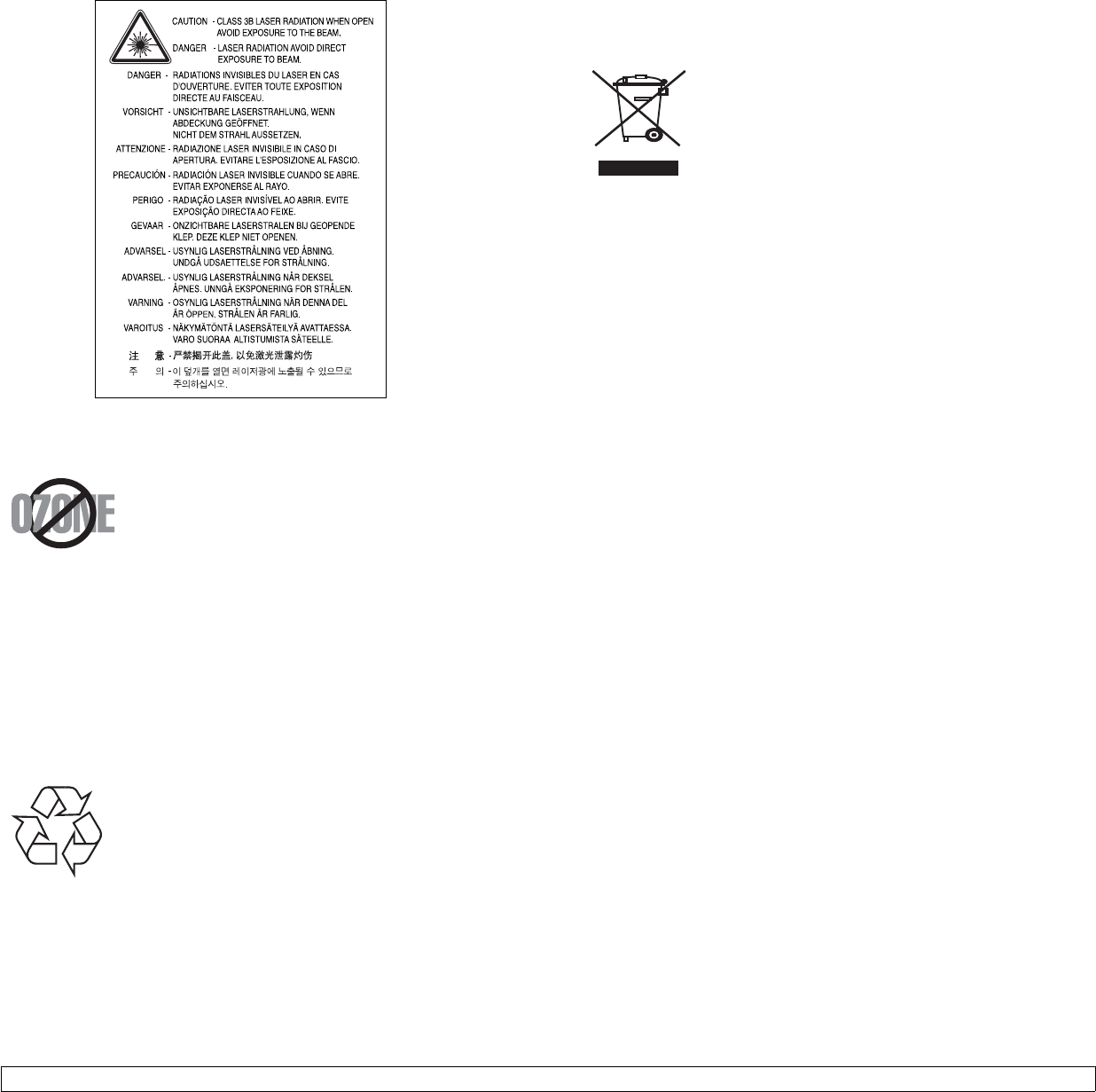
iii
When using this product, these basic safety precautions should always be
followed to reduce risk of fire, electric shock, and injury to persons:
Ozone Safety
During normal operation, this machine produces ozone.
The ozone produced does not present a hazard to the
operator. However, it is advisable that the machine be
operated in a well ventilated area.
If you need additional information about ozone, please
contact your nearest Samsung dealer.
Power Saver
This printer contains advanced energy conservation technology that reduces
power consumption when it is not in active use.
When the printer does not receive data for an extended period of time, power
consumption is automatically lowered.
Recycling
Please recycle or dispose of packaging materials for this
product in an environmentally responsible manner.
Correct Disposal of This Product (Waste Electrical
& Electronic Equipment)
(Applicable in the European Union and other European
countries with separate collection systems)
This marking shown on the product or its literature,
indicates that it should not be disposed with other
household wastes at the end of its working life. To prevent
possible harm to the environment or human health from
uncontrolled waste disposal, please separate this from
other types of wastes and recycle it responsibly to promote
the sustainable reuse of material resources.
Household users should contact either the retailer where they purchased this
product, or their local government office, for details of where and how they
can take this item for environmentally safe recycling.
Business users should contact their supplier and check the terms and
conditions of the purchase contract. This product should not be mixed with
other commercial wastes for disposal.
Radio Frequency Emissions
FCC Regulations
This device complies with Part 15 of the FCC Rules. Operation is subject to
the following two conditions:
• This device may not cause harmful interference, and
• This device must accept any interference received, including interference
that may cause undesired operation.
This device has been tested and found to comply with the limits for a Class B
digital device, pursuant to Part 15 of the FCC rules. These limits are designed
to provide reasonable protection against harmful interference in a residential
installation. This equipment generates, uses and can radiate radio frequency
energy and, if not installed and used in accordance with the instructions, may
cause harmful interference to radio communications. However, there is no
guarantee that interference will not occur in a particular installation. If this
equipment does cause harmful interference to radio or television reception,
which can be determined by turning the equipment off and on, the user is
encouraged to try to correct the interference by one or more of the following
measures:
• Reorient or relocate the receiving antenna.
• Increase the separation between the equipment and receiver.
• Connect the equipment into an outlet on a circuit different from that to
which the receiver is connected.
• Consult the dealer or an experienced radio/TV technician for help.
Caution:
Changes or modifications not expressly approved by the manufacturer
responsible for compliance could void the user’s authority to operate the
equipment.

iv
Canadian Radio Interference Regulations
This digital apparatus does not exceed the Class B limits for radio noise
emissions from digital apparatus as set out in the interference-causing
equipment standard entitled “Digital Apparatus”, ICES-003 of the Industry
and Science Canada.
Cet appareil numérique respecte les limites de bruits radioélectriques
applicables aux appareils numériques de Classe B prescrites dans la norme
sur le matériel brouilleur: “Appareils Numériques”, ICES-003 édictée par
l’Industrie et Sciences Canada.
Declaration of Conformity (European Countries)
Approvals and Certifications
The CE marking applied to this product symbolizes
Samsung Electronics Co., Ltd. Declaration of Conformity
with the following applicable 93/68/EEC Directives of the
European Union as of the dates indicated:
January 1, 1995: Council Directive 73/23/EEC Approximation of the laws of
the member states related to low voltage equipment.
January 1, 1996: Council Directive 89/336/EEC (92/31/EEC), approximation
of the laws of the Member States related to electromagnetic compatibility.
March 9, 1999: Council Directive 1999/5/EC on radio equipment and
telecommunications terminal equipment and the mutual recognition of their
conformity.
A full declaration, defining the relevant Directives and referenced standards
can be obtained from your Samsung Electronics Co., Ltd. representative.
Replacing the Fitted Plug (for UK Only)
Important
The mains lead for this machine is fitted with a standard (BS 1363) 13 amp
plug and has a 13 amp fuse. When you change or examine the fuse, you
must re-fit the correct 13 amp fuse. You then need to replace the fuse cover.
If you have lost the fuse cover, do not use the plug until you have another fuse
cover.
Please contact the people from you purchased the machine.
The 13 amp plug is the most widely used type in the UK and should be
suitable. However, some buildings (mainly old ones) do not have normal 13
amp plug sockets. You need to buy a suitable plug adaptor. Do not remove
the moulded plug.
Warning
If you cut off the moulded plug, get rid of it straight away.
You cannot rewire the plug and you may receive an electric shock if you
plug it into a socket.
Important warning:
You must earth this machine.
The wires in the mains lead have the following color code:
• Green and Yellow: Earth
• Blue: Neutral
• Brown: Live
If the wires in the mains lead do not match the colors marked in your plug, do
the following:
You must connect the green and yellow wire to the pin marked by the letter
“E” or by the safety ‘Earth symbol’ or colored green and yellow or green.
You must connect the blue wire to the pin which is marked with the letter “N”
or colored black.
You must connect the brown wire to the pin which is marked with the letter “L”
or colored red.
You must have a 13 amp fuse in the plug, adaptor, or at the distribution board.
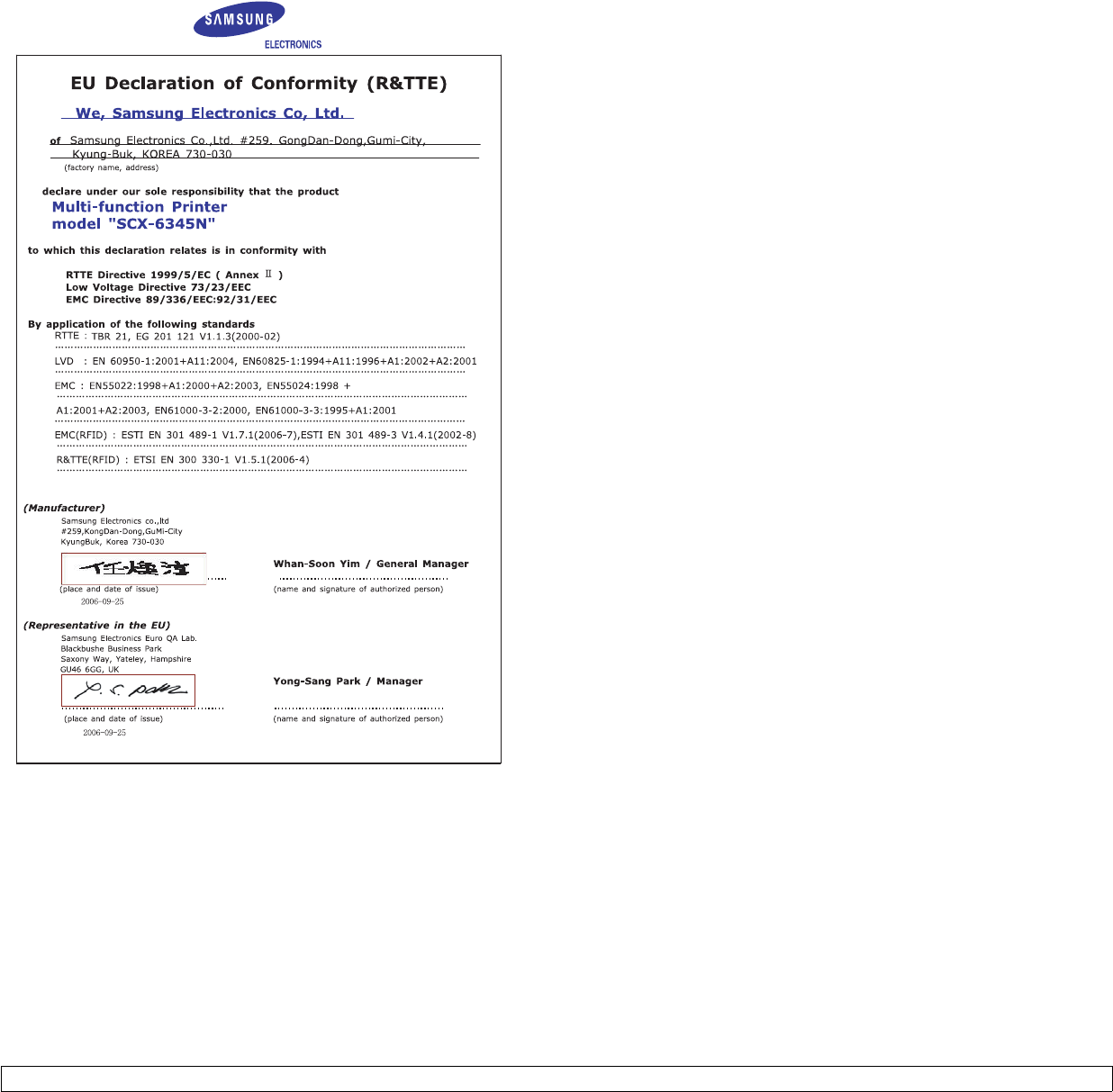
v
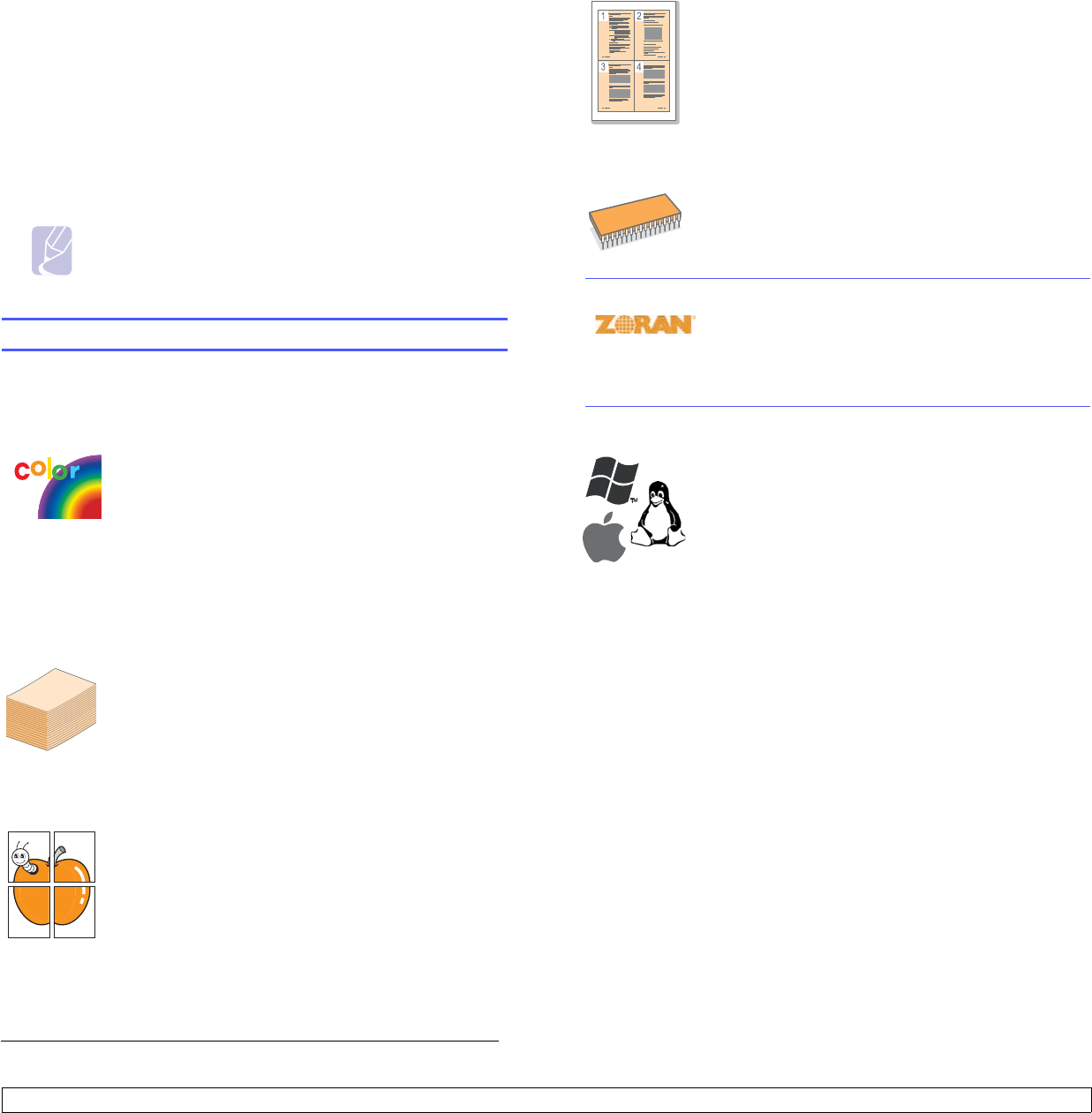
1.1 <
Introduction>
1 Introduction
Thank you for purchasing this Samsung color printer.
This chapter includes:
• Special features
• Machine overview
• Control panel overview
• Understanding the Status LED
• Understanding the menu map
Note
Some features are optional. Please check the specifications
sections. (See "Specifications" on page 10.1.)
Special features
Your new machine is equipped with special features.
Print with excellent quality and speed
• You can print in a full range of colors using cyan,
magenta, yellow, and black.
• You can print with a resolution of up to 2400 x 600 dpi.
See
Software section
.
• Your machine prints A4-sized paper at up to 20 ppma
(CLP-610 series), 24 ppm (CLP-660 series) and letter-
sized paper at up to 21 ppm (CLP-610 series), 25 ppm
(CLP-660 series).
• For double-sided printing, which is supported in CLP-
610ND and CLP-660ND, you can print A4-sized paper
at up to 9 ipmb and letter-sized paper at up to 12 ipm.
Handle different paper options with flexibility
•The multi-purpose tray supports letterhead,
envelopes, labels, custom-sized media, postcards, and
heavy paper. The multi-purpose tray holds up to 100
sheets of plain paper for the CLP-610ND and CLP-660
series.
•The 250-sheet tray 1 and 500-sheet optional tray
support plain paper in various sizes.
Create professional documents
•Print Watermarks. You can customize your documents
with words, such as “Confidential”. See
Software
section
.
•Print Posters. The text and pictures of each page of
your document are magnified and printed across the
sheet of paper and can then be taped together to form
a poster. See
Software section
.
• You can use preprinted forms and letterhead with plain
paper. See
Software section
.
Save time and money
Expand your machine’s capacity
* Zoran IPS Emulation compatible with PostScript 3
© Copyright 1995-2005, Zoran Corporation. All rights
reserved. Zoran, the Zoran logo, IPS/PS3, and
OneImage are trademarks of Zoran Corporation.
* 136 PS3 fonts
Contains UFST and MicroType from Monotype Imaging Inc.
Print in various environments
• To save paper, you can print multiple pages on one
single sheet of paper.
• This machine automatically conserves electricity by
substantially reducing power consumption when not in
use.
• To save paper, you can print on both sides of the paper
(double-sided printing). This feature is supported
depending on the models. See
Software section
.
• Your machine has an extra memory slot to expand their
memory. (Page 8.1)
• Zoran IPS Emulation* compatible with PostScript 3
Emulation* (PS) enables PS printing.
• You can print with Windows 2000/XP/2003/Vista as
well as Linux and Macintosh systems.
• Your machine is equipped with a USB interface and a
network interface.
a. pages per minute
b. images per minute
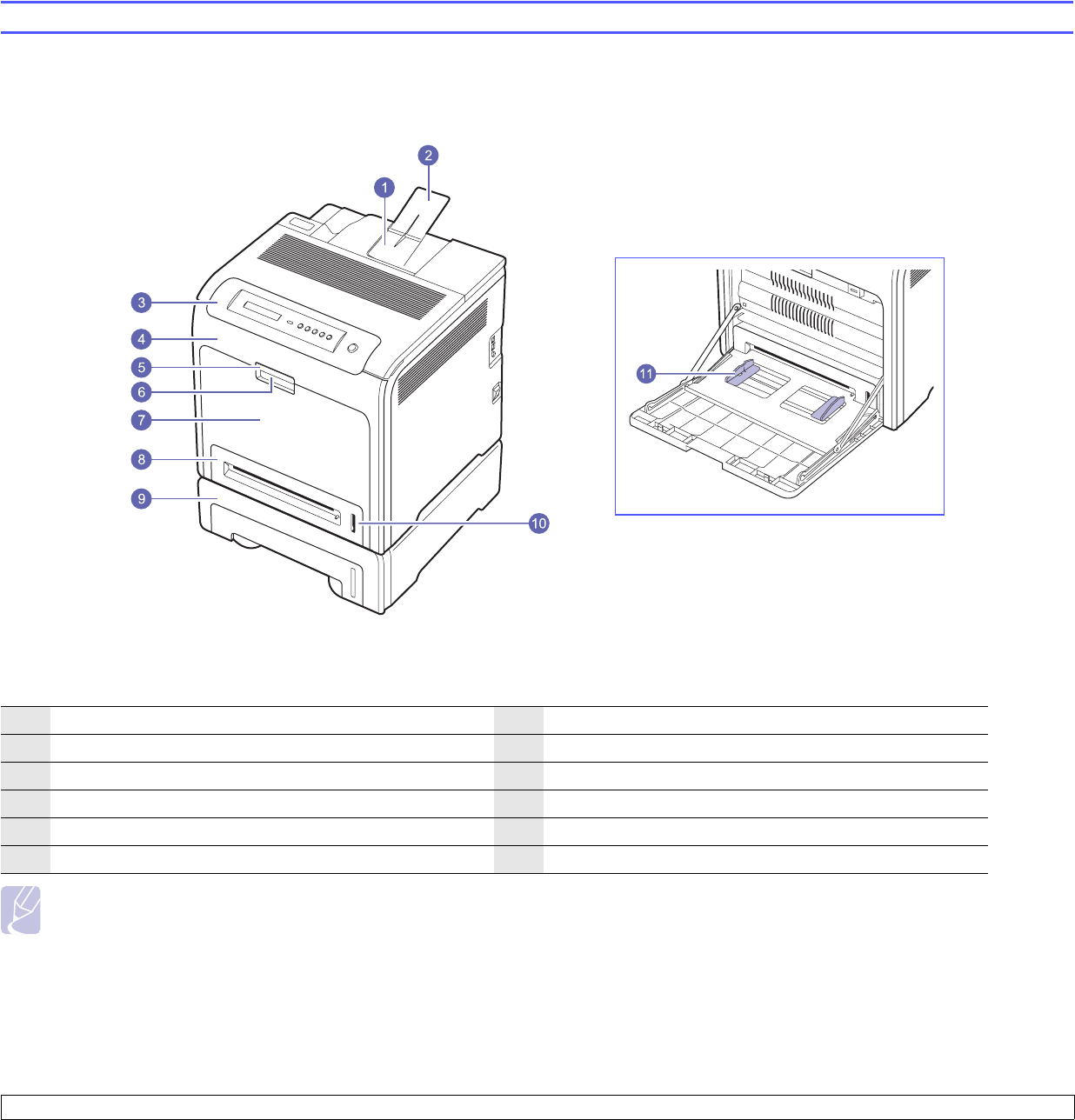
1.2 <
Introduction>
Machine overview
These are the main components of your machine.
Front view
• The figure above shows your machine with the available accessories. (See page 8.1 for more information)
• The symbol *denotes an optional device.
Note
• All illustrations on this user’s guide may differ from your machine depending on its options or models.
• The surface of the output tray may become hot if you print a large number of pages at once. Please make sure that you do not touch the surface,
and do not allow children near it.
1
output tray
7
multi-purpose tray
2
output support
8
tray 1
3
control panel
9
optional tray*
4
front cover 10 paper level indicator
5
front cover handle 11 multi-purpose tray paper width guides
6
multi-purpose tray handle
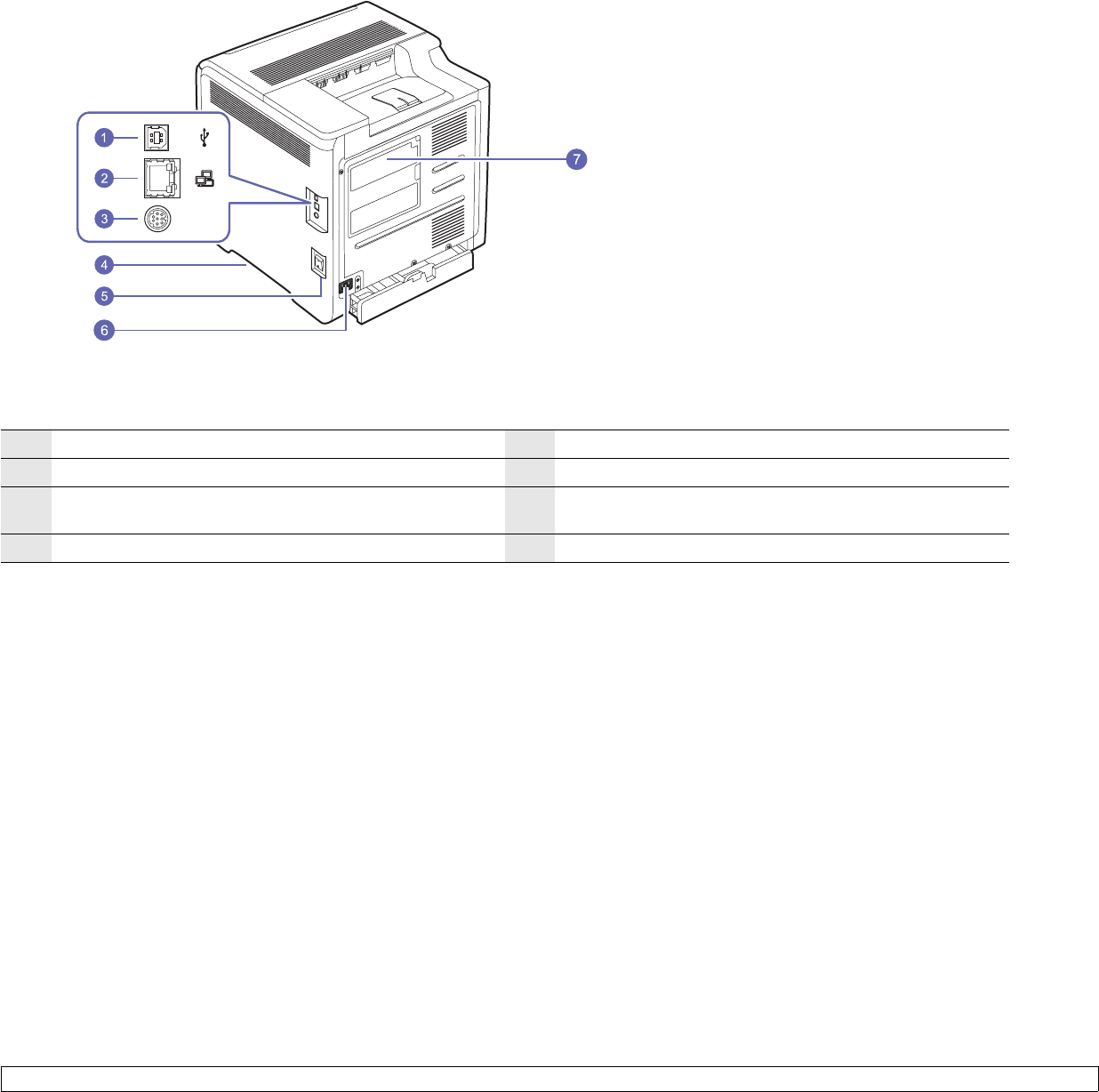
1.3 <
Introduction>
Rear view
• The figure above shows your machine with the available accessories.
• The symbol * denotes an optional device.
1USB port 5power switch
2network port 6power receptacle
315-pin Optional tray connection* 7control board cover (Memory module, see page 9.1 for
more information)
4handle (Use these handles to move your machine.)
TRAY2
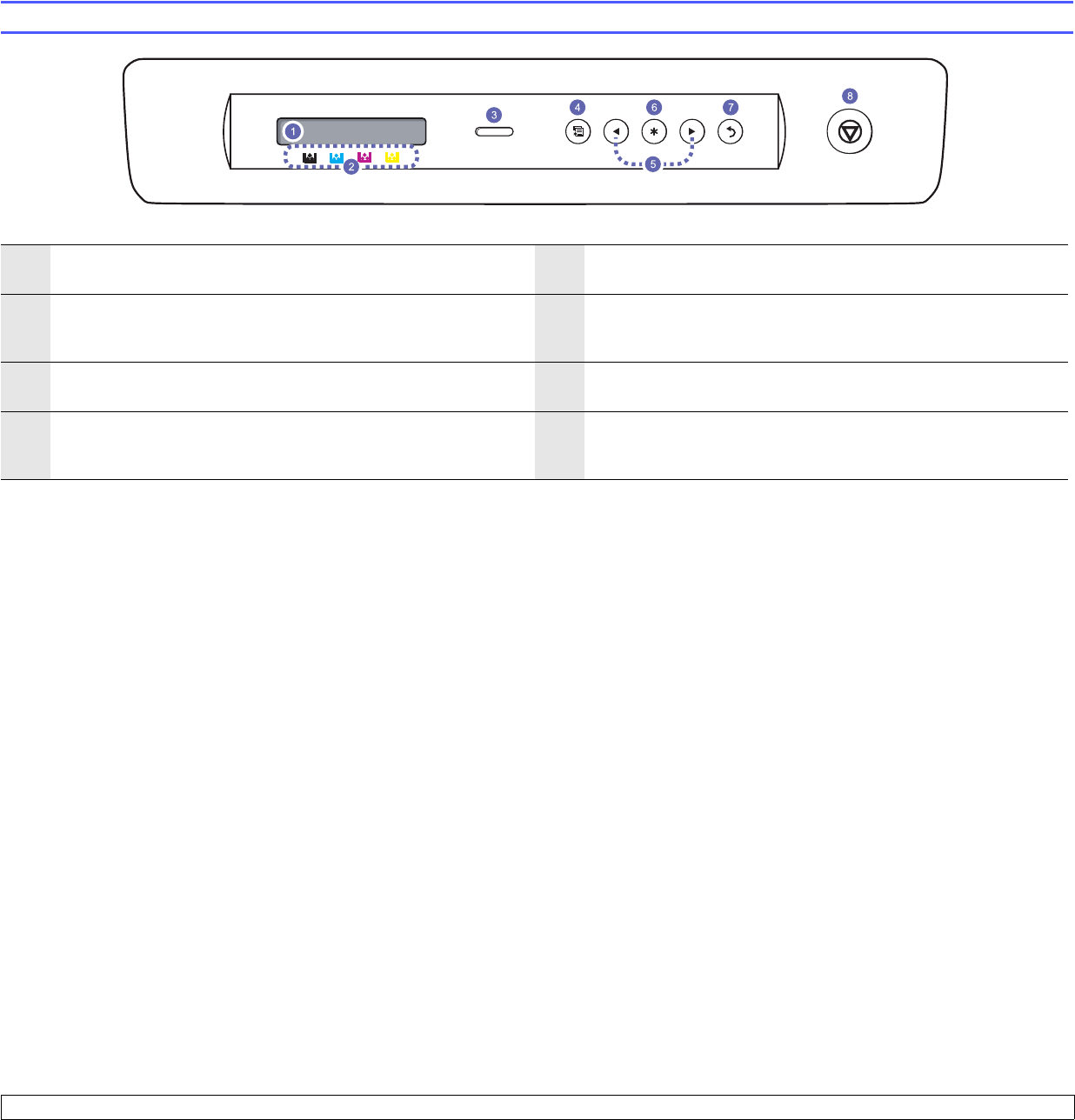
1.4 <
Introduction>
Control panel overview
1Display: Shows the current status and prompts during an
operation.
5Left/right arrow: Navigates available values by moving to the next
or previous options.
2Toner colors: The toner colors shown below the LCD display work
together with display messages. See Status LED with the print
cartridge messages on page 1.5.
6OK: Confirms the selection on the display.
3
Status
: Shows the status of your machine. (See "Understanding the
Status LED" on page 1.5 for more information.)
7Back: Sends you back to the upper menu level.
4Menu: Enters Menu mode and scrolls through the available menus.
(See "Understanding the Status LED" on page 1.5 for more
information.)
8Stop: Stops an operation at any time.
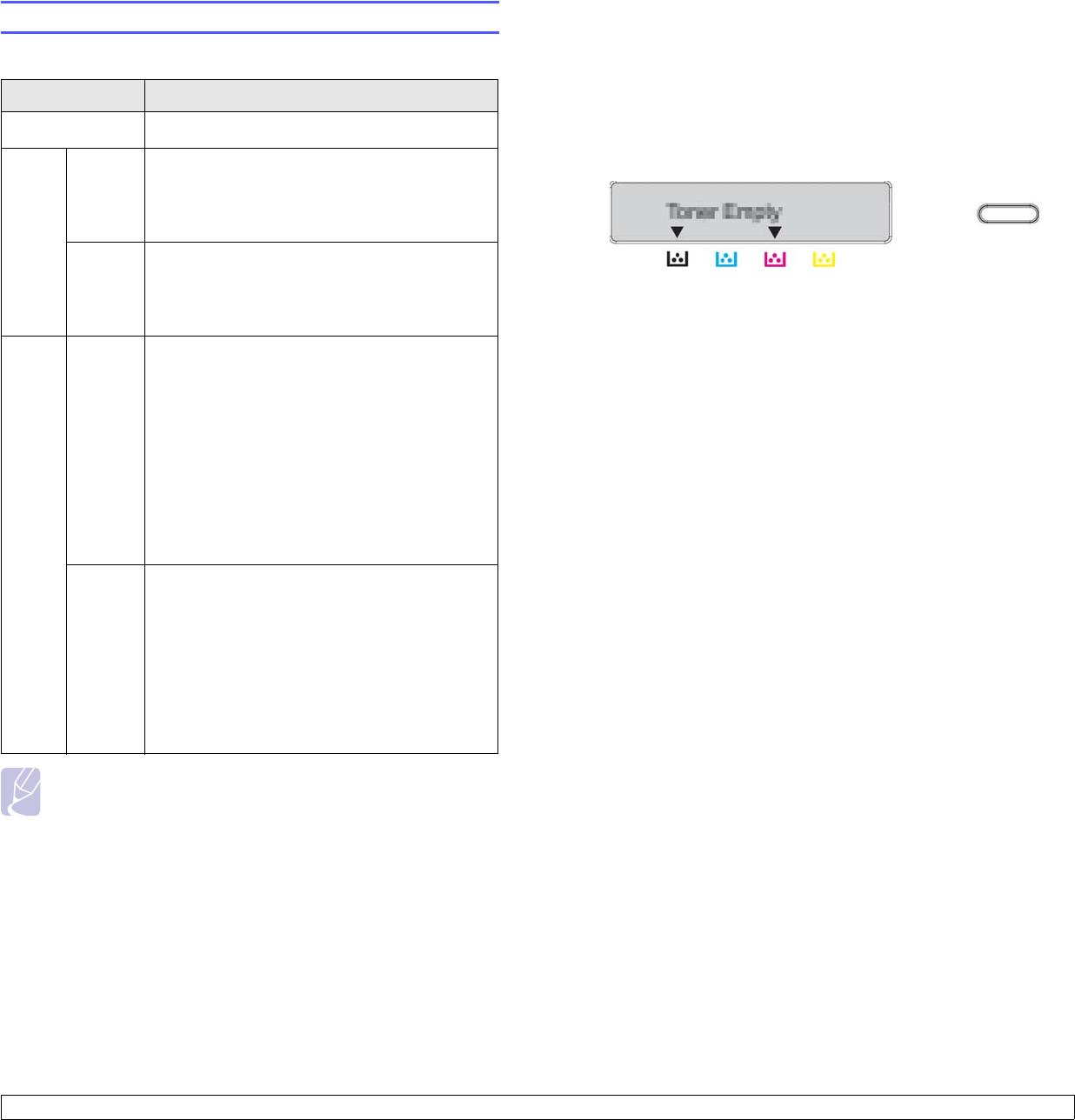
1.5 <
Introduction>
Understanding the Status LED
The color of the Status LED indicates the machine's current status.
Note
Always check the message on the display to solve the problem.
The instruction in the Troubleshooting section will guide you to
operate the machine properly. See page 7.1 for more
information.
Status Description
Off • The machine is powered off.
Green Blinking • When the backlight slowly blinks, the machine
is receiving data from the computer.
• When the backlight blinks rapidly, the machine
is printing data.
On • The machine is powered on and can be used.
• The machine is in power save mode. When
data is received, or any button is pressed, it
switches to the ready mode automatically.
Red Blinking • A minor error has occurred and the machine
is waiting for the error to be cleared. Check
the display message, and solve the problem
referring to "Understanding display
messages" on page 7.7.
• The print cartridge is low. Order a new print
cartridge, see "Ordering supplies and
accessories" on page 8.1. You can
temporarily improve print quality by
redistributing the toner. See "Replacing the
print cartridge" on page 6.4.
On • A problem has occurred such as a paper jam,
opened cover or no paper in the tray, so that
the machine can not continue the job. Check
the message on the display, and refer to
Understanding display messages on page 7.7
to solve the problem.
• The print cartridge is low, empty, or needs to
be changed. See "Understanding display
messages" on page 7.7.
Status LED with the print cartridge messages
The status of print cartridges is indicated by the status LED and the LCD
display. If the print cartridge is low or needs to be changed, the status
LED turns red and the display shows the message. However the arrow
mark (or marks) shows which color toner is of concern or may be installed
with a new cartridge.
Example:
The above example shows the print cartridges' status of the color shown
by arrows. Check the message to find out what the problem is and how
to solve it. See page 7.7 to browse the detailed information on error
messages.
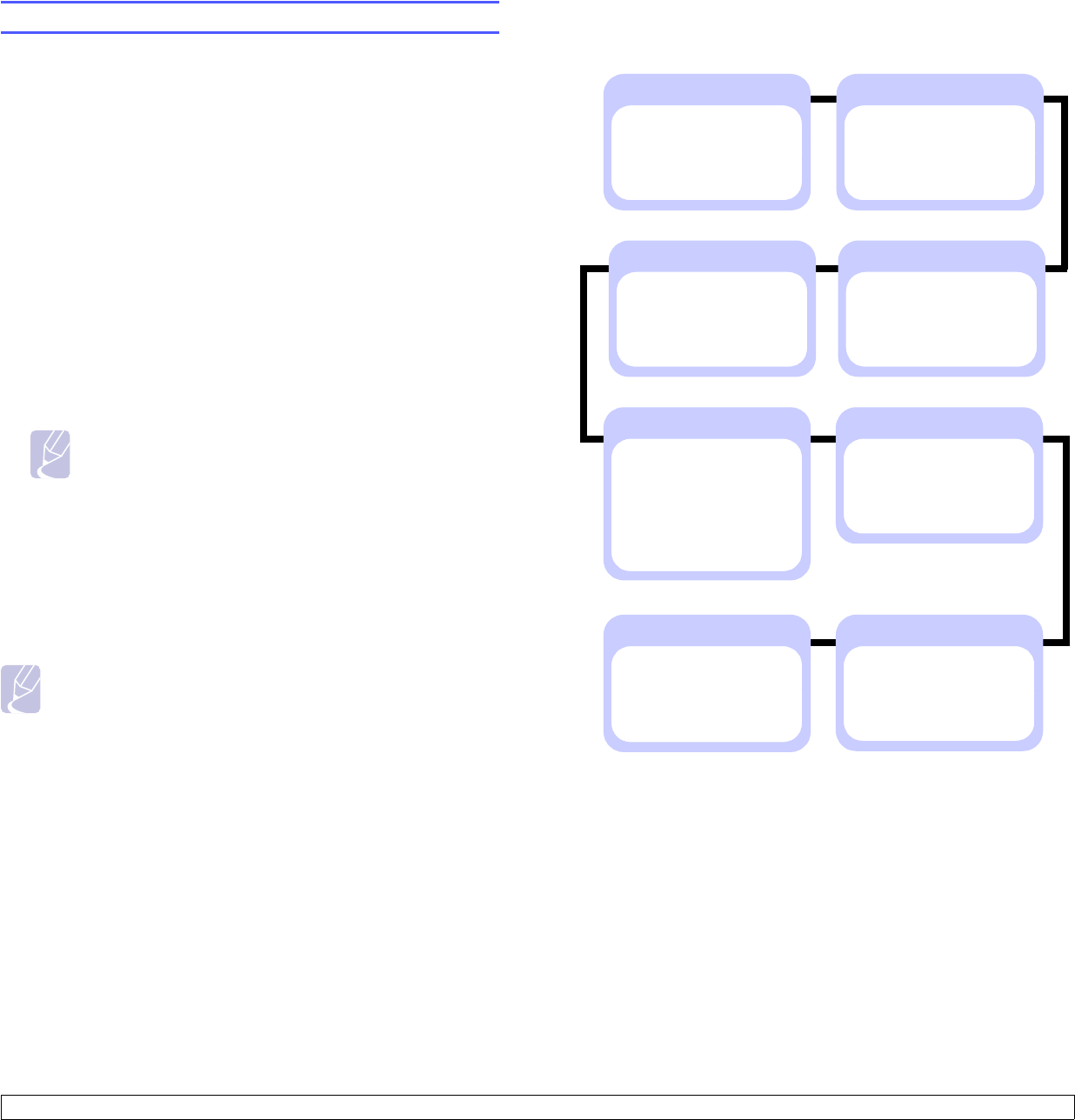
1.6 <
Introduction>
Understanding the menu map
The control panel provides access to various menus to set up the
machine or to use the machine's functions. Refer to the following
diagram.
Accessing menus
The next steps show how to print the menu map of this machine, and they
are the general way to select menus and configure your machine.
1Make sure your machine is properly connected with all the
necessary cables, and turn on the machine.
2Press Menu on the control panel, until you see the menu (ex.
1.Information) you want on the bottom line of the display.
3Press OK to access the menu.
4Press left/right arrow until the menu item (ex. Menu Map) you want
displays on the bottom line.
5Press the OK button to confirm the selected item.
Note
If the menu item has sub menus, repeat steps 4 and 5.
6Press left/right arrow until the menu item (ex. Print?) you want
displays on the bottom line.
7Press OK to process your selection, save your input or selection.
An asterisk (*) appears next to the selection on the display,
indicating that it is now the default.
8To exit the menu, press Back repeatedly, or Stop.
Note
• If no key is pressed within 1 minute, the machine automatically
returns to ready mode.
• The print settings made from the printer driver on a connected
computer override the settings on the control panel.
Menu overview
1.Information
Menu Map
Configuration
Demo Page
PCL Font List
PS Font List
2.Layout
Orientation
Simplex Margin
Duplex
Duplex Margin
5.System Setup
Language
Power Save
Auto Continue
Altitude Adj.
Auto CR
Job Timeout
Maintenance
Clear Setting
6.Emulation
Emulation Type
Setup
8.Network
TCP/IP
Ethernet Speed
Clear Setting
Network Info.
7.Color
Custom Color
Auto Color Reg.
3.Graphic
Resolution
4.Paper
Copies
Paper Size
Paper Type
Paper Source
Tray Chaining
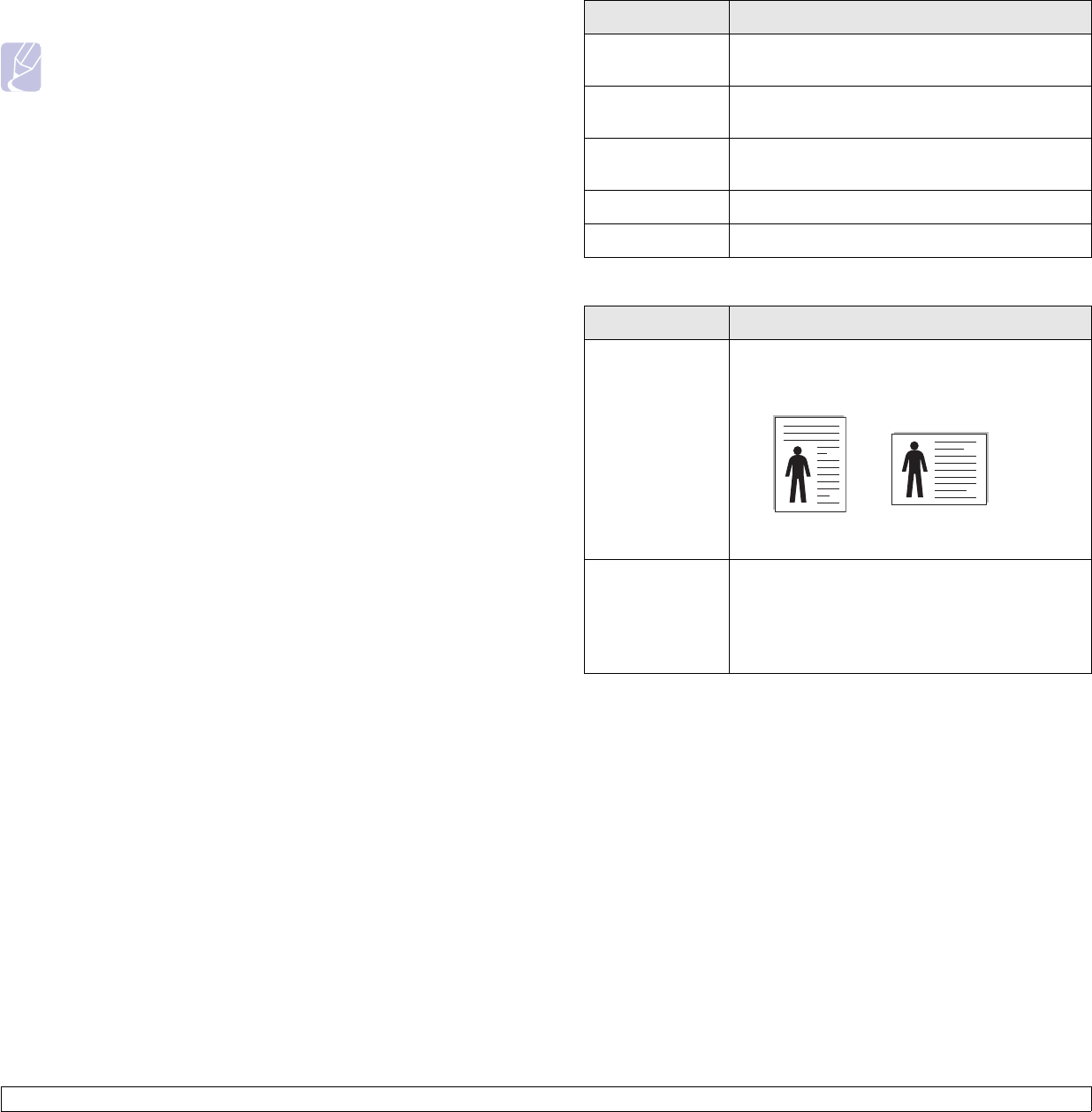
1.7 <
Introduction>
Description on each menu
The following tables provide the information on each menu.
Note
The symbol * denotes an optional menu depending on
machines.
1.Information
2.Layout
Menu Description
Menu Map You can print the menu map which shows the
layout and current settings of this machine.
Configuration You can print the machine's current
configuration.
Demo Page You can print the demo page whether your
machine is printing properly or not.
PCL Font List* You can print the PCL font list.
PS Font List* You can print the PS font list.
Menu Description
Orientation This menu allows you to select the direction in
which information is printed on a page.
Landscape and Portrait are selectable.
Simplex Margin Set the margin of print materials for one-sided
printing. You can increase or decrease the value
in 0.1 mm increments.
•Top Margin: Set the top margin.
•Left Margin: Set the left margin.
LandscapePortrait

1.8 <
Introduction>
3.Graphic
Duplex* To print on both sides of paper, choose the
binding edge as follows.
•Long Edge: Flip on the long edge.
•Short Edge: Flip on the short edge.
Select Off to print on one side of the paper.
Duplex Margin* In this menu, you can set the margins for double-
sided printing. You can increase or decrease the
value in 0.1 mm increments.
•Top Margin: Set the top margin.
•Left Margin: Set the left margin.
•Short Binding: Set the bottom margin of the
back of the page for short binding.
•Long Binding: Set the right margin of the
back of the page for long binding.
Menu Description
Resolution You can select the default resolution. If the
resolution is high, the clarity of the printouts is
sharper, but the print time may take longer.
Menu Description
Long Edge in the
Landscape orientation
Long Edge in the
Portrait orientation
Short Edge in the
Landscape orientation
Short Edge in the
Portrait orientation
4.Paper
5.System Setup
Menu Description
Copies You can select the maximum amount of copies.
Paper Size You can select the default paper size. (See page
3.5 for more information)
Paper Type You can select the default paper type for the
print media.
Paper Source You can select the tray to process the print job. If
you select Auto, your machine supplies the
paper from the multi-purpose tray first, than the
tray 1, and tray 2 for the last. So if any tray is
empty, then the machine try to search the paper
from the next available tray. (See page 3.5 for
more information)
Tray Chaining When you select any other value except Auto
from Paper Source and the selected tray is
empty, you can set the machine to automatically
print from other trays.
If this menu item is set to Off, the machine does
not work until you insert paper into the specified
tray.
Menu Description
Language The language setting for the display on the
control panel determines the language of the text
that appears on the control panel display and for
printing information. (See page 3.5 for more
information)
Power Save When the machine does not receive data for an
extended period of time, power consumption is
automatically lowered. You can set how long the
machine waits before going to power save. (See
page 3.5 for more information)
Auto Continue This item determines whether or not the machine
continues printing when it detects paper that is
not matched to your paper setting.
•Off: If a paper mismatch occurs, the message
remains on the display and the machine
remains off-line until you insert the correct
paper.
•On: If the paper is mismatched, an error
message displays. The machine goes off-line
for 30 seconds then automatically clears the
message and continues printing.
Altitude Adj. You can optimize the print quality according to
your altitude.
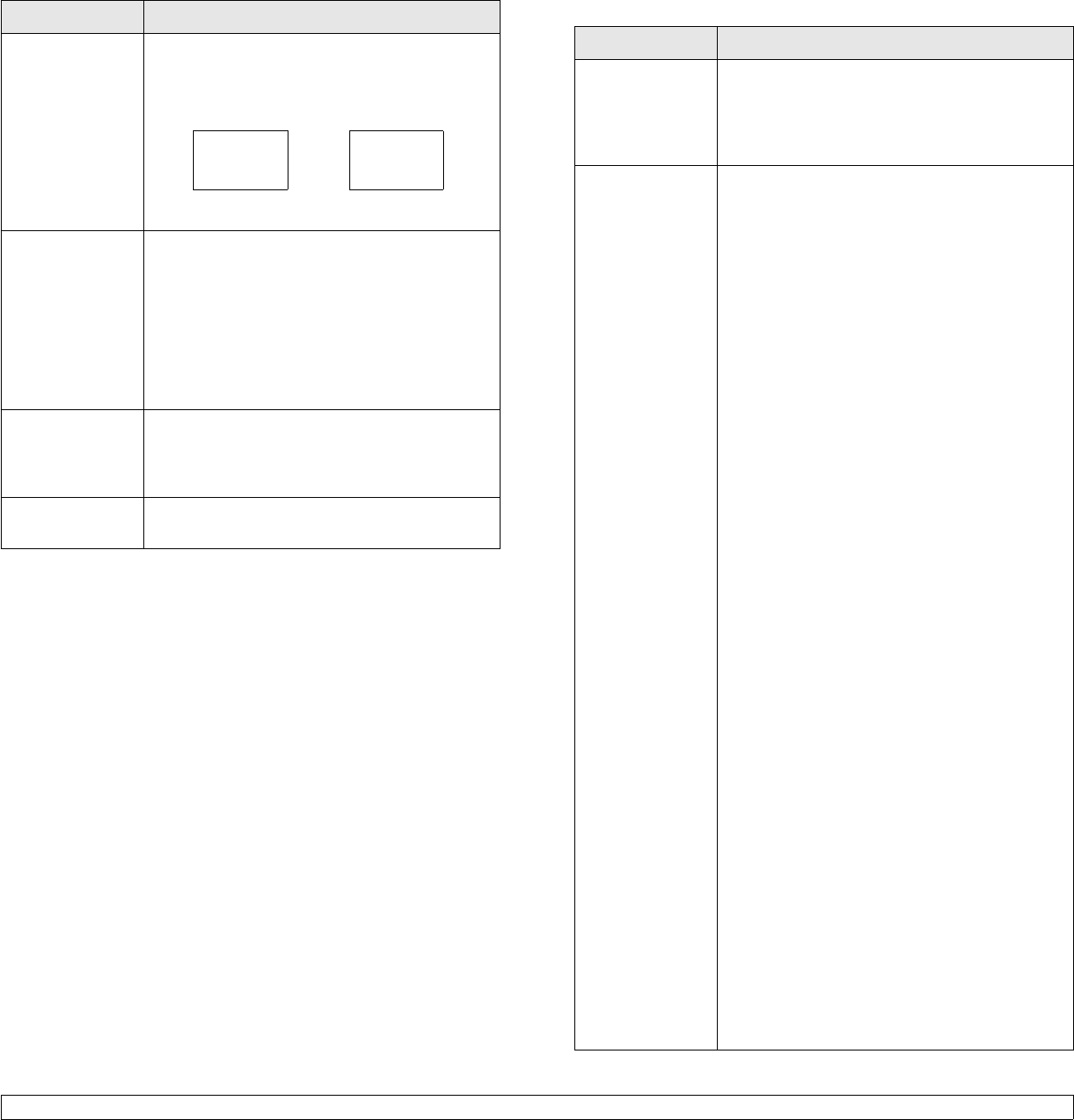
1.9 <
Introduction>
Auto CR This option allows you to append the required
carriage return to each line feed, which is useful
to the Unix user or DOS user.
Refer to the following samples:
Job Timeout You can set the amount of time a single print job
is active before it must print. The machine
handles incoming data as a single job, if it comes
in within the specified time. When an error
occurs while processing data from the computer
and the data flow stops, the machine waits the
specified amount of time and then cancels
printing if data flow does not resume. (See page
3.5 for more information)
Maintenance This menu allows you to maintain consumables
within the machine and check supplies' life. You
can clean fuser components. (See page 6.1 for
more information)
Clear Setting This menu item allows you to restore the
printer's factory default settings.
Menu Description
LF LF+CR
AA
BB
CC
AA
BB
CC
6.Emulation
Menu Description
Emulation Type You can select the machine language. If the
languages from the computer and the machine
are different, the printing quality can not be
confirmed. It is recommended to set this menu to
Auto to switch the proper language.
Setup PCL
This menu sets the PCL emulation configuration.
You can set the font type, symbol type, lines per
page, and font size.
•Typeface: You can select the standard font to
be used in PCL emulation. PCL1~PCL7's
interval between letters is fixed, and
PCL8~PCL45's interval is proportional to the
font type and font size. You can adjust the font
size of PCL1~PCL7 using the Pitch item, and
PCL8~PCL45 can do using Point Size item.
PCL46~PCL54's interval and font size are
fixed.
•Symbol: This item selects the symbol set to
be used in PCL emulation. The symbol is the
group of numbers, marks, and special signs
being used when printing letters. Depending
on the Typeface setting, available symbol sets
vary.
•Point Size: When you select one between
PCL8 and PCL45 from the Typeface menu,
you can determine the font size by setting the
height of the characters in the font.
•Courier: This item lets you select the version
of Courier font to use.
•Pitch: When you select one between PCL1
and PCL7 from the Typeface menu, you can
determine the font size by setting the number
of characters that will print in one horizontal
inch of type. The default value, 10 is the best
size.
•Lines: This item allows you to set vertical
spacing from 5 to 128 lines for the default
paper size. The default number of lines may
differ according to the paper size and printing
orientation.
PostScript
This menu provides you with the Print PS Error
menu item. You can select whether or not your
printer prints an error list when a PS error
occurs. Select On to print PS 3 emulation errors.
If an error occurs, the job stops processing, the
error message prints, and the printer flushes the
job. If this menu is set to Off, the job is flushed
without an indication of the error.
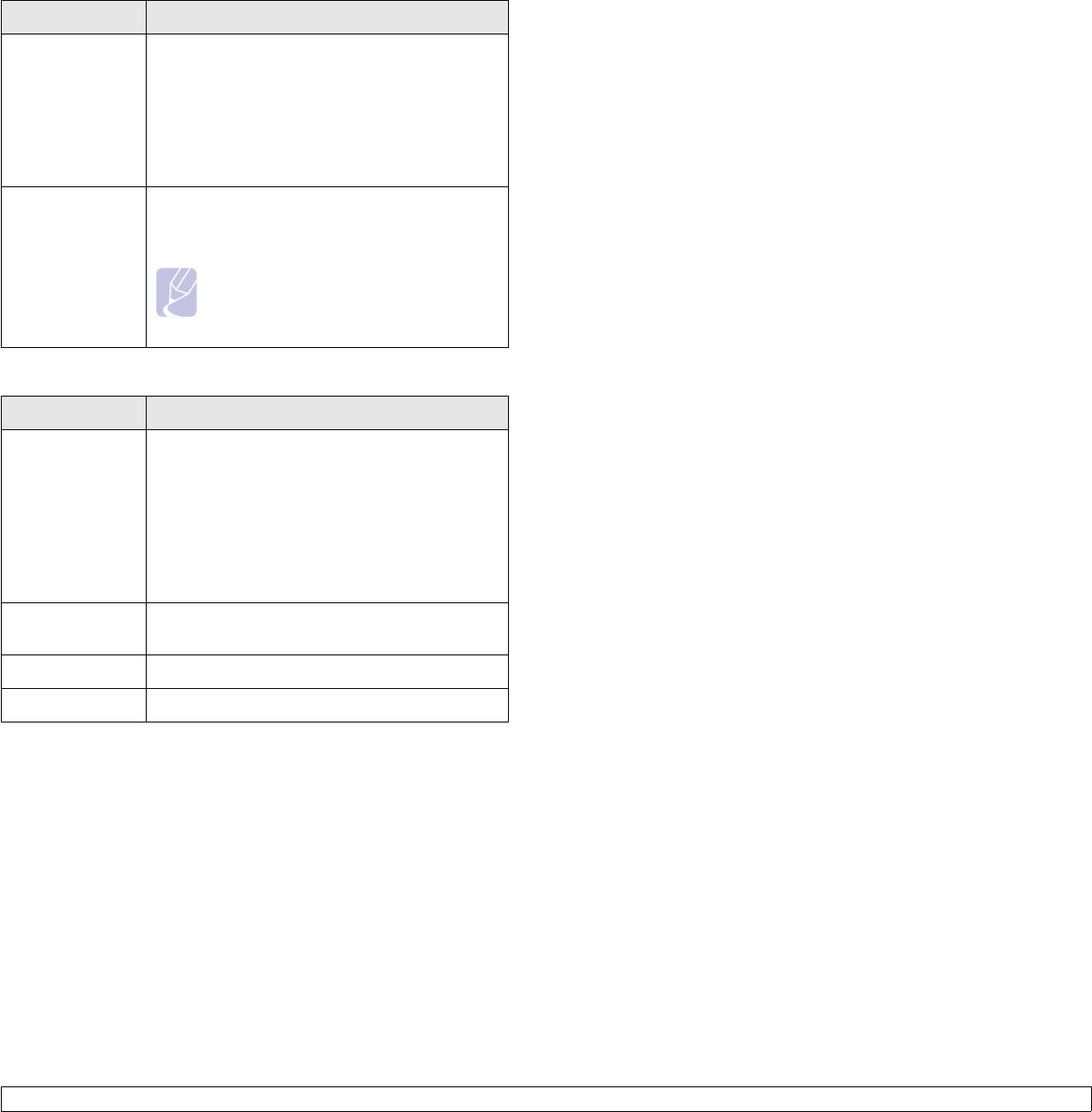
1.10 <
Introduction>
7.Color
8.Network
Menu Description
Custom Color This menu allows you to adjust contrast, color by
color.
•Default: Optimizes colors automatically.
•Manual Adjust: Allows you to manually adjust
the color contrast for each cartridge.
It is recommended to use the Default setting for
best color quality.
Auto Color Reg. You can adjust the position of color texts or
graphics to match the position of the printed
colors to those on your screen.
Note
If you have moved the machine, it is
strongly recommended to operate this
menu manually.
Menu Description
TCP/IP If you are using the TCP/IP protocol for
networking, select this menu.
•DHCP: The DHCP server allots an IP address
to you automatically.
•BOOTP: The BOOTP server allots an IP
address to you automatically.
•Static: You can enter an IP address,
subnetmask, and gateway manually.
Ethernet Speed This item allows you to select the communication
speed for ethernet connection.
Clear Setting You can clear the network setting you have set.
Network Info. You can print the network configuration report.
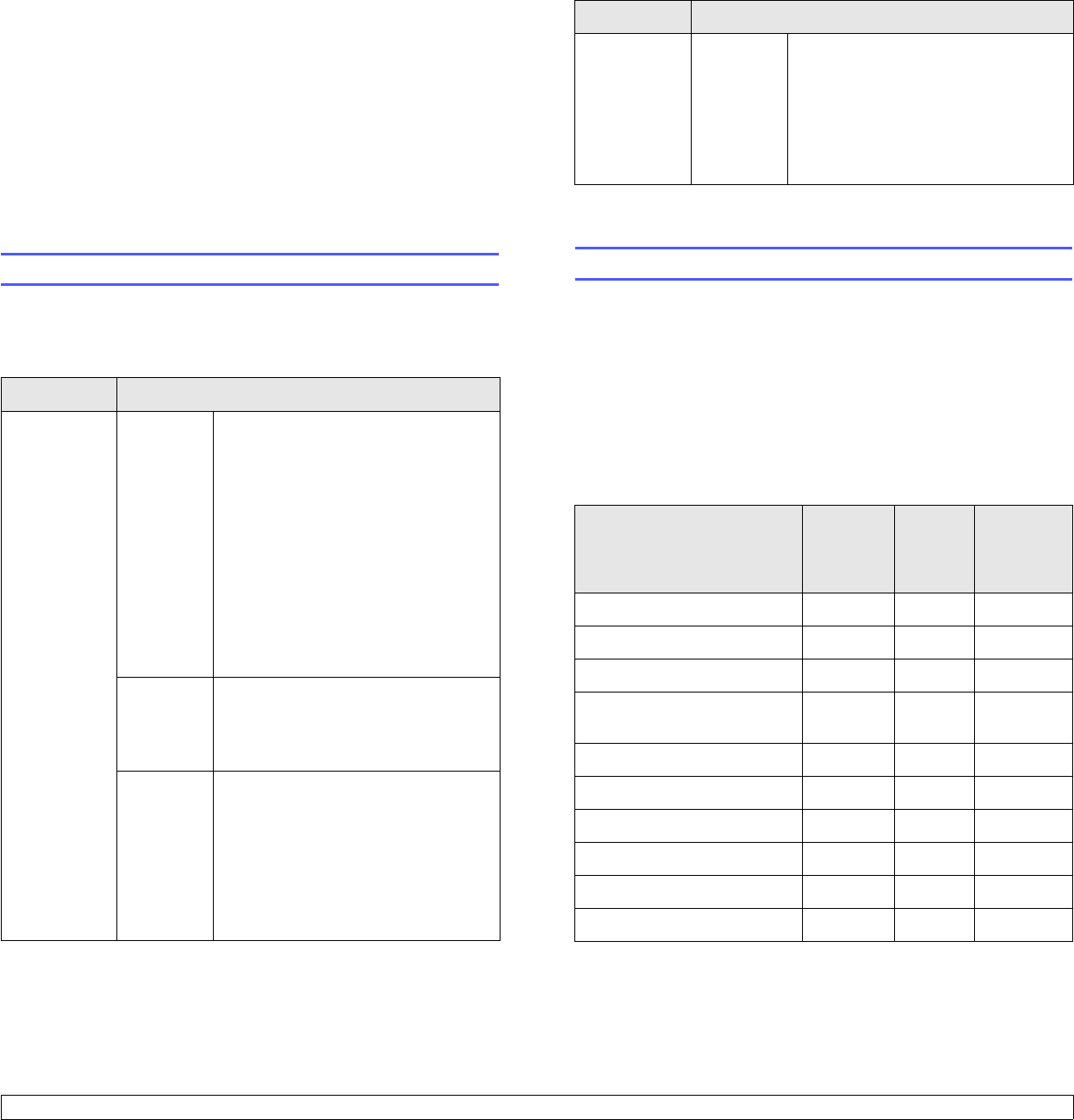
2.1 <
Software overview>
2 Software overview
This chapter gives you an overview of the software that comes with your
machine. Further details on how to use the software are explained in the
Software section
.
This chapter includes:
• Supplied software
• Printer driver features
• System requirements
Supplied software
You must install the machine software using the supplied CDs after you
have set up your machine and connected it to your computer.
Each CD provides you with the following software:
CD Contents
Printer
software CD
Windows • Printer driver: Use this driver to
take full advantage of your
machine’s features.
•PostScript Printer Description
(PPD) filea: Use the PostScript
driver to print documents with
complex fonts and graphics in the
PS language.
•Smart Panel: This program allows
you to monitor the machine’s status
and alerts you when an error occurs
during printing.
• User’s Guide in PDF
Linux • PostScript Printer Descriptiona:
Use this driver to run your machine
from a Linux computer and print
documents.
Macintosh • Postscript Printer Description
(PPD) filea: Use this file to run your
machine from a Macintosh computer
and print documents.
•Smart Panel: This program allows
you to monitor the machine’s status
and alerts you when an error occurs
during printing.
Printer driver features
Your printer drivers support the following standard features:
• Paper source selection
• Paper size, orientation and media type
• Number of copies
In addition, you can use various special printing features. The following
table shows a general overview of features supported by your printer
drivers:
Printer driver
Network
Utilities CD
Windows •
SyncThru™ Web Admin Service
:
Use this web-based program to
remotely manage, monitor, and
troubleshoot network machines.
•
SetIP
: Use this program to set your
machine’s TCP/IP addresses.
• Network Printer User’s Guide in PDF
a. This feature is available with the CLP-660 series only.
Feature Windows Linux
Macintosh
(CLP-610
series
only)
Color mode O O O
Machine quality option O O O
Poster printing O X X
Multiple pages per sheet
(N-up)
O O (2, 4) O (2, 4, 6,
9, 16)
Fit to page printing O X X
Scale printing O X O
Different source for first page O X O
Watermark O X X
Overlay O X X
Duplex O X X
CD Contents
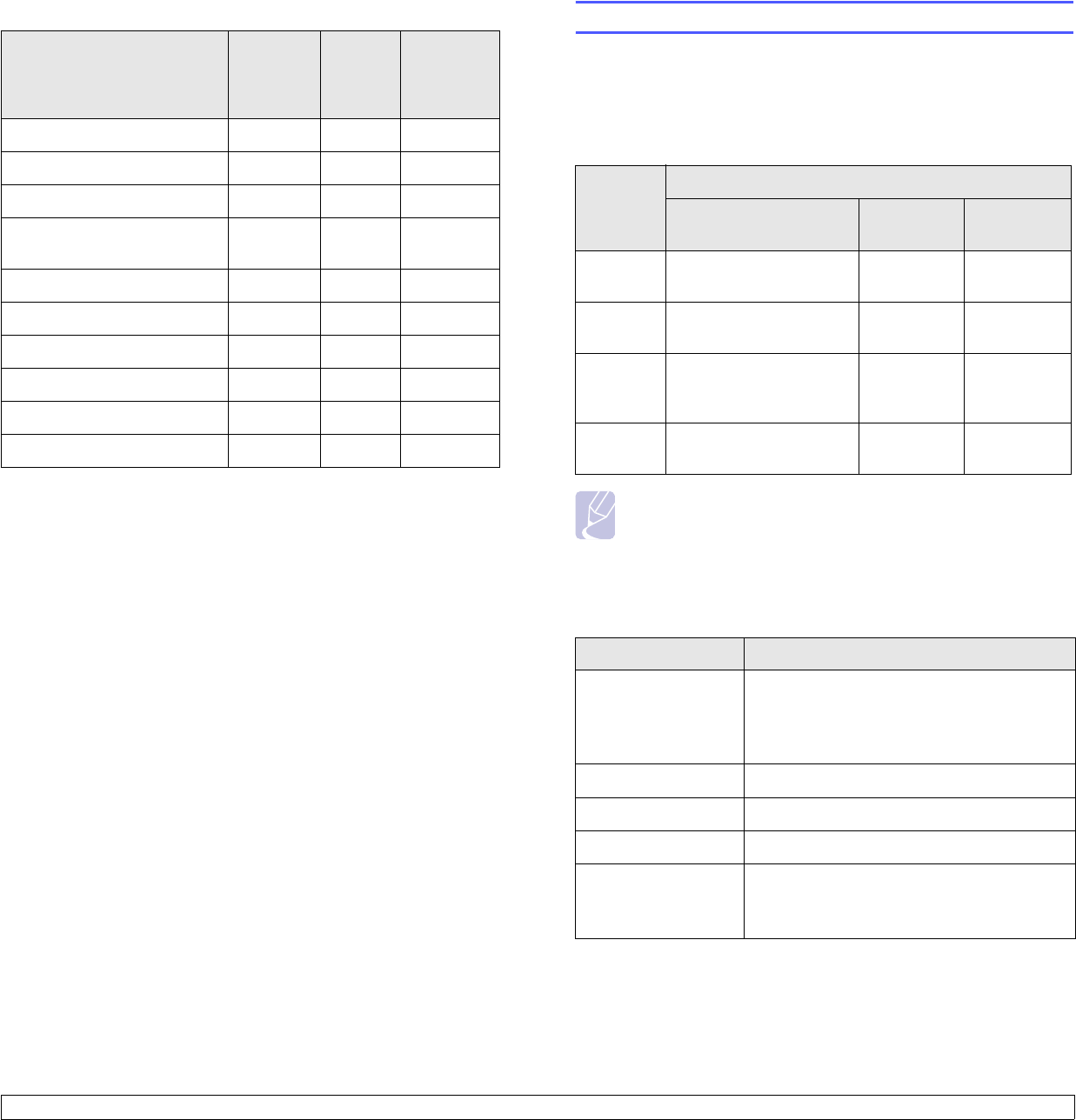
2.2 <
Software overview>
PostScript driver
Feature Windows Linux
Macintosh
(CLP-660
series
only)
Color mode O O O
Machine quality option O O O
Poster printing X X X
Multiple pages per sheet
(N-up)
O O (2, 4) O (2, 4, 6,
9, 16)
Fit to page printing O X X
Scale printing O X O
Different source for first page X X O
Watermark X X X
Overlay X X X
Duplex O X X
System requirements
Before you begin, ensure that your system meets the following
requirements:
Windows
Your machine supports the following Windows operating systems.
Note
• Internet Explorer 5.0 or higher is the minimum requirement for
all Windows operating systems.
• Users who have an administrator right can install the
software.
Linux
OS
Requirement (recommended)
CPU RAM free HDD
space
Windows
2000
Pentium II 400 MHz
(Pentium III 933 MHz)
64 MB
(128 MB)
650 MB
Windows
XP
Pentium III 933 MHz
(Pentium IV 1 GHz)
128 MB
(256 MB)
1.5 GB
Windows
2003
Server
Pentium III 933 MHz
(Pentium IV 1 GHz)
128 MB
(512 MB)
1.25 GB to
2 GB
Windows
Vista
Pentium 4.3 GHz 512 MB
(1024 MB)
15 GB
Item Requirements
Operating system • Red Hat 8 ~ 9
• Fedora Core 1 ~ 4
• Mandrake 9.2 ~ 10.1
• SuSE 8.2 ~ 9.2
CPU Pentium IV 1 GHz or higher
RAM 256 MB or higher
free HDD space 1 GB or higher
Software • Linux Kernel 2.4 or higher
• Glibc 2.2 or higher
• CUPS
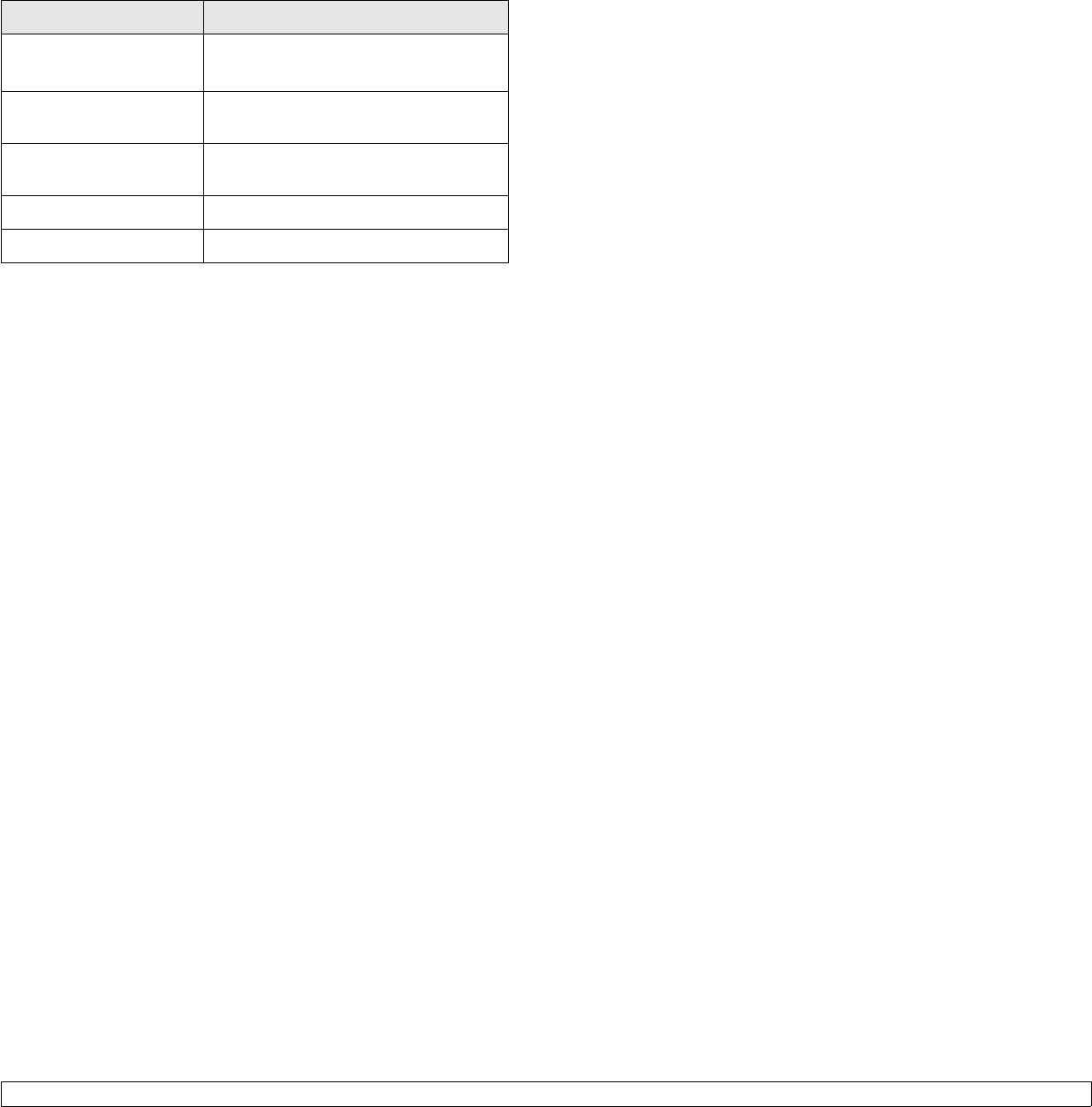
2.3 <
Software overview>
Macintosh
Item Requirements
Operating system Macintosh 10.3 ~ 10.4 (CLP-610 series)
Macintosh 10.1 ~ 10.4 (CLP-660 series)
CPU Intel processor
PowerPC G4 /G5
RAM 512 MB for an Intel-based Mac,
128 MB for a Power-PC based Mac
free HDD space 1 GB
Connection USB interface or Network interface
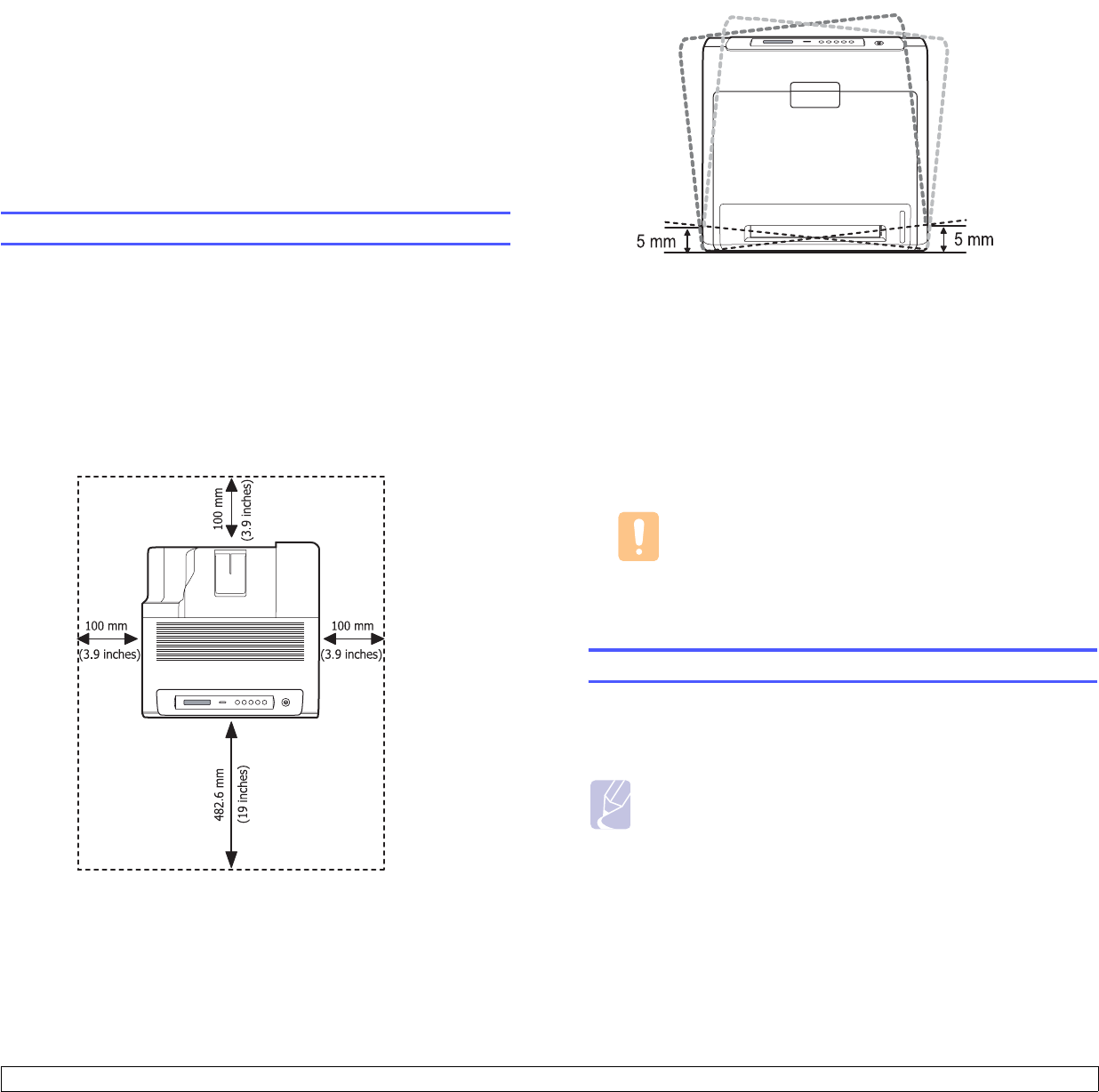
3.1 <
Getting Started>
3 Getting Started
This chapter gives you step-by-step instructions for setting up the
machine.
This chapter includes:
• Setting up the hardware
• Setting up the network
• Installing the software
• Printer's basic settings
Setting up the hardware
This section shows the steps to set up the hardware which is explained
in the Quick Install Guide. Make sure you read Quick Install Guide and
complete following steps.
1Select a stable location.
Select a level, stable place with adequate space for air circulation.
Allow extra space to open covers and trays.
The area should be well-ventilated and away from direct sunlight or
sources of heat, cold, and humidity. Do not set the machine close to
the edge of your desk or table.
Printing is suitable for altitudes under 2,500 m (8,200 ft). Refer to
the altitude setting to optimize your printing. See page 3.4 for more
information.
Place the machine on a flat and stable surface for not letting it tilt
more than 5 mm (0.2 inches). Otherwise, it may affect the printing
quality.
Allow a flat surface area of 5 mm (0.2 inches) to surround all sides.
2Unpack the machine and check all the enclosed items.
3Remove the tape holding the machine tightly.
4Install both the print cartridge.
5Load paper. (See "Loading paper" on page 4.4.)
6Make sure that all the cables are connected to the machine.
7Turn the machine on.
Caution
When you move the machine, do not tilt or turn it upside
down. Otherwise, the inside of the machine may be
contaminated by toner, which can cause damage to the
machine or bad printing quality.
Setting up the network
You need to set up the network protocols on the machine to use it as your
network printer. You can set up the basic network settings with the
machine's touch screen.
Note
• If you want to use the USB cable, connect the cable between a
computer and you machine. Then, refer to the software
installation in Software section.
• For detailed information on network settings, please, refer to
the Network Printer Quick Guide, or the on-line user's guide on
the Network Utilities CD.
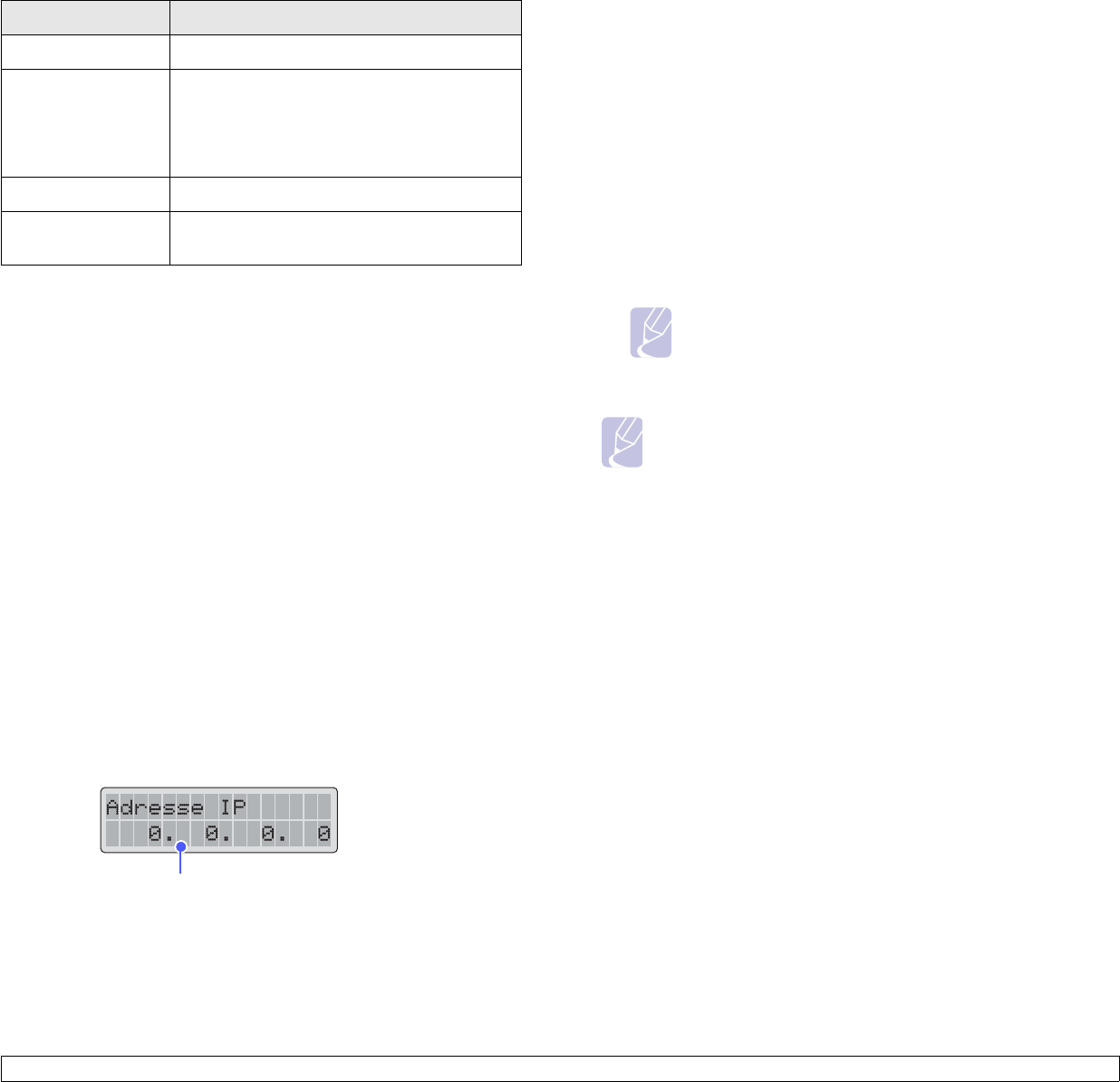
3.2 <
Getting Started>
Supported operating systems
The following table shows the network environments supported by the
machine:
Configuring network protocol via the machine
You can set up TCP/IP Network parameters, please follow the steps listed
below.
1Make sure your machine is connected to the network with an RJ-45
Ethernet cable.
2Make sure you have turned on the machine.
3Press Menu on the control panel, until you see 8.Network on the
bottom line of the display.
4Press OK to access the menu.
5Press the left/right arrow until TCP/IP displays.
6Press OK.
7Press the left/right arrow until Static displays.
8Press OK.
9Press the left/right arrow until IP Address displays.
10 Press OK.
11 Enter IP address.
a.Press the left/right arrow to enter a number between 0 and 255.
b.Press OK.
c.Repeat these steps to complete the address.
12 Press Back to go to the upper level.
Item Requirements
Network interface 10/100 Base-TX
Network operating
system
Windows 2000/XP/2003/Vista
Various Linux OS
Macintosh 10.3 ~ 10.4 (CLP-610 series)
Macintosh 10.1 ~ 10.4 (CLP-660 series)
Network protocols TCP/IP
Dynamic addressing
server
DHCP, BOOTP
Enter a number between 0 and
255 for each byte.
13 Press the left/right arrow until Subnet Mask displays.
14 Press OK.
15 Enter Subnet Mask.
a.Press the left/right arrow to enter a number between 0 and 255.
b.Press OK.
c.Repeat these steps to complete Subnet Mask.
16 Press Back to go to the upper level.
17 Press the left/right arrow until Gateway displays.
18 Press OK.
19 Enter Gateway.
a.Press the left/right arrow to enter a number between 0 and 255.
b.Press OK.
c.Repeat these steps to complete Gateway.
Note
Contact the network administrator if you are not sure how to
configure.
Note
You can also set up the network settings through the network
administration programs. Refer to the user’s guide on the
Network Utilities CD that came with your machine.
•
SyncThru™ Web Admin Service
: Web-based printer
management solution for network administrators.
SyncThru™
Web Admin Service
provides you with an efficient way of
managing network devices and lets you remotely monitor and
troubleshoot network machines from any site with corporate
internet access.
•
SyncThru™ Web Service
: Web server embedded on your
network print server, which allows you to:
- Configure the network parameters necessary for the machine
to connect to various network environments.
- Customize machine settings.
•
SetIP
: Utility program allowing you to select a network interface
and manually configure the IP addresses for use with the TCP/
IP protocol.
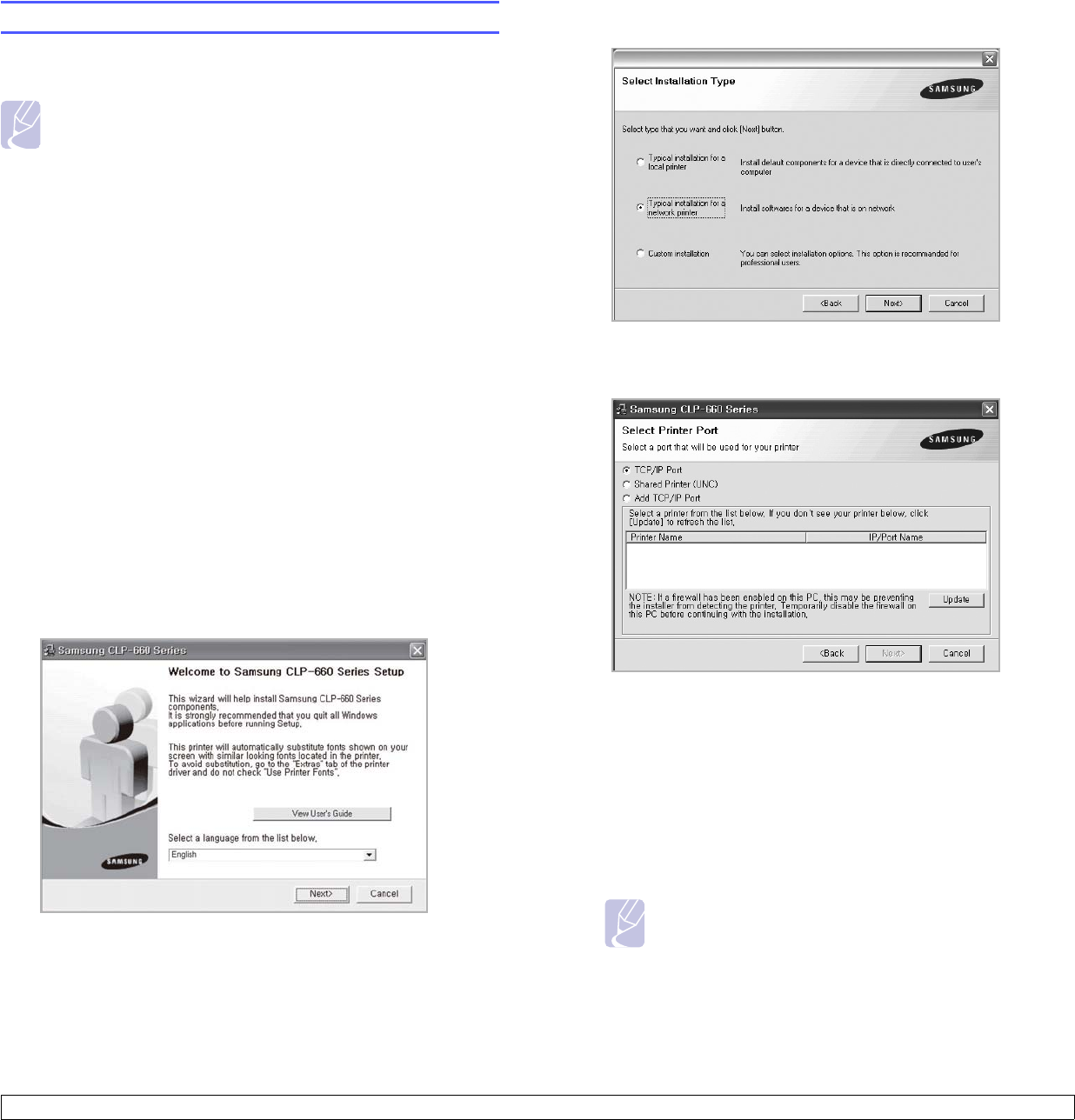
3.3 <
Getting Started>
Installing the software
You have to install the machine software for printing. The software
includes drivers, applications, and other user friendly programs.
Note
• The following procedure is for when you use the machine as
a network machine. If you want to connect a machine with a
USB cable, refer to the
Software section
.
• The following procedure is based on the Windows XP
operating system. The procedure and popup window which
appears during the installation may differ depending on the
operating system, the printer feature, or the interface in use.
(See
Software section
.)
1Make sure that the network setup for your machine is completed.
(See "Setting up the network" on page 3.1.) All applications should
be closed on your computer before beginning installation.
2Insert the Printer Software CD-ROM into your CD-ROM drive.
The CD-ROM should automatically run, and an installation window
appears.
3Click Next.
If the installation window does not appear, click Start > Run. Type
X:\Setup.exe, replacing “X” with the letter which represents your
drive and click OK.
If you use Windows Vista, click Start > All Programs >
Accessories > Run, and type X:\Setup.exe.
If the AutoPlay window appears in Windows Vista, click Run
Setup.exe in Install or run program field, and click Continue in
the User Account Control window.
• The window above may slightly differ, if you are reinstalling the
driver.
•View User’s Guide: Allows you to view the User’s Guide. If your
computer does not have Adobe Acrobat, click on this option and it
will automatically install Adobe Acrobat Reader for you, and then
open the User’s Guide.
4Select Typical installation for a network printer, and then click
Next.
5The list of machines available on the network appears. Select the
printer you want to install from the list and then click Next.
• If you do not see your machine on the list, click Update to refresh
the list, or select Add TCP/IP Port to add your machine to the
network. To add the machine to the network, enter the port name
and the IP address for the machine.
To verify your machine’s IP address or the MAC address, print a
Network Configuration page. (See "Printing a machine
configuration report" on page 6.1.)
• To find a shared network printer (UNC Path), select Shared
Printer [UNC] and enter the shared name manually or find a
shared printer by clicking the Browse button.
Note
If you are not sure of the IP address, contact your network
administrator or print network information. (See "Printing a
machine configuration report" on page 6.1.)
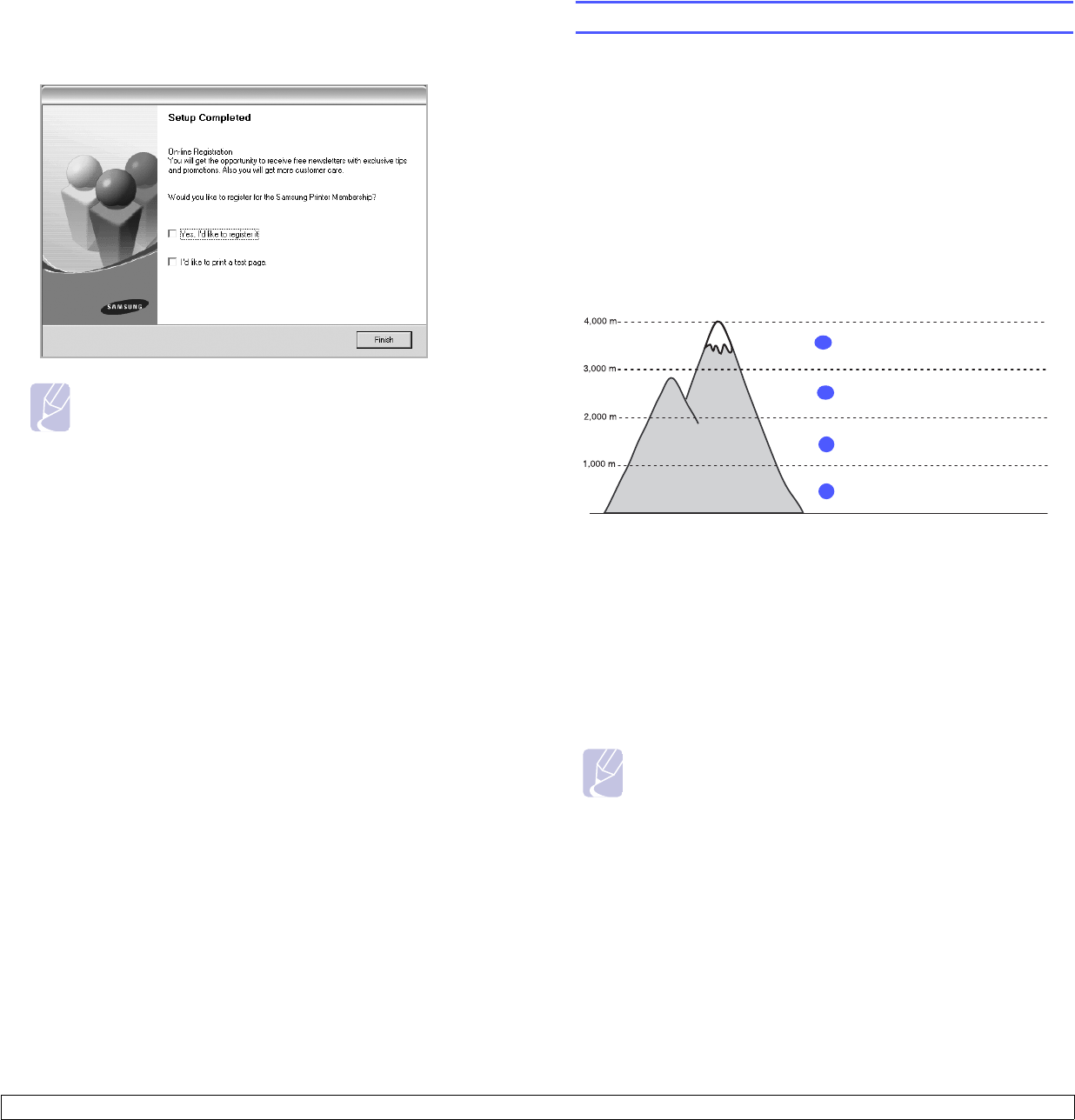
3.4 <
Getting Started>
6After the installation is finished, a window appears asking you to
print a test page and to register yourself as a user of Samsung
machines in order to receive information from Samsung. If you so
desire, select the corresponding checkbox(es) and click Finish.
Note
If your machine does not work properly after the installation,
try to reinstall the printer driver. See
Software section
.
Printer's basic settings
After installation is complete, you may want to set the printer's default
settings. Refer to the next section if you would like to set or change
values.
Altitude Setting after Software Installation
The print quality is affected by atmospheric pressure, which is determined
by the height of the machine above sea level. The following information
will guide you on how to set your machine to the best print quality or best
quality of print.
Before you set the altitude value, find the altitude where you are using the
machine.
1Ensure that you have installed the printer driver with the provided
Printer Software CD.
2Double-check the Smart Panel icon on the Windows task bar (or
Notification Area in Linux).
You can also click Smart Panel on the status bar in Mac OS X.
3Click Printer Setting.
4Click Setting > Altitude Adjustment. Select the appropriate value
from the dropdown list, and then click Apply.
Note
If your machine is connected to a network, SyncThru Web
Service screen appears automatically. Click Printer Setting >
Setup (or Machine Setup) > Altitude Adj. Select the
appropriate altitude value, and then click Apply.
0
High 3
1
Normal
4
Value
2High 2
3High 1

3.5 <
Getting Started>
Changing the display language
To change the language that appears on the display, refer to the following
steps.
1Press Menu on the control panel until you see 5.System Setup on
the bottom line of the display.
2Press OK to access 5.System Setup.
3Press the left/right arrow until Language displays.
4Press OK.
5Press the left/right arrow until the language you want displays.
6Press OK.
7Press Stop to return to machine ready mode.
Setting job timeout
1Press Menu on the control panel until you see 5.System Setup on
the bottom line of the display.
2Press OK to access 5.System Setup.
3Press the left/right arrow until Job Timeout displays.
4Press OK.
5Press the left/right arrow to select the amount of time the machine
will wait.
6Press OK.
7Press Stop to return to machine ready mode.
Using power saving feature
The machine provides power saving features. When the machine is not
in use, you can save electricity with the provided power save mode. Set
the specific time the machine goes to the power save mode.
1Press Menu on the control panel until you see 5.System Setup on
the bottom line of the display.
2Press OK to access 5.System Setup.
3Press the left/right arrow until Power Save displays.
4Press OK.
5Press the left/right arrow to select the amount of time.
6Press OK.
7Press Stop to return to machine ready mode.
Setting the default paper size and type
You can select the paper size you would like to keep for printing job.
Note
For detailed information on the Custom paper size setting and
the paper type setting, see "Setting the paper size and type" on
page 4.7.
1Press Menu on the control panel until you see 4.Paper on the
bottom line of the display.
2Press OK to access the paper setup.
3Press the left/right arrow until Paper Size displays.
4Press OK.
5Press the left/right arrow to select the paper size such as A4,Letter
or Custom.
6Press OK.
7Press Stop to return to machine ready mode.
Setting the default tray
If you want to select the particular tray for the print job, use the Paper
Source feature.
1Press Menu on the control panel until you see 4.Paper on the
bottom line of the display.
2Press OK to access the paper setup.
3Press the left/right arrow until Paper Source displays.
4Press OK.
5Press the left/right arrow to select the paper tray, such as Tray 1,
Tray 2,MP Tray,Manual Feeder or Auto.
Note
If you set this menu to Auto, an additional menu, Tray
Chaining appears. With Tray Chaining, the machine finds a
secondary available tray to continue a printing job in case the
primary tray, usually tray 1, is vacant.
6Press OK.
7Press Stop to return to machine ready mode.
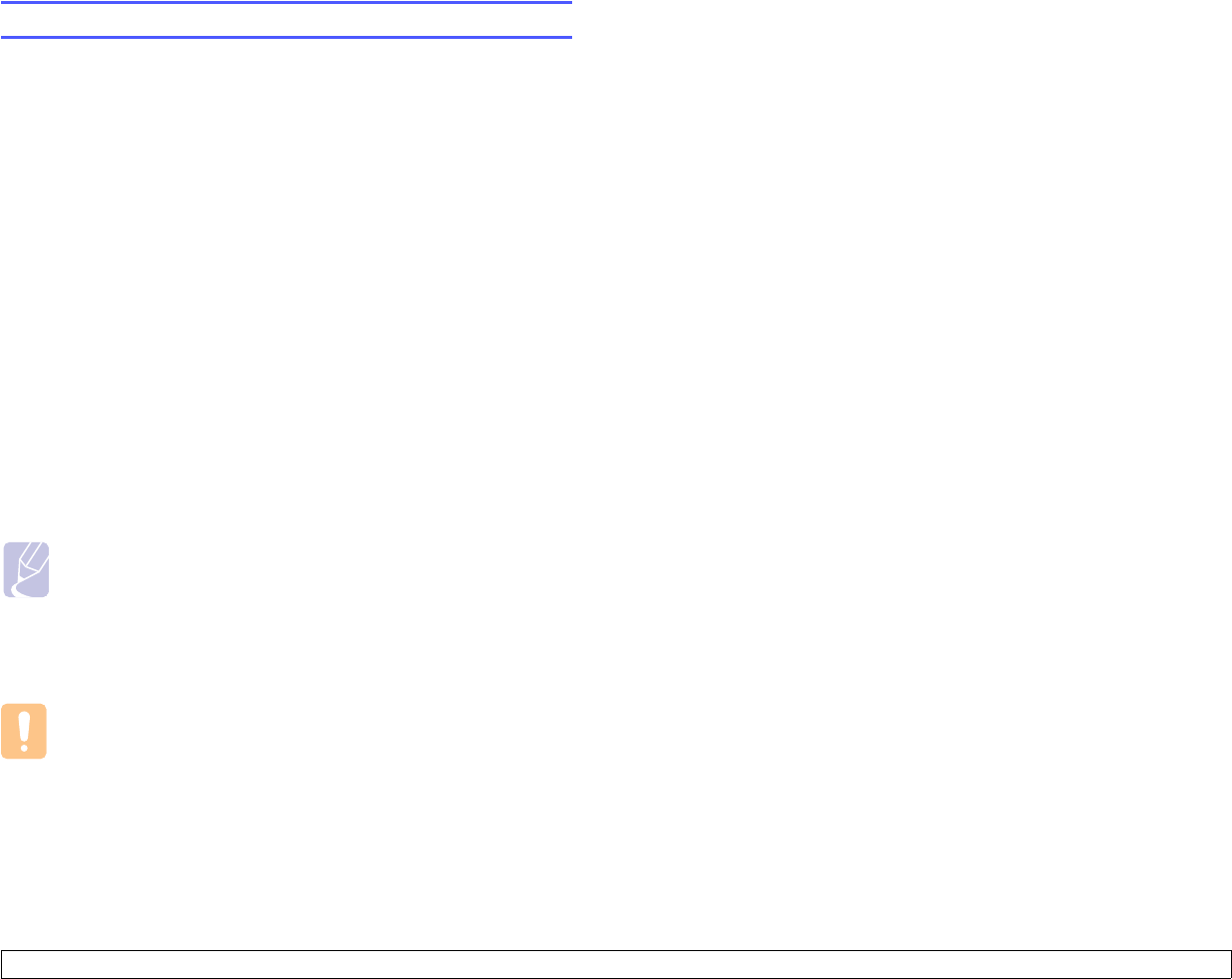
4.1 <
Selecting and loading print media>
4 Selecting and loading print
media
This chapter introduces you how select and load print media for your
machine.
This chapter includes:
• Selecting print media
• Loading paper
• Setting the paper size and type
Selecting print media
You can print on a variety of print media, such as plain paper, envelopes,
and labels. Always use print media that meet the guidelines for use with
your machine. Print media that does not meet the guidelines outlined in
this user’s guide may cause the following problems:
• Poor print quality
• Increased paper jams
• Premature wear on the machine.
Properties, such as weight, composition, grain, and moisture content, are
important factors that affect the machine’s performance and the output
quality. When you choose print materials, consider the following:
• The type, size and weight of the print media for your machine are
described later in this section.
• Desired outcome: The print media you choose should be appropriate
for your project.
• Brightness: Some print media are whiter than others and produce
sharper, more vibrant images.
• Surface smoothness: The smoothness of the print media affects how
crisp the printing looks on the paper.
Caution
Using print media that does not meet these specifications may
cause problems, requiring repairs. Such repairs are not covered
by Samsung’s warranty or service agreements.
Note
• Some print media may meet all of the guidelines in this section
and still not produce satisfactory results. This may be the result
of improper handling, unacceptable temperature and humidity
levels, or other variables over which Samsung has no control.
• Before purchasing large quantities of print media, ensure that it
meets the requirements specified in this user’s guide.
Guidelines for selecting and storing print media
When selecting or loading paper, envelopes, or other print materials,
keep these guidelines in mind:
• Always use print media that conform with the specifications listed on
page 4.2.
• Attempting to print on damp, curled, wrinkled, or torn paper can cause
paper jams and poor print quality.
• For the best print quality, use only high quality copier grade paper
specifically recommended for use in laser machines.
• Avoid using the following media types:
- Paper with embossed lettering, perforations, or a texture that is too
smooth or too rough
- Erasable bond paper
- Multi-paged paper
- Synthetic paper and thermally reactive paper
- Carbonless paper and Tracing paper.
Use of these types of paper could result in paper jams, chemical
smells, and damage to your machine.
• Store print media in its ream wrapper until you are ready to use it.
Place cartons on pallets or shelves, not on the floor. Do not place
heavy objects on top of the paper, whether it is packaged or
unpackaged. Keep it away from moisture or other conditions that can
cause it to wrinkle or curl.
• Store unused print media at temperatures between 15 °C and 30 °C.
The relative humidity should be between 10% and 70%.
• Store unused print media in a moisture-proof wrap, such as a plastic
container or bag, to prevent dust and moisture from contaminating
your paper.
• Load special media types one sheet at a time through the multi-
purpose tray to avoid paper jams.
• To prevent print media, such as label sheets, from sticking together,
remove them as they print out.
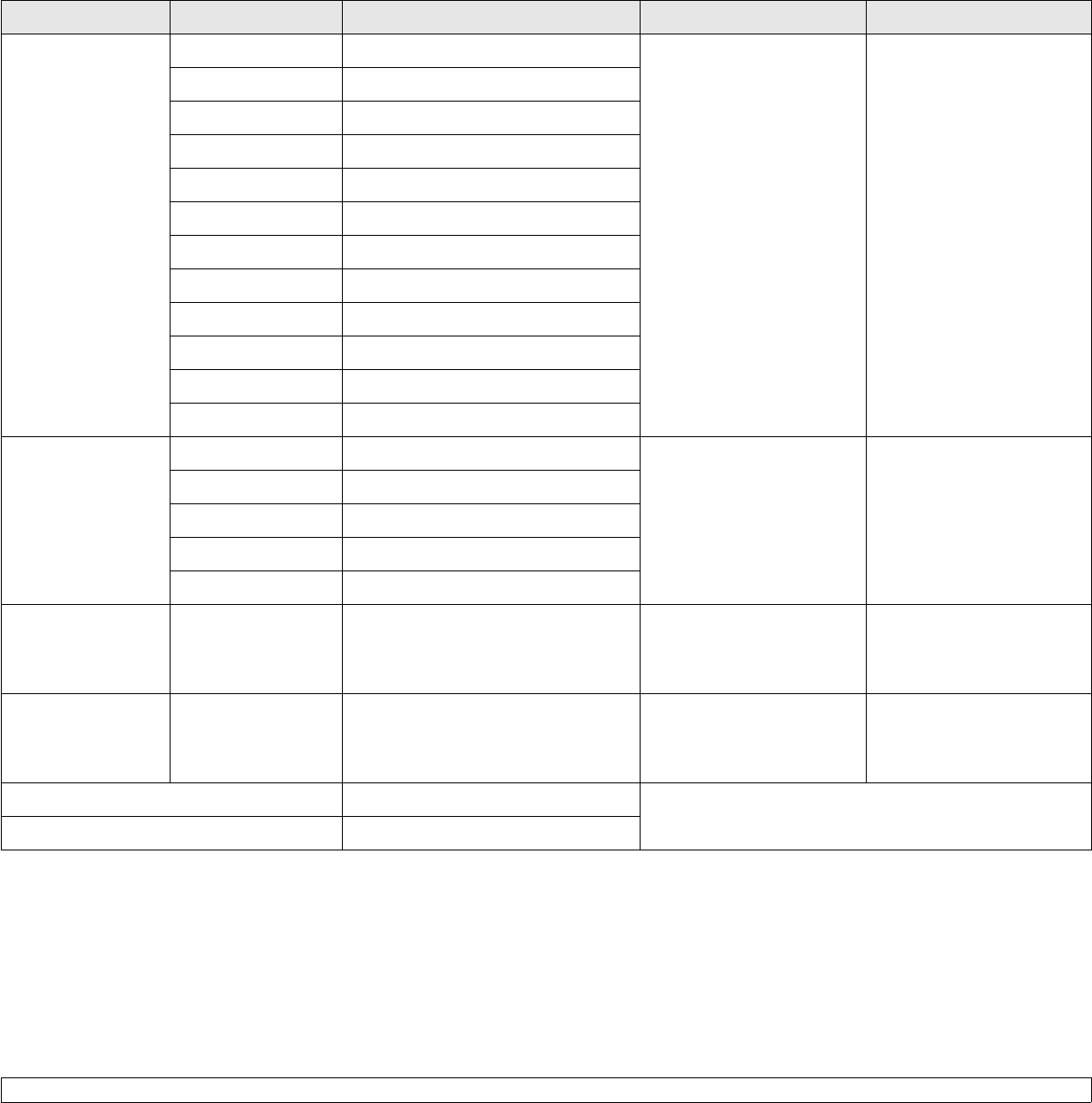
4.2 <
Selecting and loading print media>
Specifications on print media
Type Size Dimensions Weighta
a. If media weight is over 105 g/m2 (28 lb bond), use the multi-purpose tray.
Capacityb
b. Maximum capacity may differ depending on media weight, thickness, and environmental conditions.
Plain paper Letter 216 x 279 mm (8.5 x 11 inches) • 60 to 105 g/m2 (16 to 28 lb
bond) for the tray
• 60 to 163 g/m2 (16 to 43 lb
bond) for the multi-purpose
tray
• 250 sheets of 75 g/m2
(20 lb bond) paper for the
tray
• 100 sheets of 75 g/m2
(20 lb bond) in the multi-
purpose tray
• 500 sheets of 75 g/m2
(20 lb bond) paper for
optional tray
Legal 216 x 356 mm (8.5 x 14 inches)
Folio 216 x 330 mm (8.5 x 13 inches)
A4 210 x 297 mm (8.26 x 11.69 inches)
Oficio 216 x 343 mm (8.5 x 13.5 inches)
JIS B5 182 x 257 mm (7.16 x 10.11 inches)
ISO B5 176 x 250 mm (6.93 x 9.84 inches)
Executive 184 x 267 mm (7.25 x 10.5 inches)
A5 148 x 210 mm (5.82 x 8.26 inches)
Statement 140 x 216 mm (5.5 x 8.5 inches)
A6 105 x 148 mm (4.13 x 5.82 inches)
Post Card 105 x 148 mm (4.13 x 5.82 inches)
Envelope Envelope Monarch 98 x 191 mm (3.87 x 7.5 inches) 75 to 105 g/m2 (20 to 28 lb
bond)
• 10 sheets of 75 g/m2 (20 lb
bond) in the multi-purpose
tray
Envelope No. 10 105 x 241 mm (4.12 x 9.5 inches)
Envelope DL 110 x 220 mm (4.33 x 8.66 inches)
Envelope C5 162 x 229 mm (6.37 x 9.01 inches)
Envelope C6 114 x 162 mm (4.48 x 6.38 inches)
Labels Letter, Legal, Folio,
A4, JIS B5, ISO B5,
Executive, A5,
Statement
Refer to the Plain paper section 120 to 150 g/m2 (32 to 40 lb
bond)
30 sheets of 75 g/m2 (20 lb
bond) paper for the multi-
purpose tray
Card stock Letter, Legal, Folio,
A4, JIS B5, ISO B5,
Executive, A5,
Statement
Refer to the Plain paper section 90 to 163 g/m2 (24 to 43 lb
bond)
30 sheets of 75 g/m2 (20 lb
bond) paper for the multi-
purpose tray
Minimum size (custom) 76 x 127 mm (3 x 5 inches) 60 to 163 g/m2 (16 to43 lb bond)
Maximum size (custom) 216 x 356 mm (8.5 x 14 inches)
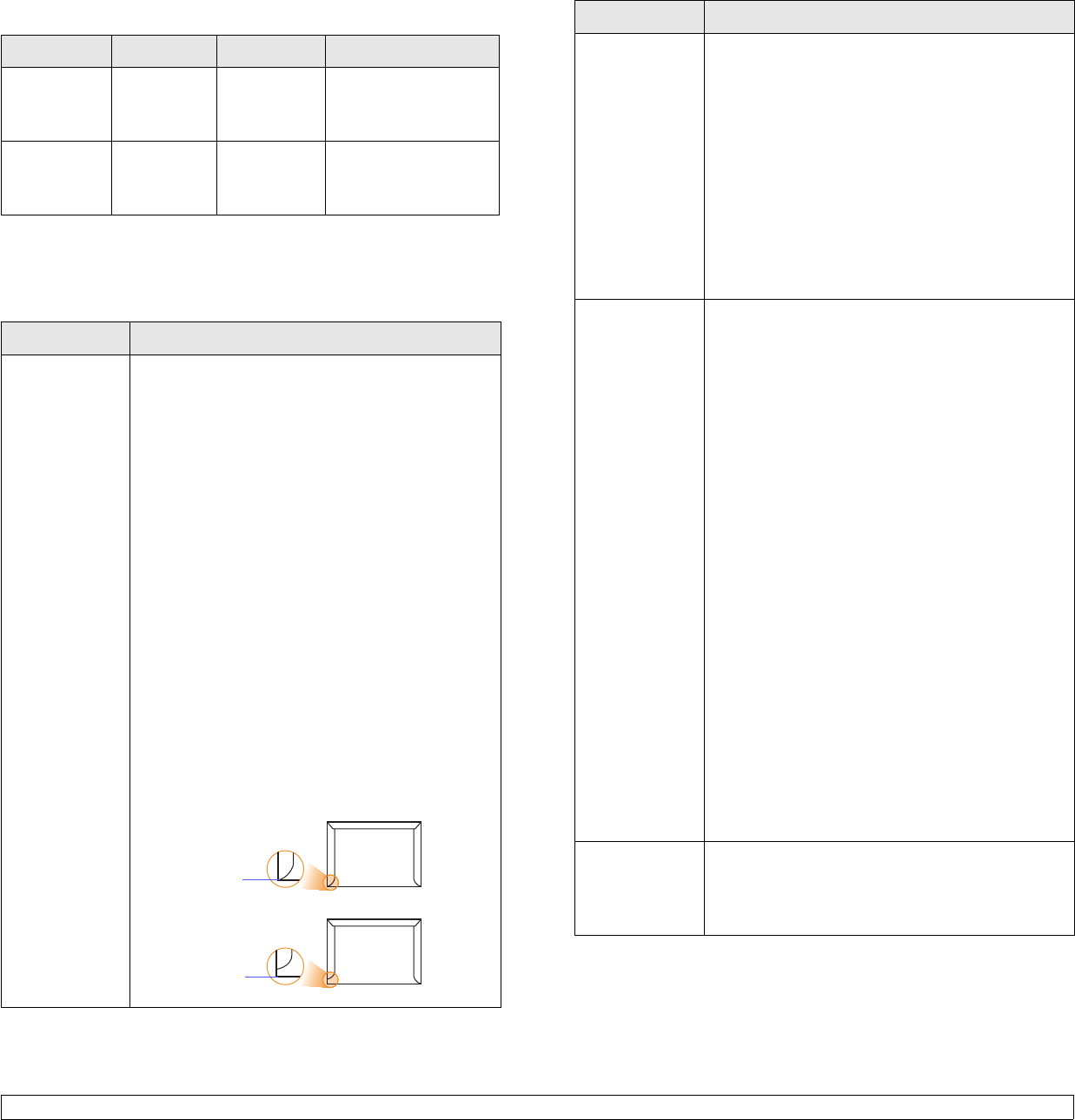
4.3 <
Selecting and loading print media>
Media sizes supported in each mode
Guidelines for special print media
Mode Size Weight Source
Single side
printing
All sizes
supported by
the machine
All weights
supported by
the machine
•tray1
• optional tray
• multi-purpose tray
Duplex
printinga
a. 75 to 105 g/m2 (20 ~ 28 lb bond) only, and this feature is supported in
CLP-6xxND.
Letter, A4,
Legal, Folio,
Oficio
75 to 90 g/m2
(20 to 24 lb
bond)
•tray1
• optional tray
• multi-purpose tray
Media type Guidelines
Envelopes • Successful printing on envelopes depends upon
the quality of the envelopes. When selecting
envelopes, consider the following factors:
- Weight: The weight of the envelope paper
should not exceed 90 g/m2 or jamming may
occur.
- Construction: Prior to printing, envelopes
should lie flat with less than 6 mm curl, and
should not contain air.
- Condition: Envelopes should not be wrinkled,
nicked, or otherwise damaged.
- Temperature: You should use envelopes that
are compatible with the heat and pressure of
the machine during operation.
• Use only well-constructed envelopes with sharp
and well creased folds.
• Do not use stamped envelopes.
• Do not use envelopes with clasps, snaps,
windows, coated lining, self-adhesive seals, or
other synthetic materials.
• Do not use damaged or poorly made envelopes.
• Be sure the seam at both ends of the envelope
extends all the way to the corner of the
envelope.
Acceptable
Unacceptable
• Envelopes with a peel-off adhesive strip or with
more than one flap that folds over to seal must
use adhesives compatible with the machine’s
fusing temperature for 0.1 second. Check your
machine’s specification to view the fusing
temperature, see page 10.1. The extra flaps and
strips might cause wrinkling, creasing, or jams,
and may even damage the fuser.
• For the best print quality, position margins no
closer than 15 mm from the edges of the
envelope.
• Avoid printing over the area where the
envelope’s seams meet.
Labels • To avoid damaging the machine, use only labels
designed for use in laser machines.
• When selecting labels, consider the following
factors:
- Adhesives: The adhesive material should be
stable at your machine’s fusing temperature.
Check your machine’s specification to view the
fusing temperature, see page 10.1.
- Arrangement: Only use labels with no
exposed backing between them. Labels can
peel off sheets that have spaces between the
labels, causing serious jams.
- Curl: Prior to printing, labels must lie flat with
no more than 13 mm of curl in any direction.
- Condition: Do not use labels with wrinkles,
bubbles, or other indications of separation.
• Make sure that there is no exposed adhesive
material between labels. Exposed areas can
cause labels to peel off during printing, which
can cause paper jams. Exposed adhesive can
also cause damage to machine components.
• Do not run a sheet of labels through the machine
more than once. The adhesive backing is
designed for only a single pass through the
machine.
• Do not use labels that are separating from the
backing sheet or are wrinkled, bubbled, or
otherwise damaged.
Card stock or
custom-sized
materials
• Do not print on media smaller than 76 mm wide
or 356 mm long.
• In the software application, set margins at least
6.4 mm away from the edges of the material.
Media type Guidelines
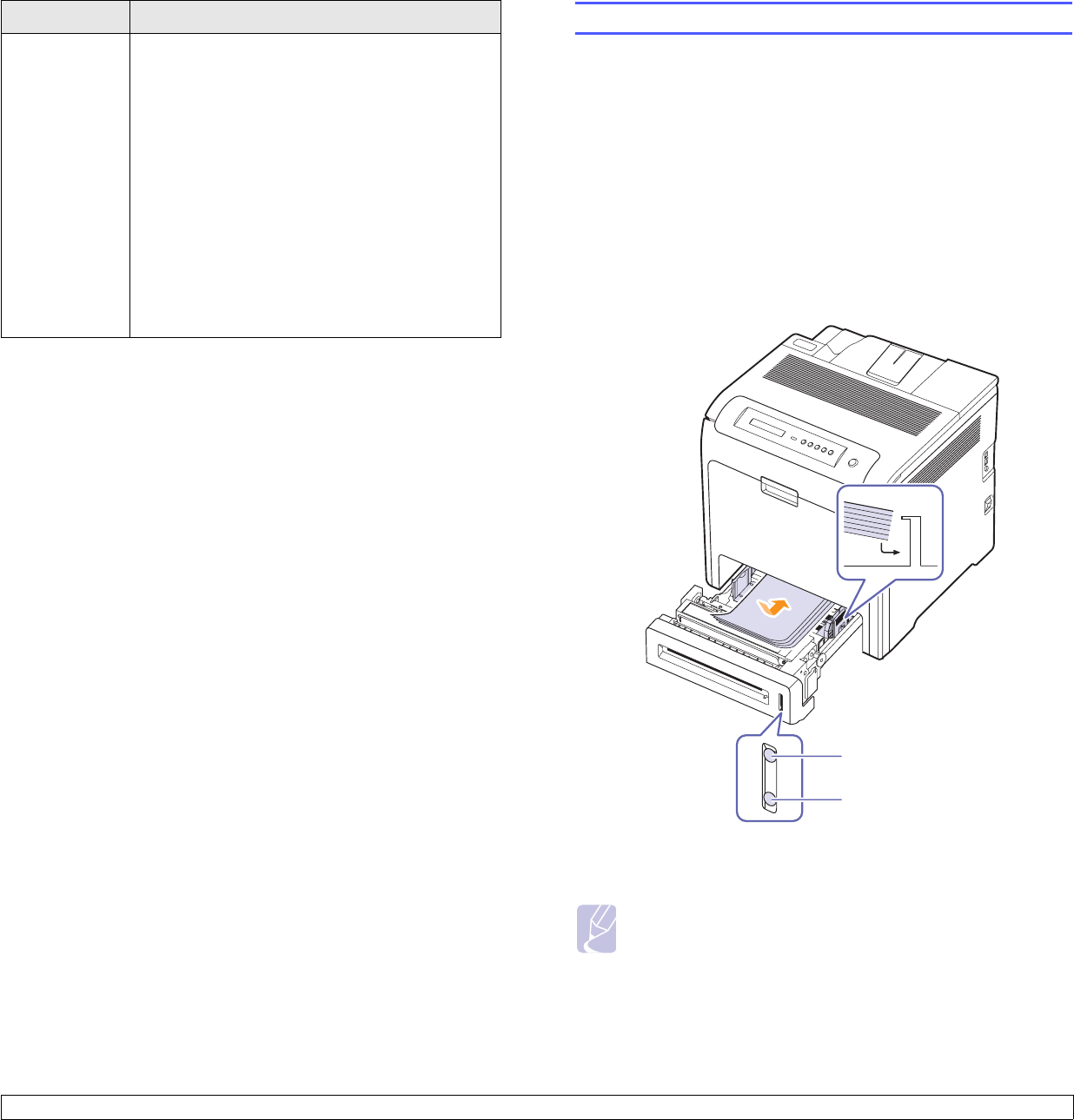
4.4 <
Selecting and loading print media>
Preprinted
paper
• Letterhead must be printed with heat-resistant
ink that will not melt, vaporize, or release
hazardous emissions when subjected to the
printer’s fusing temperature for 0.1 second.
Check your machine’s specification to view the
fusing temperature, see page 10.1.
• Letterhead ink must be non-flammable and
should not adversely affect printer rollers.
• Forms and letterhead should be sealed in a
moisture-proof wrapping to prevent changes
during storage.
• Before you load preprinted paper, such as forms
and letterhead, verify that the ink on the paper is
dry. During the fusing process, wet ink can come
off preprinted paper, reducing print quality.
Media type Guidelines Loading paper
In the tray
Load the print media you use for the majority of your print jobs in the
tray 1. The tray 1 can hold a maximum of 250 sheets of 75 g/m2 (20 lb
bond) plain paper.
You can purchase an optional tray and attach it below the standard tray
to load an additional 500 sheets of paper. (See "Accessories" on
page 8.1.)
Loading paper in the tray 1 or optional tray
1To load paper, pull and open the paper tray and place paper with the
side you want to print facing down.
2After loading paper, set the paper type and size for the tray 1. See
Software section
for PC-printing.
Note
• If you experience problems with paper feed, place one sheet at
a time in the multi-purpose tray.
• You can load previously printed paper. The printed side should
be facing up with an uncurled edge at the front. If you
experience problems with paper feed, turn the paper around.
Note that print quality is not guaranteed.
Full
Empty
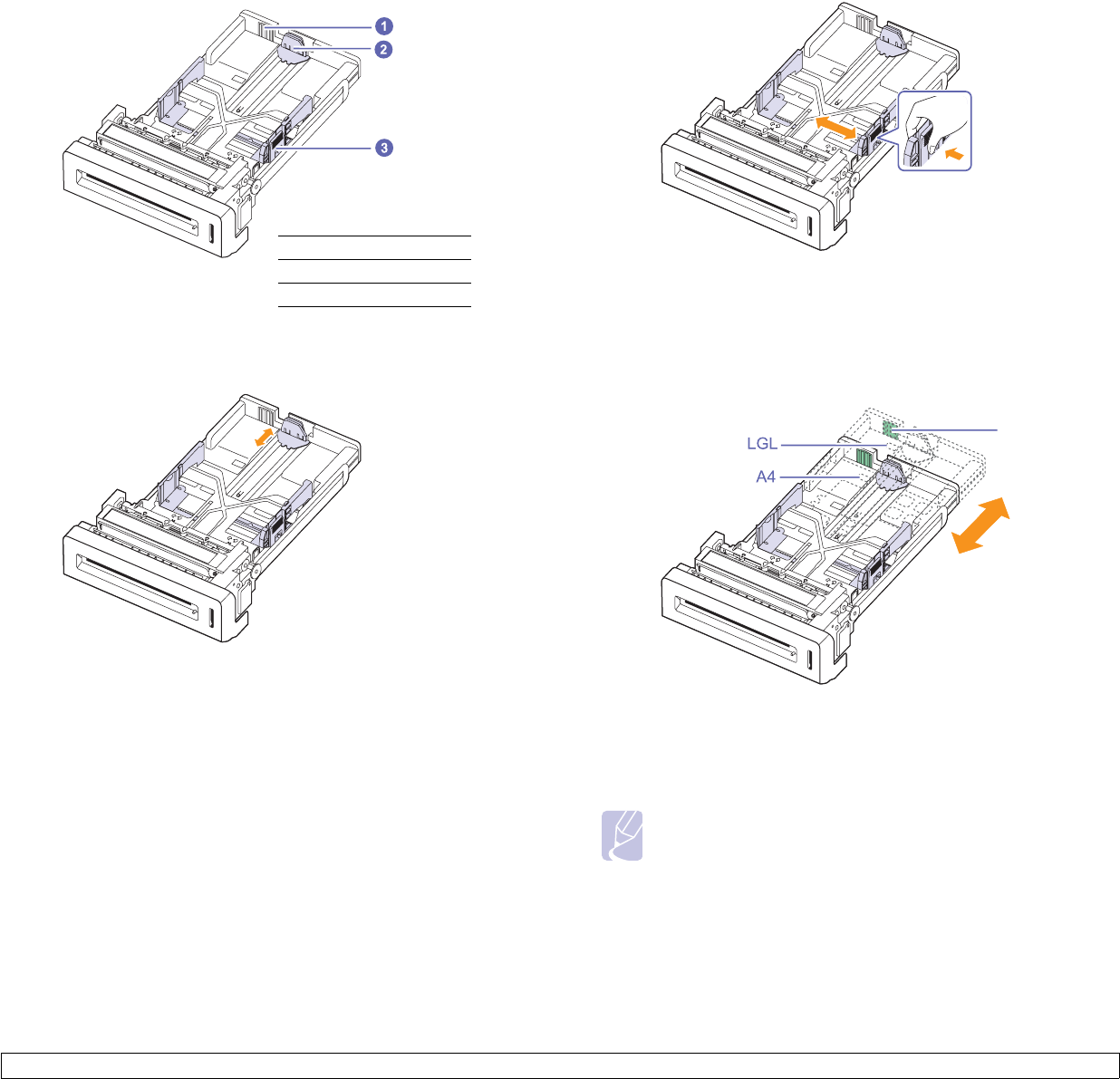
4.5 <
Selecting and loading print media>
Changing the size of the paper in the paper tray
To load longer sizes of paper, such as Legal-sized paper, you need to
adjust the paper guides to extend the paper tray.
1Adjust the paper length guide to the desired paper length. It is
preset to Letter or A4 size depending on the country.
1tray extend lever
2paper length guide
3paper width guide
2After inserting paper into the tray, while pinching the paper width
guide as shown, move it toward the stack of paper until it lightly
touches the side of the stack. Do not press the guide too tightly to
the edge of the paper; the guide may bend the paper.
When you use legal-sized paper, you need to extend the length of
the tray.
3Press and hold the green lever on the back of the tray, when you are
holding the lever, extend the tray to the corresponding position.
4Load the paper into the tray.
5Place the tray into the machine.
6Set the paper size from your computer. (See page 4.7)
Note
• Do not push the paper width guides far enough to cause the
materials to warp.
• If you do not adjust the paper width guides, it may cause paper
jams.
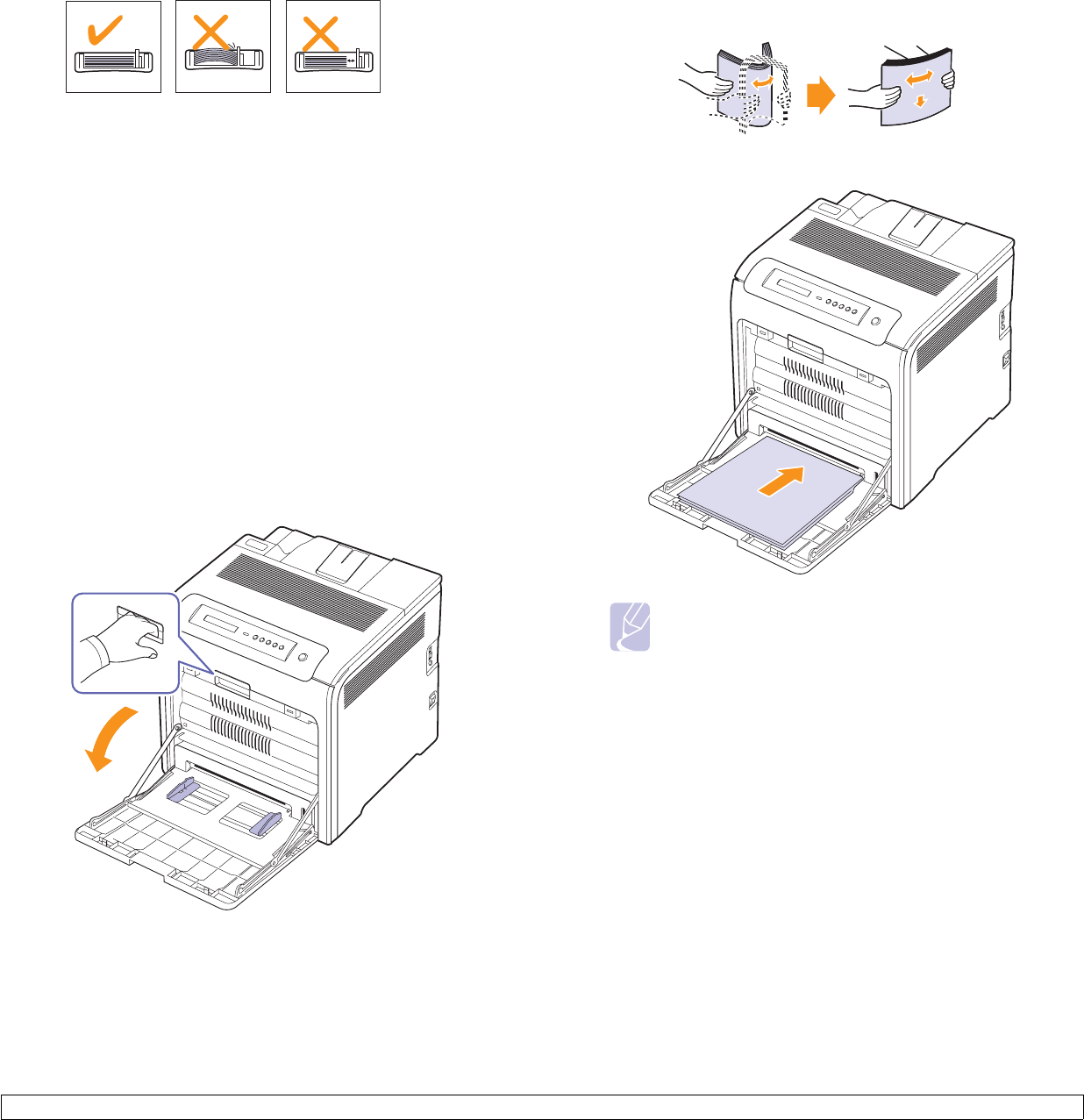
4.6 <
Selecting and loading print media>
In the multi-purpose tray
The multi-purpose tray can hold special sizes and types of print material,
such as postcards, note cards, and envelopes. It is useful for single page
printing on letterhead or colored paper.
Tips on using the multi-purpose tray
• Load only one size of print media at a time in the multi-purpose tray.
• To prevent paper jams, do not add paper when there is still paper in
the multi-purpose tray. This also applies to other types of print media.
• Print media should be loaded face down with the top edge going into
the multi-purpose tray first and be placed in the center of the tray.
• Always load only the specified print media to avoid paper jams and
print quality problems. (See "Selecting print media" on page 4.1.)
• Flatten any curl on postcards, envelopes, and labels before loading
them into the multi-purpose tray.
To load paper in the multi-purpose tray:
1Hold the handle of multi-purpose tray and pull it down to open.
2If you are using paper, flex or fan the edge of the paper stack to
separate the pages before loading.
3Load the paper.
Note
If you want to load the used paper, place the paper with the
printed side facing down.

4.7 <
Selecting and loading print media>
4Squeeze the multi-purpose tray paper width guides and adjust them
to the width of the paper. Do not force too much, or the paper will be
bent, which will result in a paper jam or skew.
5After loading paper, set the paper type and size for the multi-
purpose tray. See
Software section
for PC-printing.
Note
The settings made from the printer driver override the
settings on the control panel.
6After printing, close the multi-purpose tray.
Note
Depending on the media type you are using, keep the following
loading guidelines:
• Envelopes: Flap side down and with the stamp area on the top
left side.
• Labels: Print side up and top short edge entering the machine
first.
• Preprinted paper: Design side up with the top edge toward the
machine.
• Card stock: Print side up and the short edge entering the
machine first.
• Previously printed paper: Previously printed side down with an
uncurled edge toward the machine.
Setting the paper size and type
The settings you change remain in effect only while you are using the
current program. To make your changes permanent, make them in the
Printers folder.
Note
The following procedure is for Windows XP. For other Windows
OS, refer to the corresponding Windows User's Guide or online
help.
1Click the Start button on the computer screen.
2Select Printers and Other Hardwares.
3Select Printers and Faxes.
4Right-click on the printer driver icon and select Printing
Preferences.
5Click the Paper tab, and change the settings on Paper Options.
6Click OK.
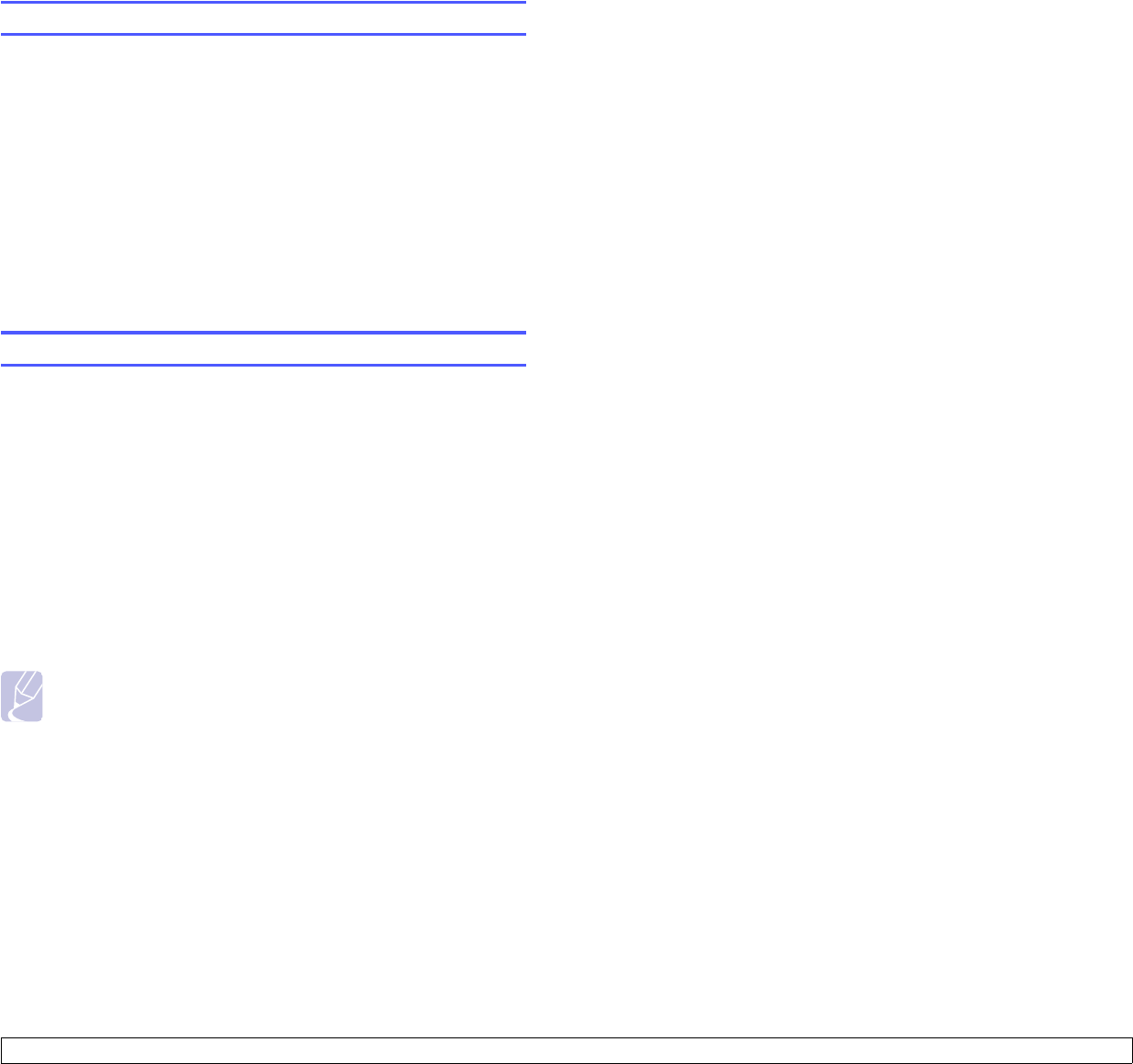
5.1 <
Basic printing>
5 Basic printing
This chapter explains common printing tasks.
Printing a document
Your machine allows you to print from various Windows, Macintosh, or
Linux applications. The exact steps for printing a document may vary
depending on the application you use.
1Open the document you want to print.
2Select Print from the File menu. The Print window is displayed. It
may look slightly different depending on your application.
3Select your printer driver from the Selet Printer drop-down list.
4To start the print job, click OK or Print in the Print window.
For details about printing, see
Software section
.
Canceling a print job
If the print job is waiting in a print queue or print spooler, such as the
printer group in Windows, delete the job as follows:
1Click the Windows Start menu.
2For Windows 2000, select Settings and then Printers.
For Windows XP/2003, select Printers and Faxes.
For Windows Vista, select Control Panel > Hardware and Sound
>Printers.
3Double-click the Samsung CLP-6xx Series PCL 6 icon. (Or
Samsung CLP-6xx Series PS)
4From the Document menu, select Cancel.
Note
You can also access this window by simply double-clicking the
printer icon at the bottom right corner of the Windows desktop.
You can also cancel the current job by pressing Stop on the control panel.
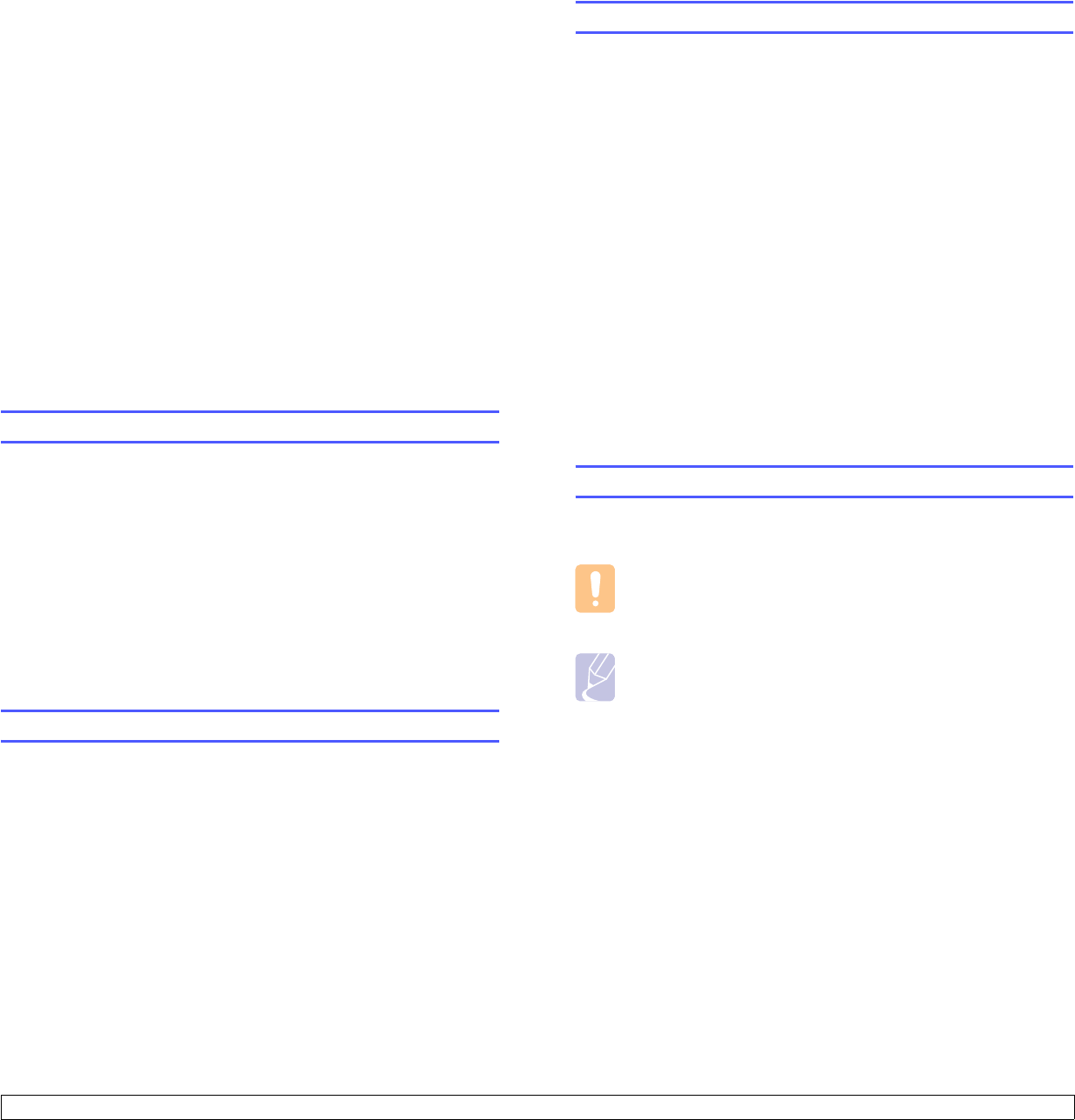
6.1 <
Maintenance>
6 Maintenance
This chapter provides information for maintaining your machine and the
print cartridge.
This chapter includes:
• Printing a machine configuration report
• Printing a network report
• Monitoring the supplies' life
• Cleaning your machine
• Maintaining the cartridge
• Redistributing toner
• Replacing the print cartridge
• Replacing the Paper Transfer Belt
• Maintenance Parts
• Managing your machine from the website
Printing a machine configuration report
You can print the machine's information and job report.
1Press Menu on the control panel until you see Information on the
bottom line of the display.
2Press OK.
3Press the left/right arrow until Configuration displays.
4Press OK.
5The display shows Print?, then press OK to print the configuration
report.
Printing a network report
You can print the machine's network information such as the protocol type
you set, IP address and so forth.
1Press Menu on the control panel until you see 8.Network on the
bottom line of the display.
2Press OK.
3Press the left/right arrow button until Network Info. displays.
4Press OK.
5The display shows Print?, then press OK to print the configuration
report.
Monitoring the supplies' life
If you want to view the supply life indicators, follow the next step.
1Press Menu on the control panel until you see System Setup on the
bottom line of the display.
2Press OK.
3Press the left/right arrow until Maintenance displays.
4Press OK.
5Press the left/right arrow until Supplies Life displays.
6Press OK.
7The display shows two options as you press the left/right arrow
button.
•Total: displays the total number of pages printed.
•Toner Remains: displays how much toner remains in the
cartridge.
8When you select the option, press OK to browse the life.
Cleaning your machine
To maintain print quality, follow the cleaning procedures below each time
the print cartridge is replaced.
Caution
Cleaning the machine cabinet with cleaning materials that
contain large amounts of alcohol, solvent, or other strong
substances can discolor or damage the cabinet.
Note
If your machine or its surrounding is contaminated with toner,
we recommend you to use a cloth or tissue dampened with
water to clean it. If you use a vacuum cleaner, toner blows into
the air then might be harmful to you.
Cleaning the outside
Clean the machine cabinet with a soft, lint-free cloth. You can dampen the
cloth slightly with water, but be careful not to let any water drip onto or into
the machine.
Cleaning the inside
During the printing process, paper, toner and dust particles can
accumulate inside the machine. This buildup can cause print quality
problems, such as toner specks or smearing. Cleaning the inside of the
machine clears or reduces these problems. Contact a service
representative to clean the parts inside the machine.
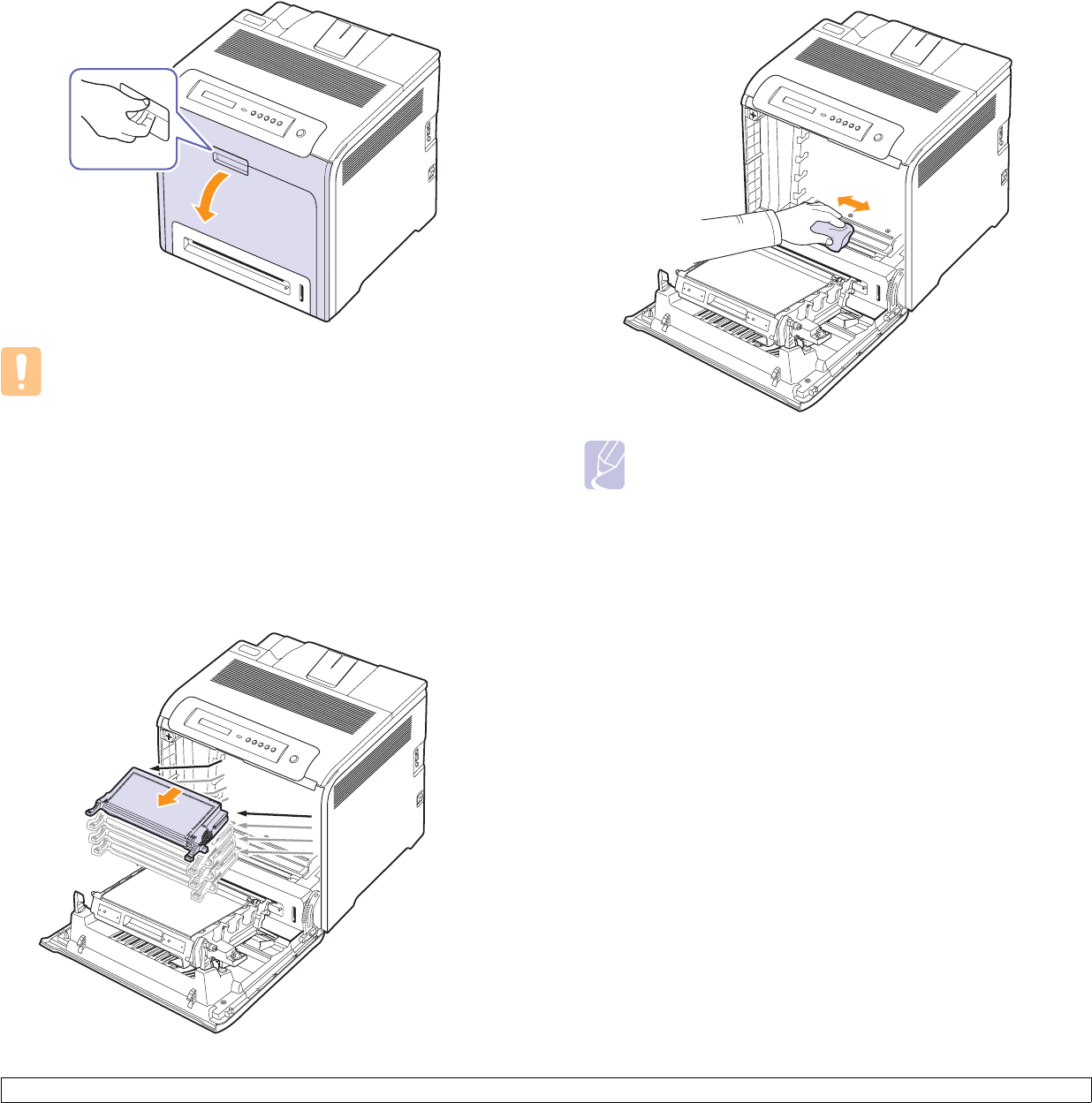
6.2 <
Maintenance>
1Using the handle, completely open the front cover.
Caution
• Do not touch the green surface, the OPC drum or the front of
the print cartridge, with your hands or any other material. Use
the handle on each cartridge in order to avoid touching this
area.
• Be careful not to scratch the surface of the paper transfer
belt.
• If you leave the front cover open for more than a few minutes,
the OPC drum can be exposed to light. This will cause
damage to the OPC drum. Cover the OPC drum of the print
cartridge with the clean paper could avoid damaging it from
the light while you clean the inside.
2Grasp the handles on the print cartridge and pull to remove all the
cartridge from the machine.
3With a dry lint-free cloth, wipe away any dust and spilled toner from
the print cartridges area and their cavities.
Note
If toner gets on your clothing, wipe it off with a dry
cloth and wash it in cold water. Hot water sets toner into
fabric.
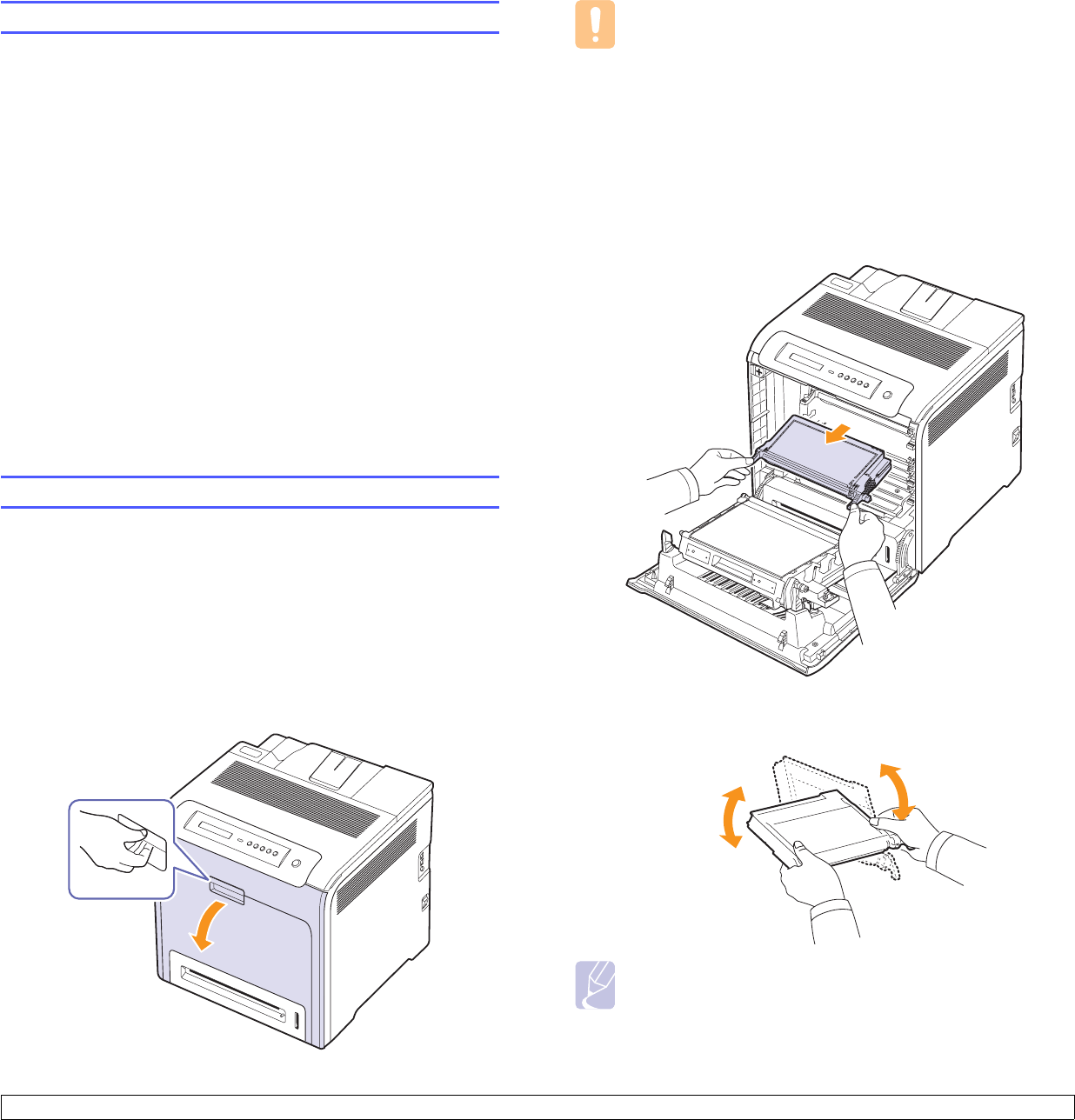
6.3 <
Maintenance>
Maintaining the cartridge
print cartridge storage
To get the most from the print cartridge, keep the following guidelines in
mind:
• Do not remove the print cartridge from its package until ready for use.
• Do not refill the print cartridge. The machine warranty does not cover
damage caused by using a refilled cartridge.
• Store print cartridges in the same environment as your machine.
• To prevent damage to the print cartridge, do not expose it to light for
more than a few minutes.
Expected cartridge life
The life of the print cartridge yield depends on the amount of toner that
print jobs require. The actual number may also be different depending on
the print density of the pages you print on, and the number of pages may
be affected by operating environment, printing interval, media type, and
media size. If you print a lot of graphics, you may need to change the
cartridge more often.
Redistributing toner
When a toner is low, faded or light areas may appear. It is possible that
colored images may be printed with incorrect colors due to flawed mixing
of toner colors when one of the colored print cartridges is low on toner.
You can temporarily improve print quality by redistributing the toner.
• The toner-related message saying that the toner is low may appear on
the display.
• The SmartPanel program window appears on the computer telling you
which color cartridge is low on toner.
1Using the handle, completely open the front cover.
Caution
• Do not touch the green surface, the OPC drum or the front of
the print cartridge, with your hands or any other material. Use
the handle on each cartridge in order to avoid touching this
area.
• Be careful not to scratch the surface of the paper transfer
belt.
• If you leave the front cover open for more than a few minutes,
the OPC drum can be exposed to light. This will cause
damage to the OPC drum. Close the front cover should the
installation need to be halted for any reason.
2Grasp the handles on the print cartridge and pull to remove the
cartridge from the machine.
3Holding both handles on the print cartridge, thoroughly rock it from
side to side to redistribute the toner.
Note
If toner gets on your clothing, wipe it off with a dry
cloth and wash it in cold water. Hot water sets toner into
fabric.
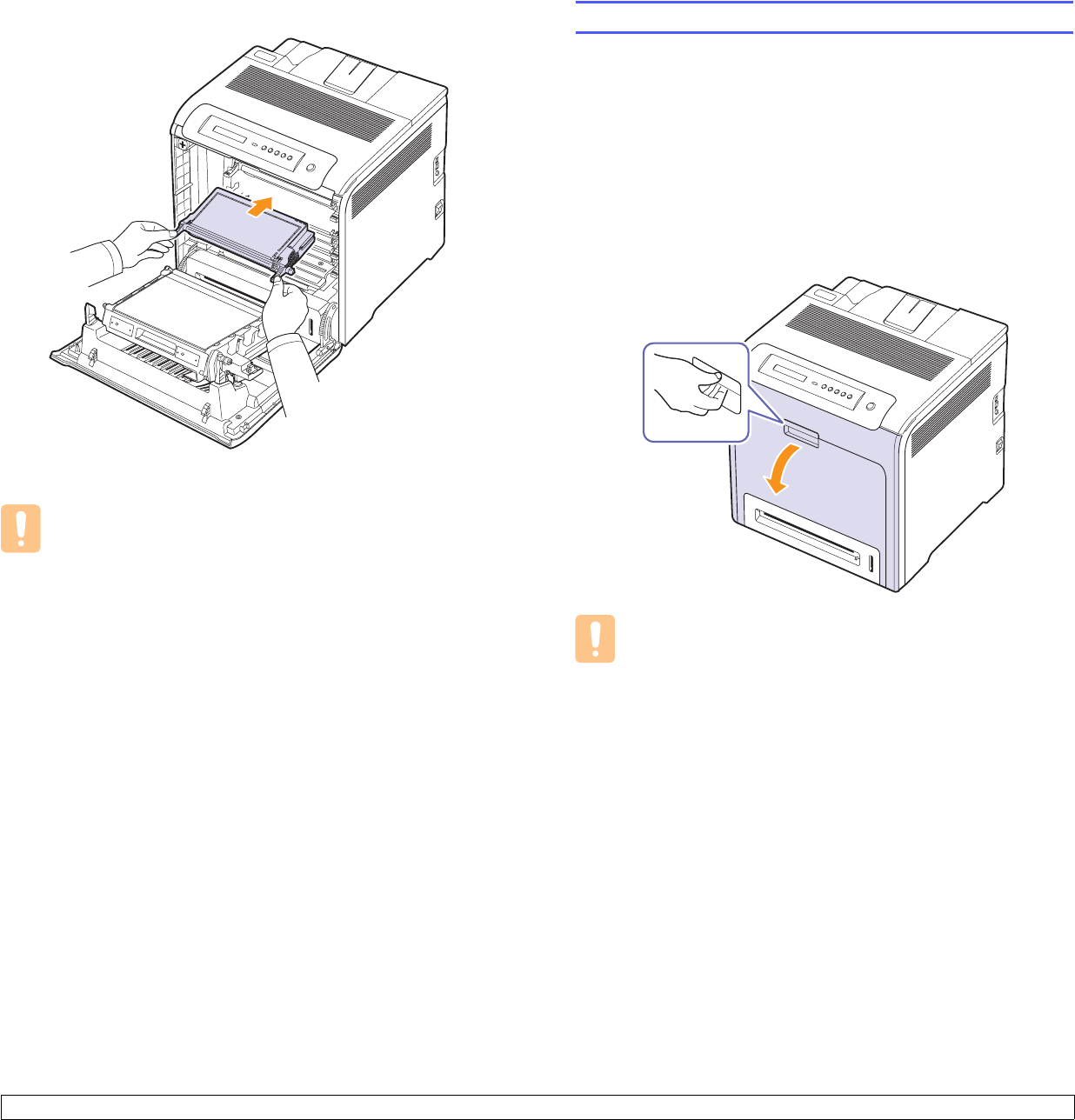
6.4 <
Maintenance>
4Slide the print cartridge back into the machine.
5Close the front cover. Make sure that the cover is securely latched.
Caution
If the front cover is not completely closed, the machine will not
operate.
Replacing the print cartridge
The machine uses four colors and has a different print cartridge for each
one: yellow (Y), magenta (M), cyan (C), and black (K).
• The status LED and the toner-related message on the display indicate
when each individual print cartridge should be replaced.
At this stage, the print cartridge needs to be replaced. Check the type of
print cartridge for your machine. (See "Supplies" on page 8.1.)
1Turn the machine off, then wait a few minutes for the machine to
cool.
2Using the handle, completely open the front cover.
Caution
• Do not touch the green surface, the OPC drum or the front of
each print cartridge, with your hands or any other material.
Use the handle on each cartridge in order to avoid touching
this area.
• Be careful not to scratch the surface of the paper transfer
belt.
• If you leave the front cover open for more than a few minutes,
the OPC drum can be exposed to light. This will cause
damage to the OPC drum. Close the front cover should the
installation need to be halted for any reason.
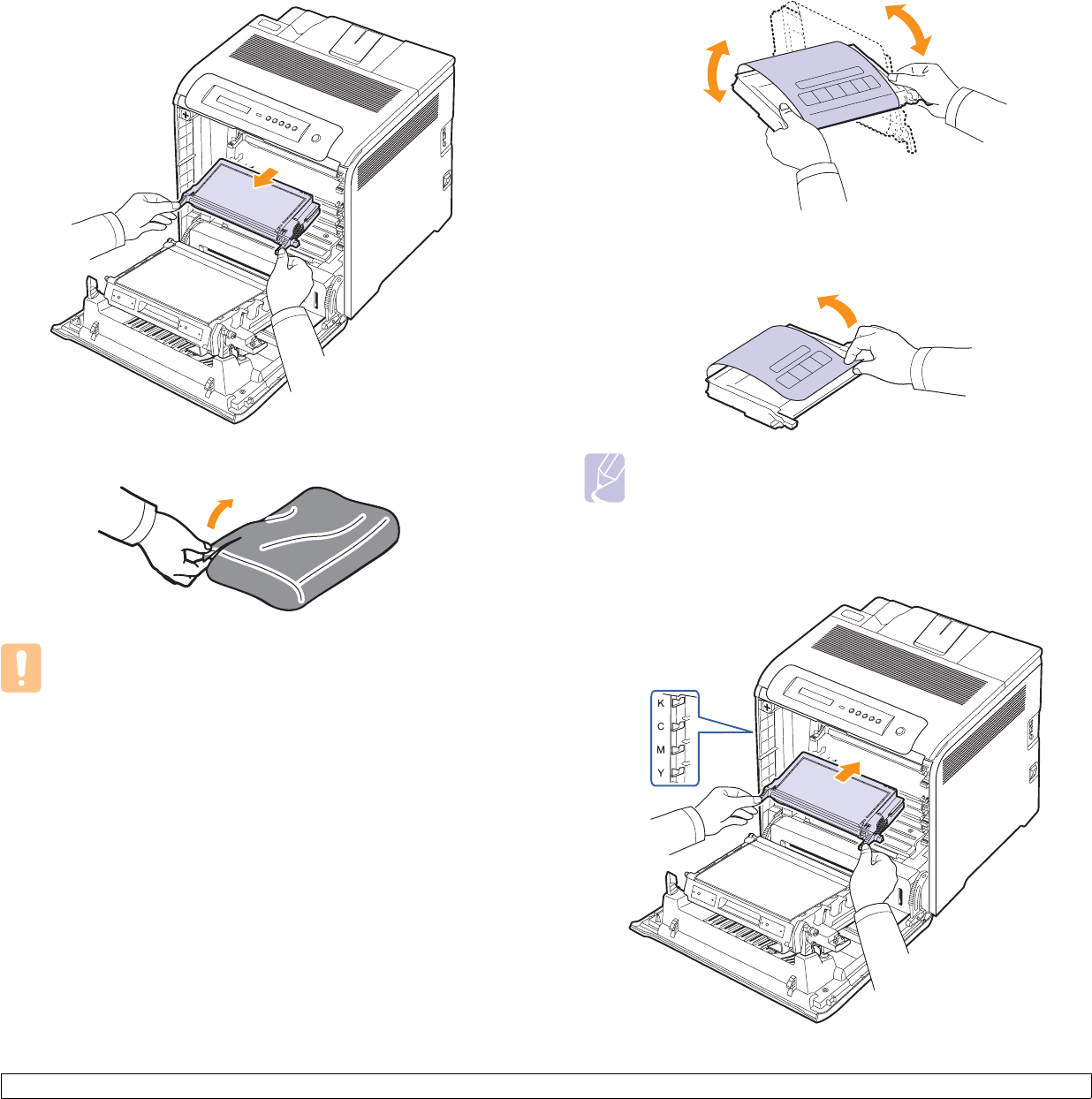
6.5 <
Maintenance>
3Grasp the handles on the empty print cartridge and pull to remove
the cartridge from the machine.
4Take a new print cartridge out of its package.
Caution
• Don't use sharp objects, such as a knife or scissors, to open
the print cartridge package. You could damage the surface of
the print cartridge.
• To prevent damage, do not expose the print cartridge to light
for more than a few minutes. Cover it with a piece of paper to
protect it if necessary.
5Holding both handles on the print cartridge, thoroughly rock it from
side to side to evenly distribute the toner.
6Place the print cartridge on a flat surface, as shown, and remove the
paper covering the print cartridge by removing the tape.
Note
If toner gets on your clothing, wipe it off with a dry cloth and
wash it in cold water. Hot water sets toner into fabric.
7Make sure that the color of the print cartridge matches the color slot
and then grasp the handles on the print cartridge. Insert the
cartridge until it clicks into place.
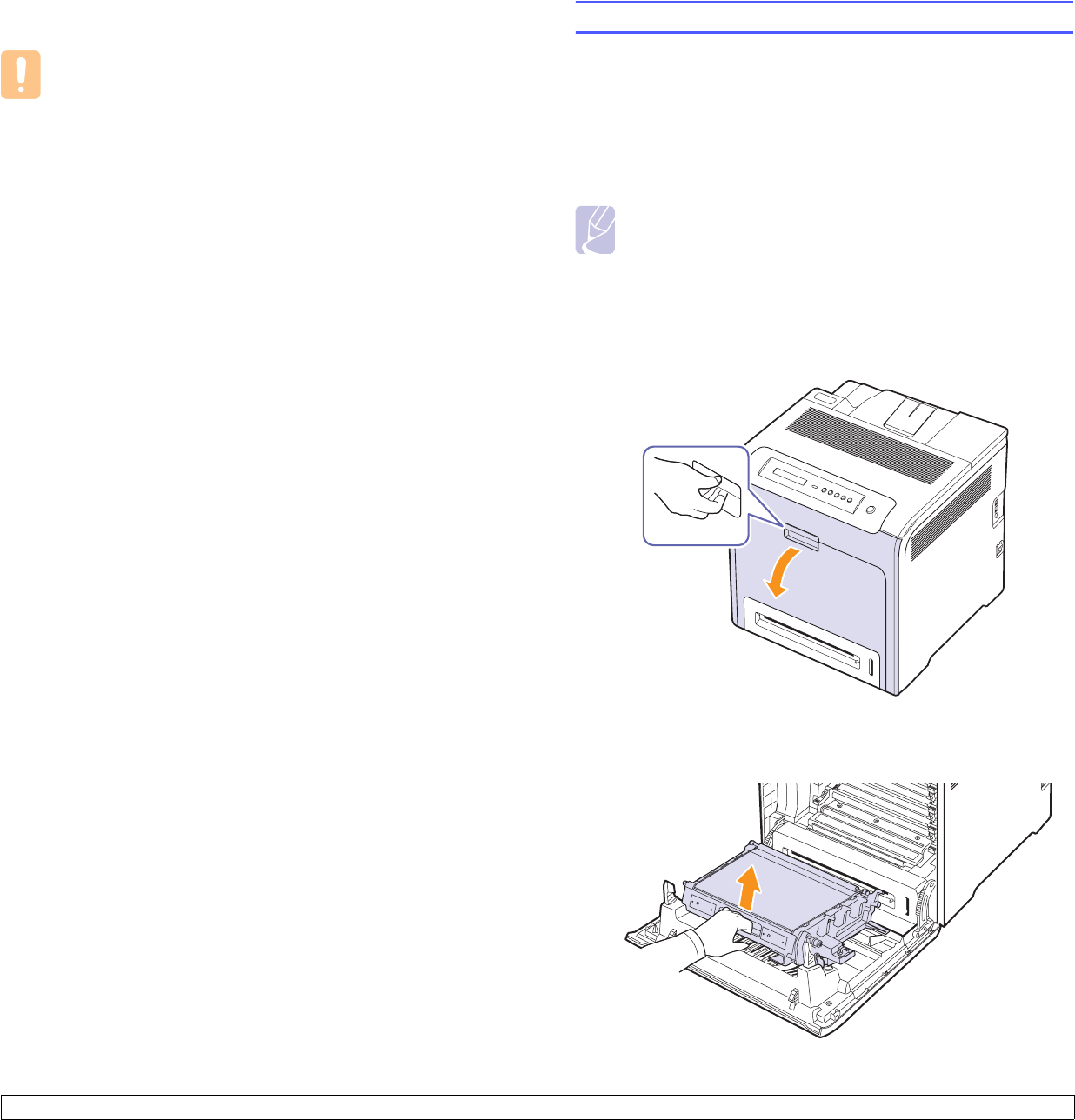
6.6 <
Maintenance>
8Close the front cover. Make sure that the cover is securely latched,
and then turn the machine on.
Caution
If the front cover is not completely closed, the machine will not
operate.
Replacing the Paper Transfer Belt
The life of the paper transfer belt is approximately 50,000 black and color
pages. After the life span of the paper transfer belt is complete, you have
to replace it.
• The transfer belt-related message appears on the display, telling it's
time for a replacement.
• The SmartPanel program window appears on the computer telling you
the paper transfer belt needs to be replaced.
Note
The life span of the paper transfer belt may be affected by
operating environment, printing interval, media type, and media
size.
1Turn the machine off, then wait a few minutes for the machine to
cool.
2Using the handle, completely open the front cover.
3Press the green release handle to release the paper transfer belt.
Holding the handle on the paper transfer belt, lift it out of the
machine.
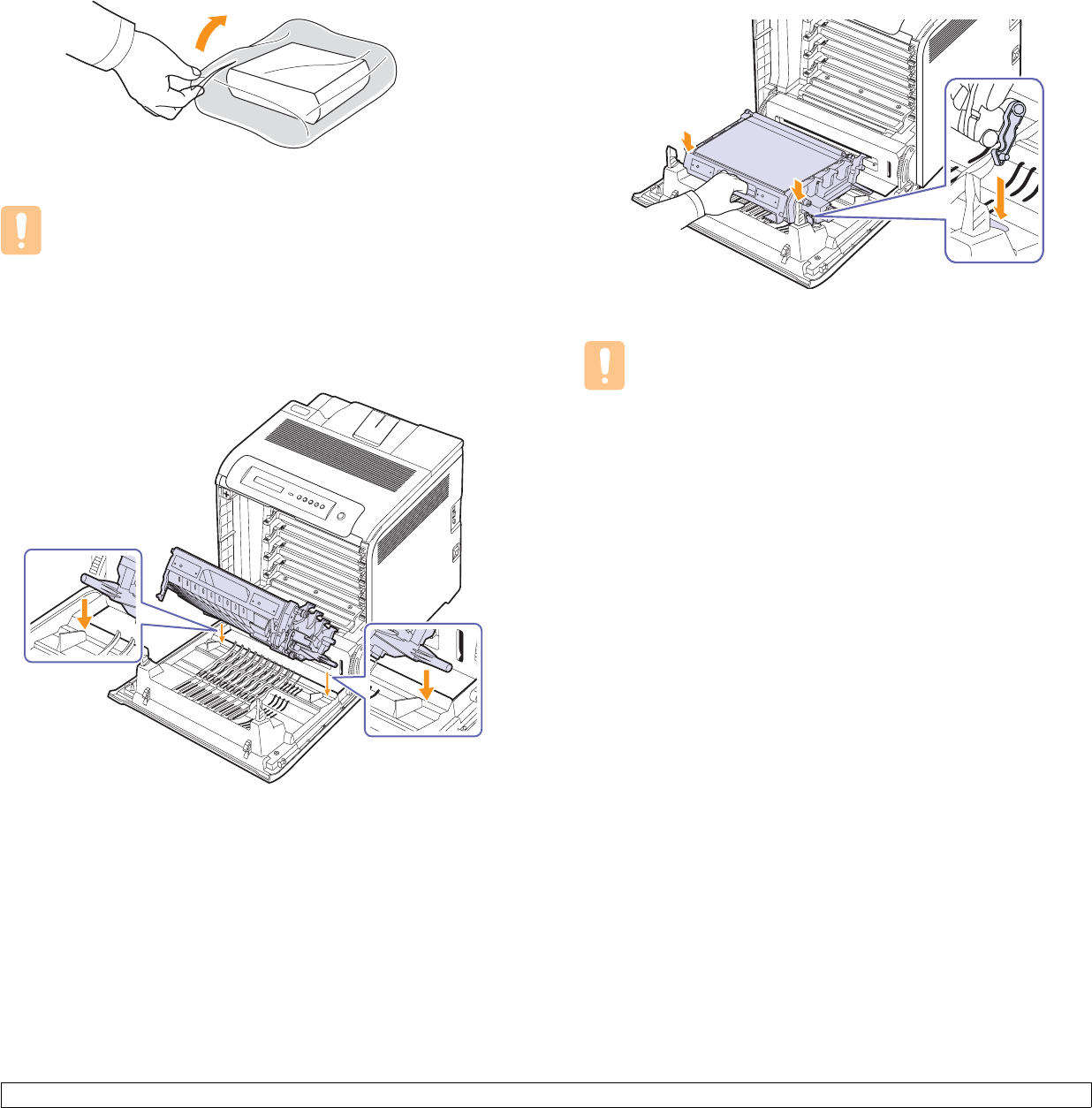
6.7 <
Maintenance>
4Take a new paper transfer belt out of its package.
5Remove the paper covering the paper transfer belt.
Caution
• Don't use sharp objects, such as a knife or scissors, to open
the paper transfer belt package. You could damage the
surface of the paper transfer belt.
• Be careful not to scratch the surface of the paper transfer
belt.
6Holding the handle on the new paper transfer belt, align it with the
slots on the inside of the front cover.
7Lower the paper transfer belt until it is parallel with the front cover
and firmly seated.
8Close the front cover firmly.
Caution
If the front cover is not completely closed, the machine will not
operate.
9Turn the machine on.
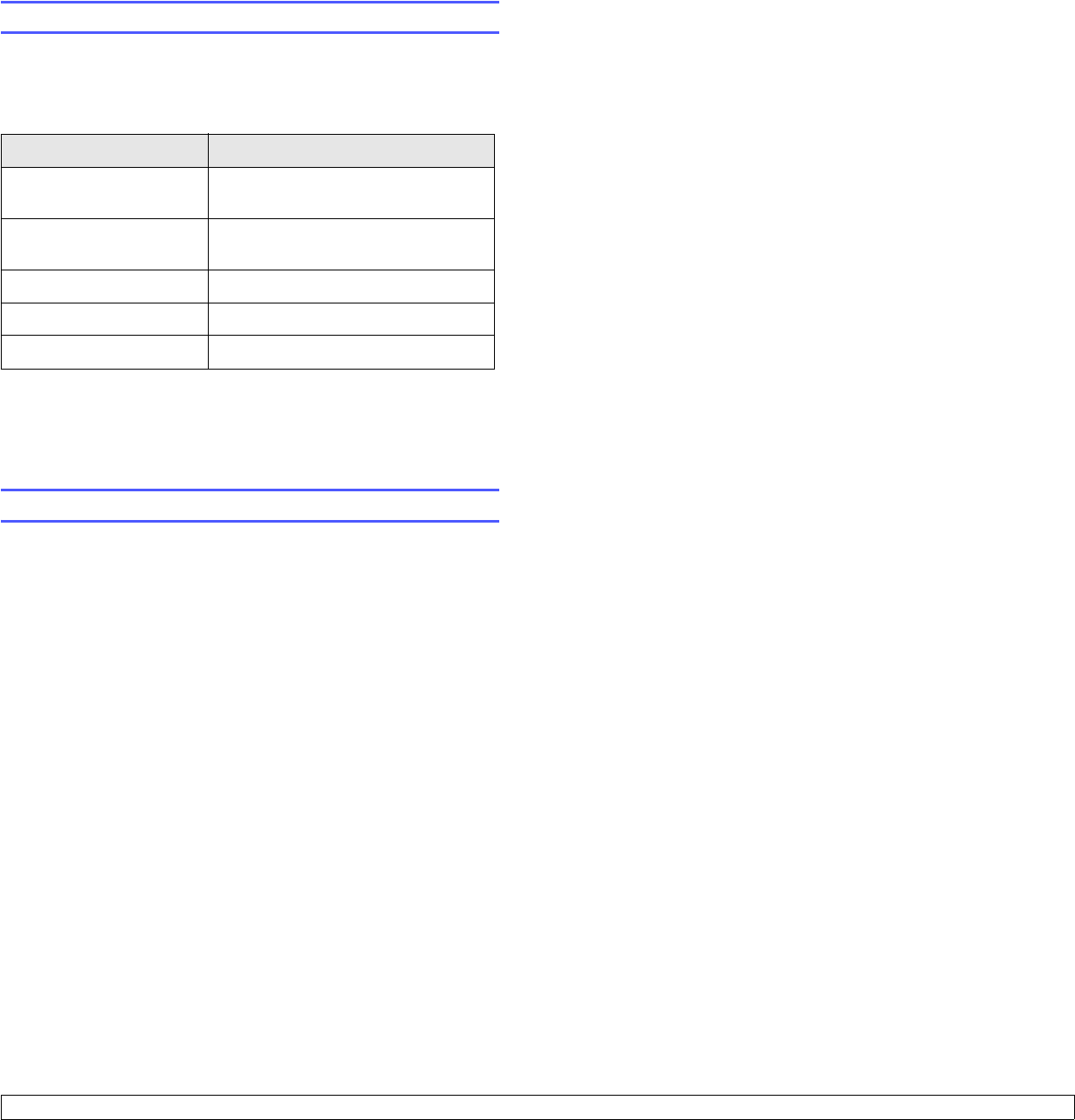
6.8 <
Maintenance>
Maintenance Parts
To avoid print quality and paper feed problems resulting from worn parts,
and to maintain your machine in top working condition, the following items
will need to be replaced after the specified number of pages, or when the
life span of each item has expired.
We highly recommend that this maintenance be performed by an
authorized service provider, dealer or the retailer where you bought the
machine. The warranty does not cover the replacement of the
maintenance parts after their lifespan.
Managing your machine from the website
If you have connected your machine to a network and set up TCP/IP
network parameters correctly, you can manage the machine via
Samsung’s SyncThru™ Web Service, an embedded web server. Use
SyncThru™ Web Service to:
• View the device information and check its current status.
• Change TCP/IP parameters and set up other network parameters.
• Change the printer properties.
• Set the machine to send email notifications and update you on the
machine’s status.
• Get support for using the machine.
To access SyncThru™ Web Service:
1Start a web browser, such as Internet Explorer, from Windows.
2Enter the machine IP address (http://xxx.xxx.xxx.xxx) in the address
field and press the Enter key or click
Go
.
Your machine’s embedded website opens.
Items Yield (Average)
Multi-purpose tray rubber
pad
Approx. 70,000 pages
Multi-purpose tray pick up
roller
Approx. 70,000 pages
Fuser unit Approx. 50,000 pages
Paper pick up roller Approx. 70,000 pages
FCF rubber pad Approx. 70,000 pages
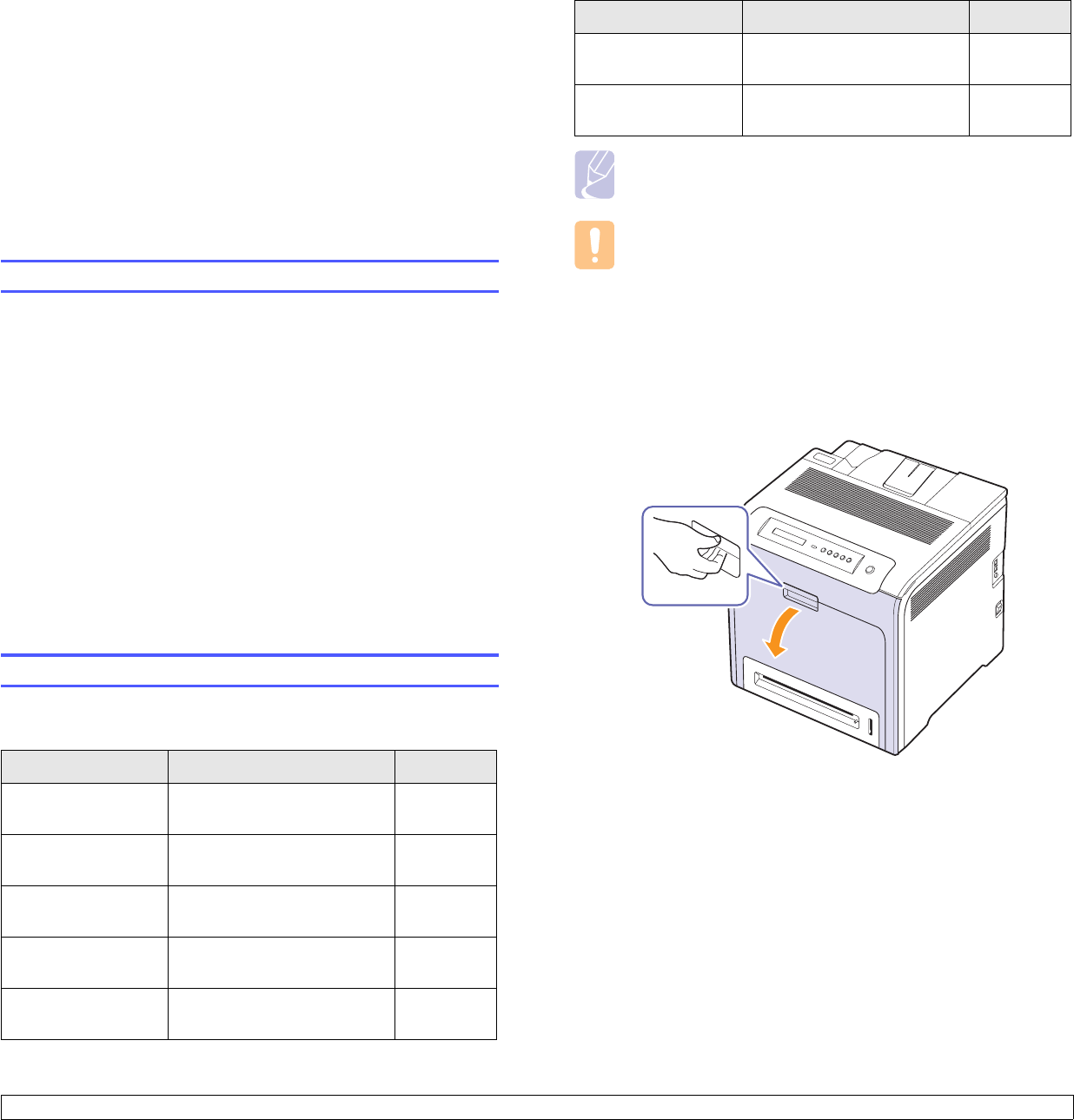
7.1 <
Troubleshooting>
7 Troubleshooting
This chapter gives helpful information on what to do if you encounter a
problem.
This chapter includes:Machine Setup
• Tips for avoiding paper jams
• Clearing paper jams
• Understanding display messages
• Solving other problems
Tips for avoiding paper jams
By selecting the correct media types, most paper jams can be avoided.
When a paper jam occurs, follow the steps outlined on page 7.1.
• Follow the procedures on page 4.4. Ensure that the adjustable guides
are positioned correctly.
• Do not overload the tray. Ensure that the paper level is below the
paper capacity mark on the inside of the tray.
• Do not remove paper from the tray while your machine is printing.
• Flex, fan, and straighten paper before loading.
• Do not use creased, damp, or highly curled paper.
• Do not mix paper types in a tray.
• Use only recommended print media. (
See "Setting the paper size and
type" on page 4.7.
)
• Ensure that the recommended side of the print media is facing down in
the tray, or facing down in the multi-purpose tray.
Clearing paper jams
When a paper jam occurs, the warning message appears on the display
screen. Refer to the table below to locate and clear the paper jam.
Message Location of jam Go to
MP Tray
Paper Jam 0
In the multi purpose tray Page 7.3
Tray 2
Paper Jam 0
In the optional tray Page 7.6
Paper Jam 0
Open/Close Door
In the paper feed area and
inside the machine
Page 7.1,
Page 7.4
Paper Jam 1
Open/Close Door
Inside the machine Page 7.1,
Page 7.4
Paper Jam 2
Check Inside
Inside the machine and in the
exit area
Page 7.1,
Page 7.5
Note
The symbol * denotes an optional feature depending on
machines.
Caution
To avoid tearing the paper, pull the jammed paper out gently
and slowly. Follow the instructions in the following sections to
clear the jam.
In the paper feed area
If paper is jammed in the paper feed area, follow the next steps to release
the jammed paper.
1Using the handle, completely open the front cover.
Duplex Jam 0
Check Inside*
Inside the machine Page 7.1
Duplex Jam 1
Open/Close Door*
In the paper feed area and
inside the machine
Page 7.1,
Page 7.4
Message Location of jam Go to
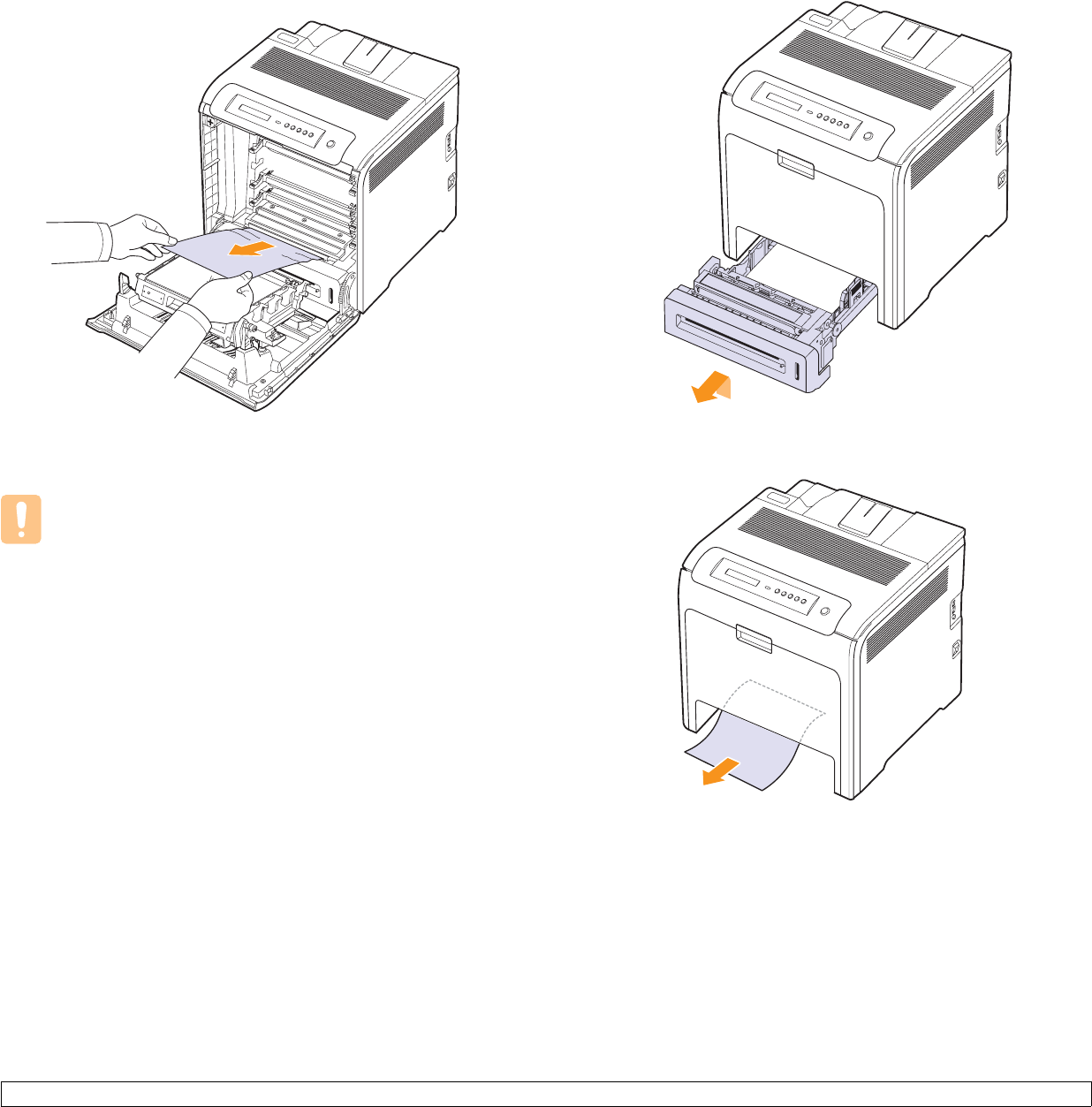
7.2 <
Troubleshooting>
2Carefully remove the paper by pulling in the direction as shown
below. Go to step 7.
If you cannot find the jammed paper, or if there is any resistance
removing the paper, stop pulling, and go to step 3.
Caution
• Do not touch the green surface, the OPC drum or the front of
each print cartridge, with your hands or any other material.
Use the handle on each cartridge in order to avoid touching
this area.
• Be careful not to scratch the surface of the paper transfer
belt.
• If you leave the front cover open for more than a few minutes,
the OPC drum can be exposed to light. This will cause
damage to the OPC drum. Close the front cover should the
installation need to be halted for any reason.
3Close the front cover.
4Pull the tray open.
5Remove the jammed paper by gently pulling it straight out as shown
below.
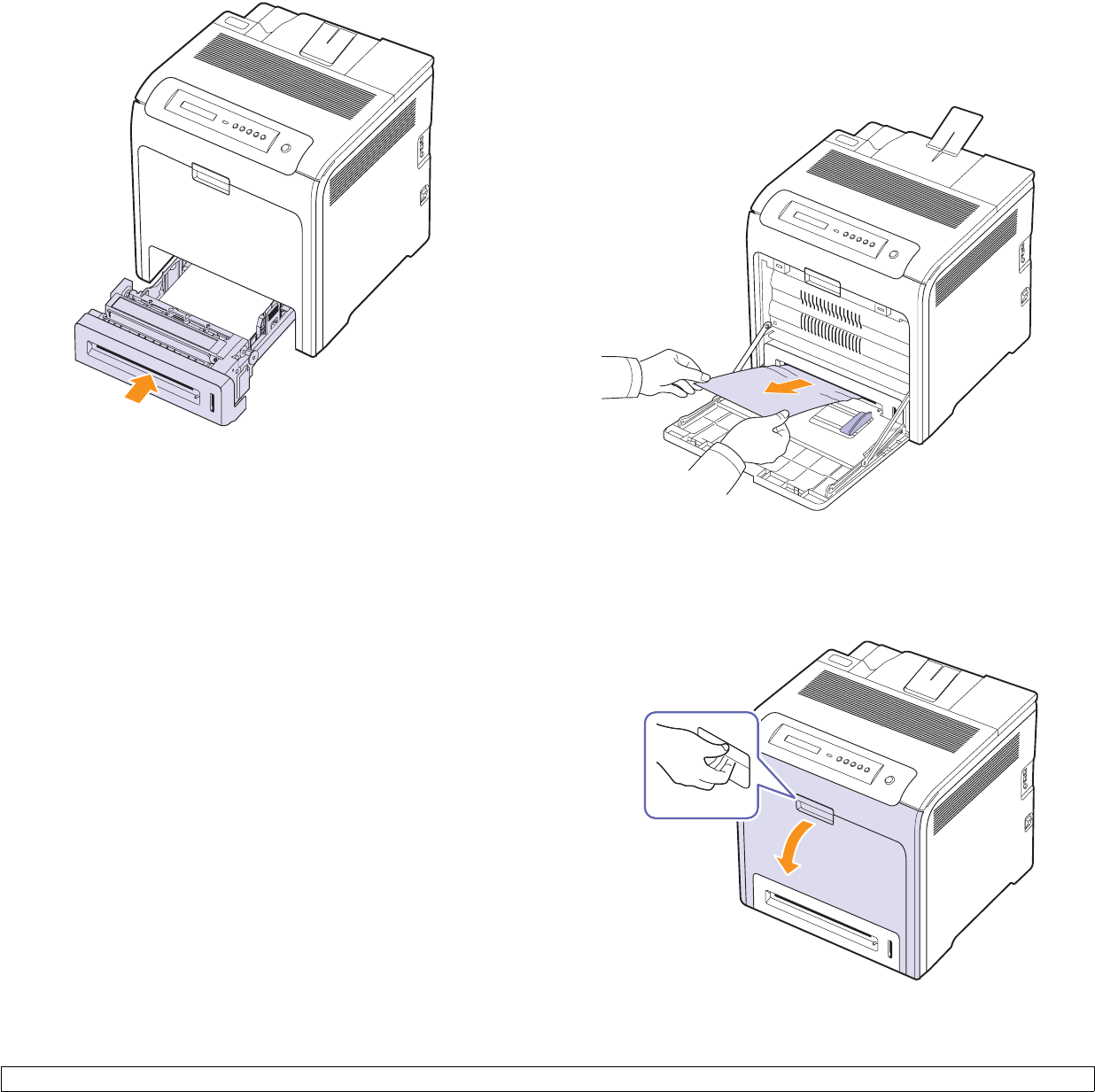
7.3 <
Troubleshooting>
6To replace the tray, lower the rear edge, align it with the slot, and
slide it into the machine.
7Open the front cover and close it. The machine will resume printing.
In the multi-purpose tray
When you print using the Multi-purpose Tray and the machine detects
that there is either no paper or that the paper has been improperly loaded,
follow the next steps to release the jammed paper.
1Check if the paper is stuck in the feeding area, and if so, pull it out
gently and slowly.
If you cannot find the jammed paper, or if there is any resistance
removing the paper, stop pulling and go to step 2.
2Using the handle, completely open the front cover.
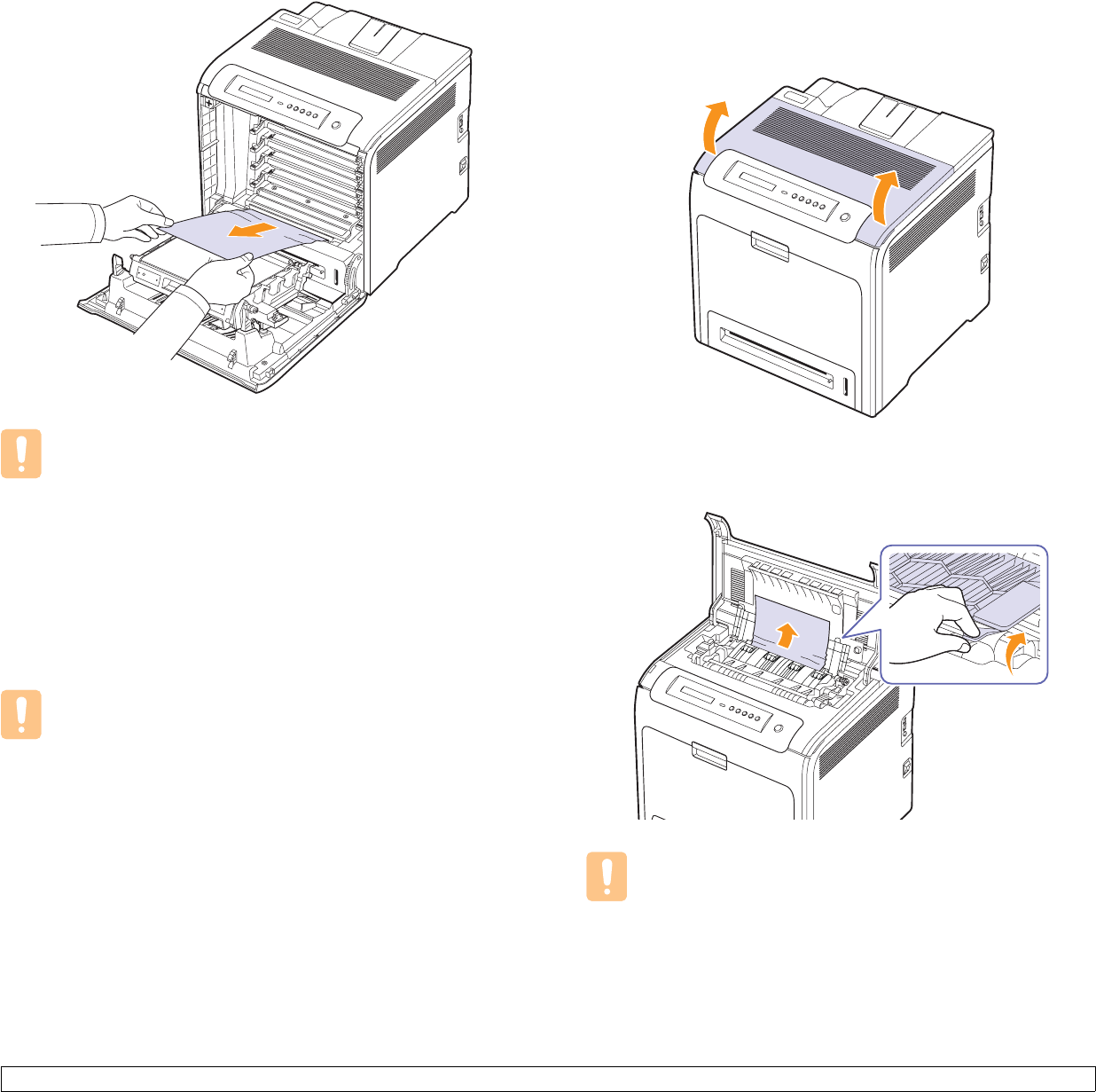
7.4 <
Troubleshooting>
3Remove the jammed paper by pulling in the direction shown. To
avoid tearing the paper, pull it out gently and slowly.
Caution
• Do not touch the green surface, the OPC drum or the front of
each print cartridge, with your hands or any other material.
Use the handle on each cartridge in order to avoid touching
this area.
• Be careful not to scratch the surface of the paper transfer
belt.
• If you leave the front cover open for more than a few minutes,
the OPC drum can be exposed to light. This will cause
damage to the OPC drum. Close the front cover should the
installation need to be halted for any reason.
4Close the front cover firmly. The machine will resume printing.
Caution
If the front cover is not completely closed, the machine will not
operate.
In the fuser unit area
If paper is jammed in the fuser unit area, follow the next steps to release
the jammed paper.
1Open the top cover.
2Open the inner cover using the handle on it and carefully take the
jammed paper out of the machine.
Caution
Do not touch the fuser inside the inner cover. It is hot and could
cause burns! The fuser's operating temperature is 180
°
C
(356
°
F). Take care when removing paper from the machine.
3Close the inner cover.
4After removing the jammed paper, check for paper which may be
jammed in other parts of the machine.
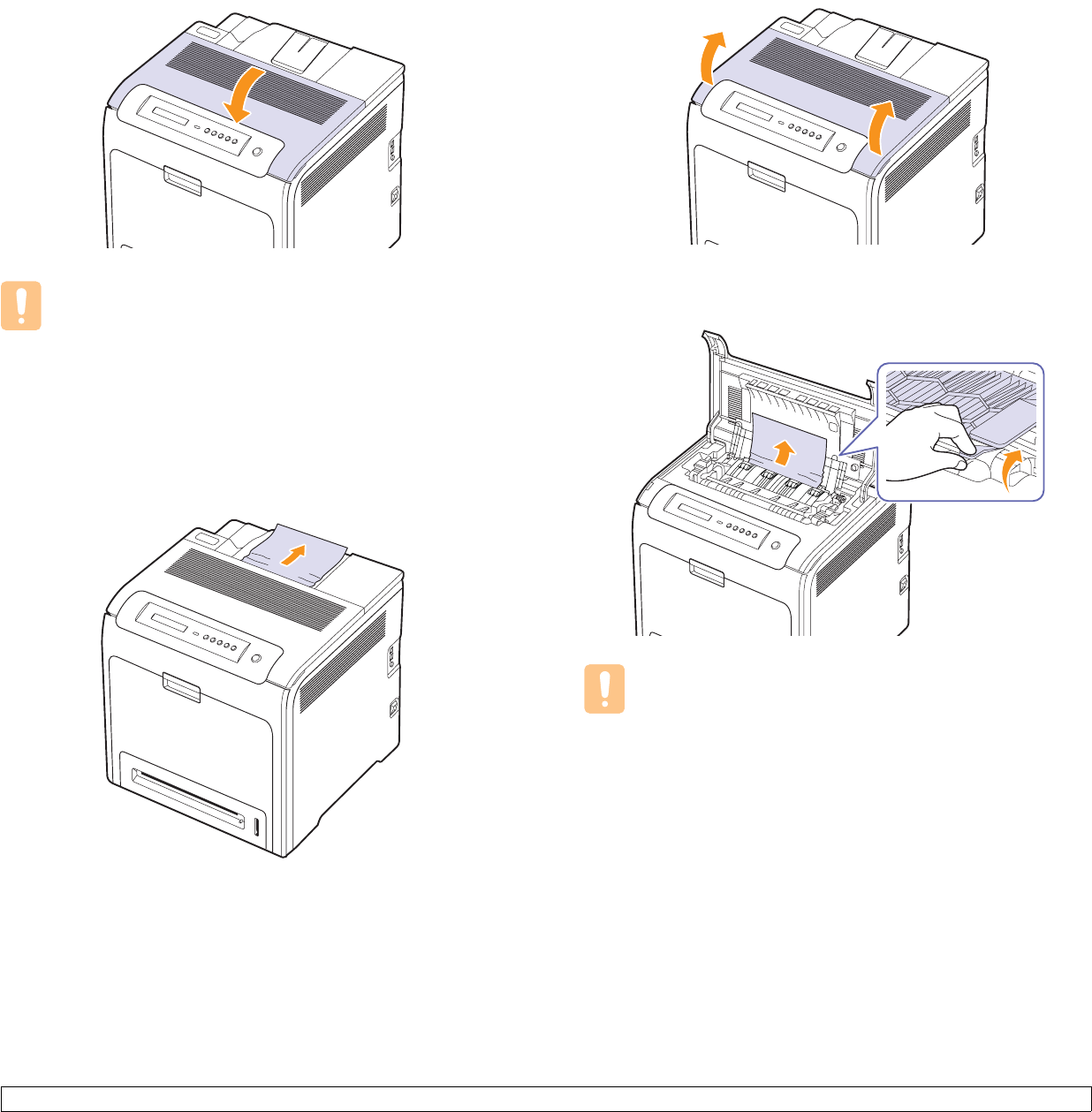
7.5 <
Troubleshooting>
5Close the top cover. Make sure that it is securely latched.
Caution
If the top cover is not completely closed, the machine will not
operate.
In the paper exit area
If paper is jammed in the paper exit area, follow the next steps to release
the jammed paper.
1If a long portion of the paper is visible, pull it straight out.
Open and close the front cover firmly. The machine will resume
printing.
If you cannot find the jammed paper, or if there is any resistance
removing the paper, stop pulling and go to step 2.
2Open the top cover.
3Open the inner cover using the handle on it and carefully take the
jammed paper out of the machine.
Caution
Do not touch the fuser inside the inner cover. It is hot and could
cause burns! The fuser's operating temperature is 180
°
C
(356
°
F). Take care when removing paper from the machine.
4Close the inner cover.
5After removing the jammed paper, check for paper which may be
jammed in other parts of the machine.

7.6 <
Troubleshooting>
6Close the top cover. Make sure that it is securely latched.
Caution
If the top cover is not completely closed, the machine will not
operate.
In the optional tray
If paper is jammed in the optional Tray, follow the next steps to release
the jammed paper.
1Pull the optional Tray open. After you pull it all the way out, lift up the
front part of the tray slightly to release the tray from the machine.
2If you see the jammed paper, remove the paper from the machine
by gently pulling it straight out as shown below.
3Slide the tray back into the machine and close the two jam covers.
4Open the front cover.
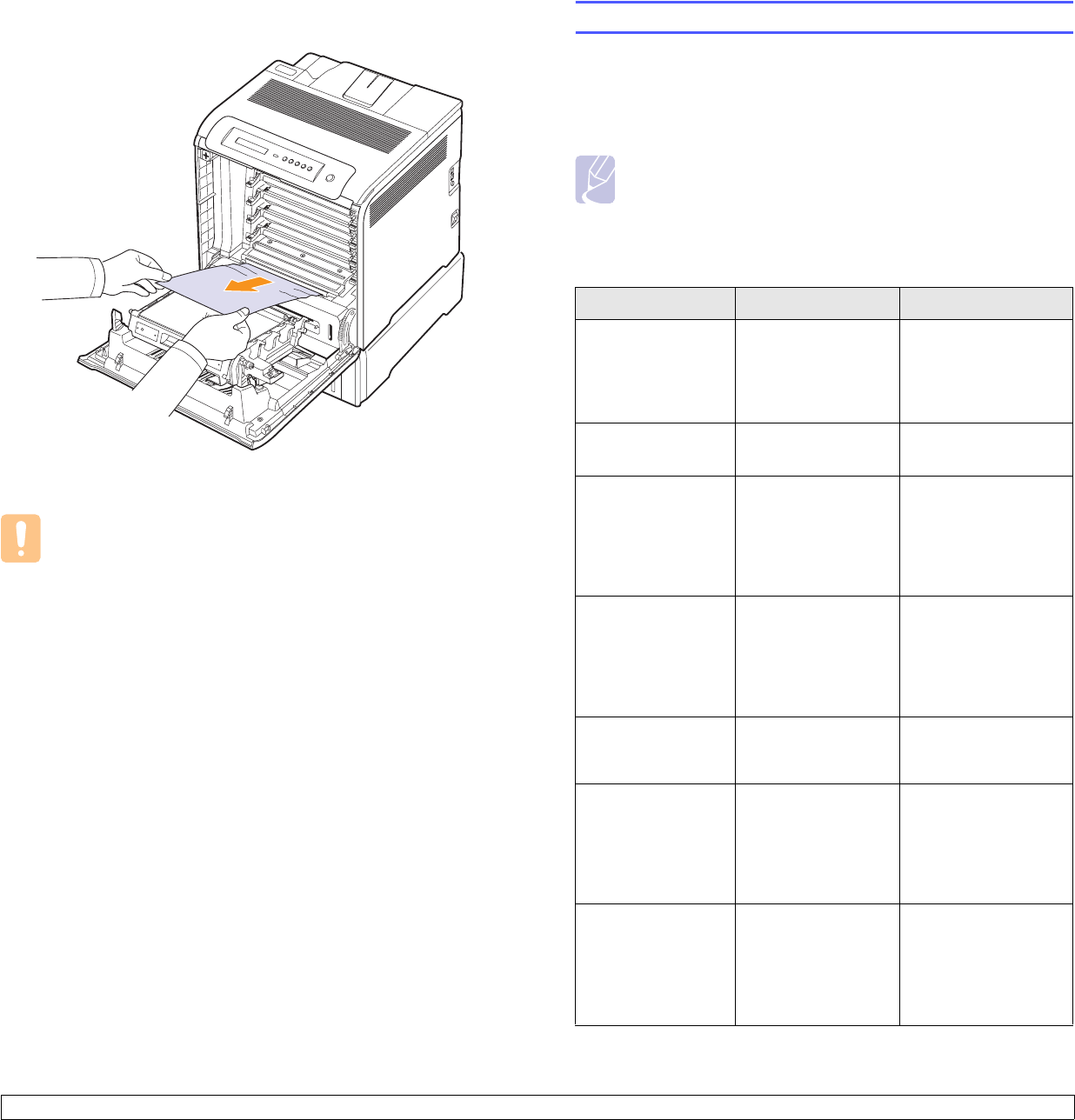
7.7 <
Troubleshooting>
5Pull the jammed paper out in the direction shown. To avoid tearing
the paper, pull it out gently and slowly.
6Close the front cover firmly. The machine will resume printing.
Caution
If the front cover is not completely closed, the machine will not
operate.
Understanding display messages
Messages appear on the Smart Panel program window or on the control
panel display to indicate machine status or errors. Refer to the tables
below to understand the messages meaning to correct the problem, if
necessary. Messages and their explanations are listed in alphabetical
order.
Note
When you call for service, it is very convenient to provide the
service representative with the contents of the display message.
* xxx indicates the media type.
* yyy indicates the tray type.
Message Explanation Solution
[yyy]
Cassette Out
The tray cassette is
not properly closed.
To close the tray,
lower the rear edge,
align it with the slot,
and slide it into the
printer.
[yyy]
Paper Empty
There is no paper in
the tray.
Load paper in the
tray. (Page 4.4)
ADC Not
Confirm Error
There is a problem
in the ADC (Analog
to Digital Converter)
of your machine.
Unplug the power
cord and plug it back
in. If the problem
persists, contact the
service
representatives.
ADC Slope Error
Cycle Power
The temperature
slope for ADC
(Analog to Digital
Converter) shows
the value out of the
normal range.
Unplug the power
cord and plug it back
in. If the problem
persists, contact the
service
representatives.
Adjusting...
Registration
The machine is
adjusting the color
registration.
Please wait a few
minutes.
CTD Calibration
Error
The CTD (Color
Tone r Densi ty)
Calibration has an
invalid value.
Unplug the power
cord and plug it back
in. If the problem
persists, contact the
service
representatives.
Deve Motor
Locked
There is a problem
with the deve motor
to machines which
moves the toner
supply device.
Unplug the power
cord and plug it back
in. If the problem
persists, contact the
service
representatives.
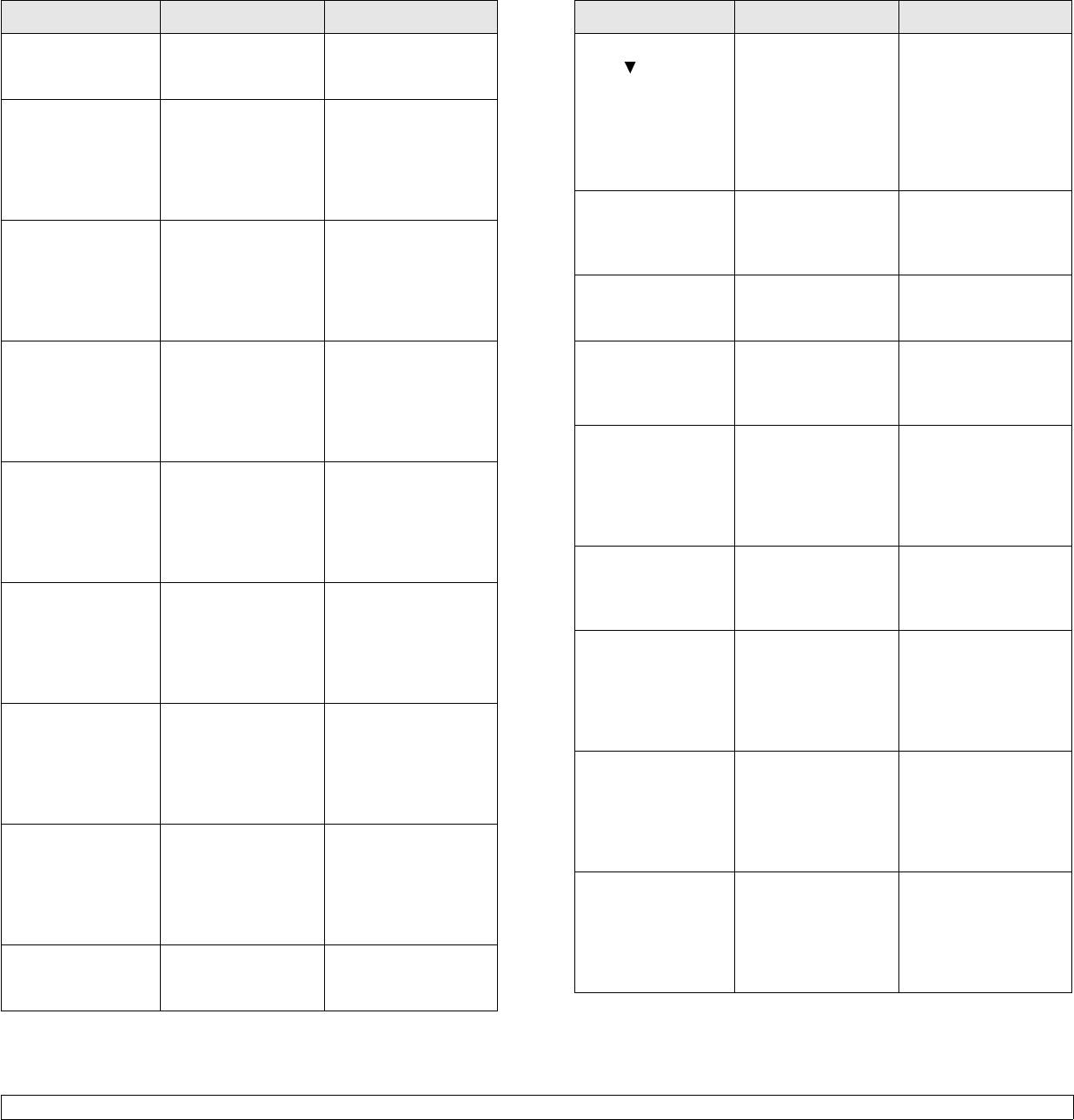
7.8 <
Troubleshooting>
Door Open The front cover or
the top cover is not
securely latched.
Close the cover until it
locks into place.
Duplex Jam 0
Check Inside
Paper has jammed
during duplex
printing. This is
applicable only to
machines with this
feature.
Clear the jam.
(Page 7.1)
Duplex Jam 1
Open/Close Door
Paper has jammed
during duplex
printing. This is
applicable only to
machines with this
feature.
Clear the jam.
(Page 7.1)
Fuser Fan
Locked
There is a problem
with the fan for the
fuser unit.
Unplug the power
cord and plug it back
in. If the problem
persists, contact the
service
representatives.
Humidity Open
Cycle Power
The humidity
exceeds the normal
range.
Unplug the power
cord and plug it back
in. If the problem
persists, contact the
service
representatives.
Humidity Out
Cycle Power
The humidity has
fallen under the
normal range.
Unplug the power
cord and plug it back
in. If the problem
persists, contact the
service
representatives.
Inner Temp. Open
Cycle Power
The inner
temperature of the
machine is above
the normal range.
Unplug the power
cord and plug it back
in. If the problem
persists, contact the
service
representatives.
Inner Temp. Short
Cycle Power
The inner
temperature of the
machine is below
the normal range.
Unplug the power
cord and plug it back
in. If the problem
persists, contact the
service
representatives.
Install
Transfer Belt
The transfer belt is
not installed.
Install a Samsung-
genuine transfer belt.
(Page 8.1, Page 6.6)
Message Explanation Solution
Install Toner The print cartridge is
installed improperly,
or not installed.
Reinstall the print
cartridge two or three
times. If the problem
persists, the print
cartridge is not being
detected. Please
contact the service
representatives.
IP Conflict The network IP
address you have
set is being used by
someone else.
Check the IP address
and reset it if
necessary. (Page 3.2)
Load Manually
Press Stop Key
The multi-purpose
tray is empty in
manual feed mode.
Load paper in the
multi-purpose tray.
(Page 4.6)
Load
[xxx] In [yyy]
There is no
corresponding paper
in the corresponding
tray.
Load corresponding
paper in the
corresponding tray.
(Page 4.4)
Low Heat Error
Cycle Power
The fuser unit is low-
heated.
Unplug the power
cord and plug it back
in. If the problem
persists, contact the
service
representatives.
Low Power The machine is in
the previous stage
of the power save
mode.
When data is
received, it switches
to on-line
automatically.
LSU C-Hsync Err.
Cycle Power
There is a problem
in the laser beam
detecting device of
the LSU (Laser
Scanning Unit).
Unplug the power
cord and plug it back
in. If the problem
persists, contact the
service
representatives.
LSU C-Motor Err.
Cycle Power
There is a problem
in the LSU (Laser
Scanning Unit)
motor.
Unplug the power
cord and plug it back
in. If the problem
persists, contact the
service
representatives.
LSU Hsync Error
Cycle Power
There is a problem
in the laser beam
detecting device of
the LSU (Laser
Scanning Unit).
Unplug the power
cord and plug it back
in. If the problem
persists, contact the
service
representatives.
Message Explanation Solution
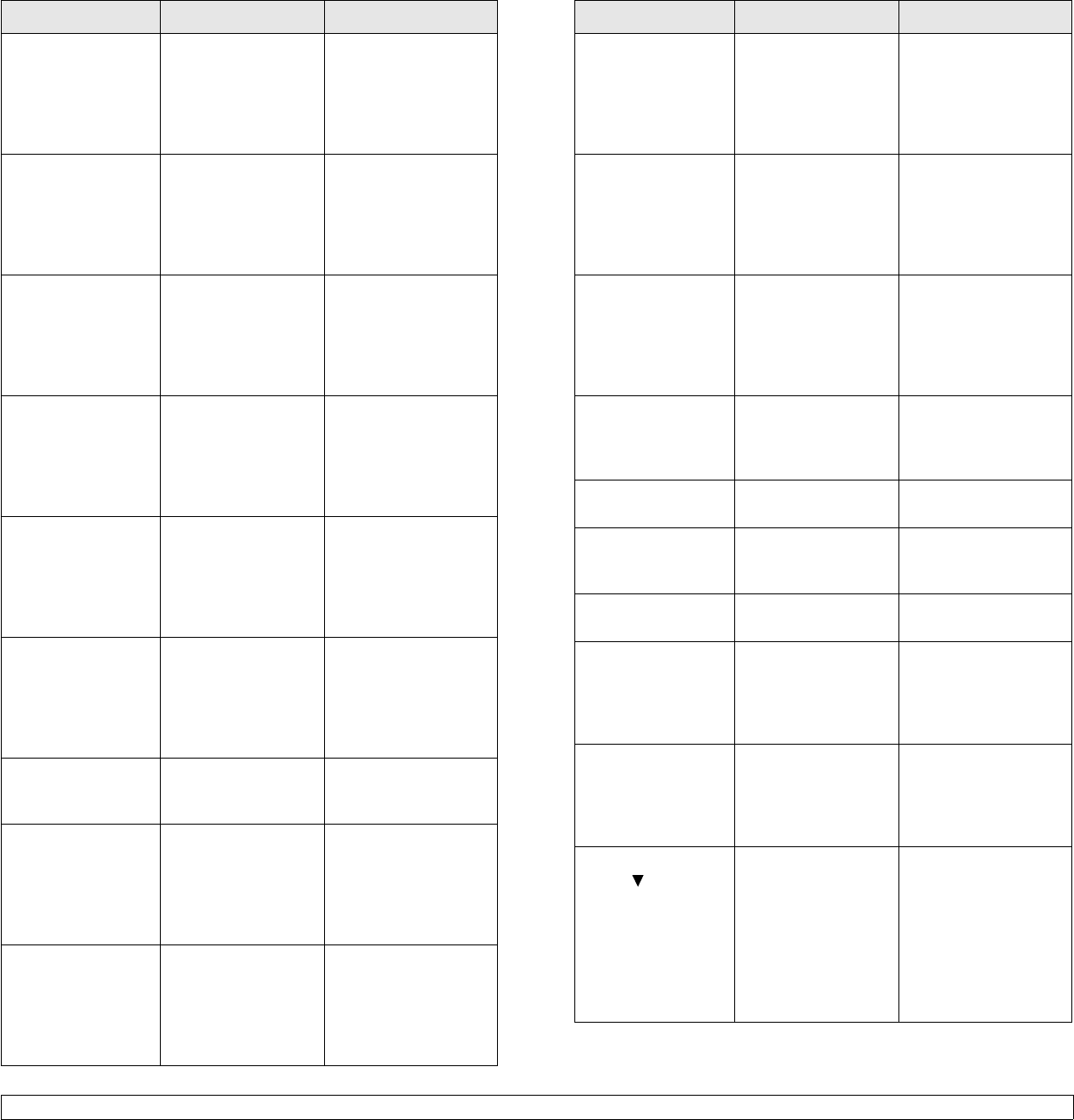
7.9 <
Troubleshooting>
LSU M-Hsync Err.
Cycle Power
There is a problem
in the laser beam
detecting device of
the LSU (Laser
Scanning Unit).
Unplug the power
cord and plug it back
in. If the problem
persists, contact the
service
representatives.
LSU M-Motor Err.
Cycle Power
There is a problem
in the LSU (Laser
Scanning Unit)
motor.
Unplug the power
cord and plug it back
in. If the problem
persists, contact the
service
representatives.
LSU Motor Error
Cycle Power
There is a problem
in the LSU (Laser
Scanning Unit)
motor.
Unplug the power
cord and plug it back
in. If the problem
persists, contact the
service
representatives.
LSU Y-Hsync Err.
Cycle Power
There is a problem
in the laser beam
detecting device of
the LSU (Laser
Scanning Unit).
Unplug the power
cord and plug it back
in. If the problem
persists, contact the
service
representatives.
LSU Y-Motor Err.
Cycle Power
There is a problem
in the LSU (Laser
Scanning Unit)
motor.
Unplug the power
cord and plug it back
in. If the problem
persists, contact the
service
representatives.
Main Motor
Locked
There is a problem
with the main motor
for the machine.
Unplug the power
cord and plug it back
in. If the problem
persists, contact the
service
representatives.
MP Tray
Paper Jam 0
Paper has jammed
in the multi-purpose
tray.
Clear the jam.
(Page 7.3)
New Fuser
Error
The problem has
occurred in the
newly installed fuser
unit.
Unplug the power
cord and plug it back
in. If the problem
persists, contact the
service
representatives.
Open Heat Error
Cycle Power
The temperature for
the fuser unit is
above the normal
range.
Unplug the power
cord and plug it back
in. If the problem
persists, contact the
service
representatives.
Message Explanation Solution
Outer Temp.Open
Cycle Power
The outer
temperature of the
machine is above
the normal range.
Unplug the power
cord and plug it back
in. If the problem
persists, contact the
service
representatives.
Outer Temp.Short
Cycle Power
The outer
temperature of the
machine is below
the normal range.
Unplug the power
cord and plug it back
in. If the problem
persists, contact the
service
representatives.
Over Heat Error
Cycle Power
The fuser unit is
overheated.
Unplug the power
cord and plug it back
in. If the problem
persists, contact the
service
representatives.
Paper Jam 0
Open/Close Door
Paper has jammed
in the paper feed
area and inside the
machine.
Clear the jam.
(Page 7.1)
Paper Jam 1
Open/Close Door
Paper has jammed
inside the machine.
Clear the jam.
(Page 7.1)
Paper Jam 2
Check Inside
Paper has jammed
in the paper exit
area.
Clear the jam.
(Page 7.5)
Remove Jam
Open/Close Door
Paper has jammed
in the fuser area.
Clear the jam.
(Page 7.4)
Replace Fuser The life of the fuser
unit is expired.
Replace the fuser unit
with a new one.
Please contact the
service
representatives.
Replace Fuser
Soon
The life of the fuser
unit will be expired
soon.
Replace the fuser unit
with a new one.
Please contact the
service
representatives.
Replace Toner This message
appears between
Toner Low and
Tone r Emp ty.
Replace the
corresponding print
cartridge with a
Samsung-genuine
cartridge. (Page 6.4)
The arrow indicates
which color print
cartridge has to be
replaced.
Message Explanation Solution
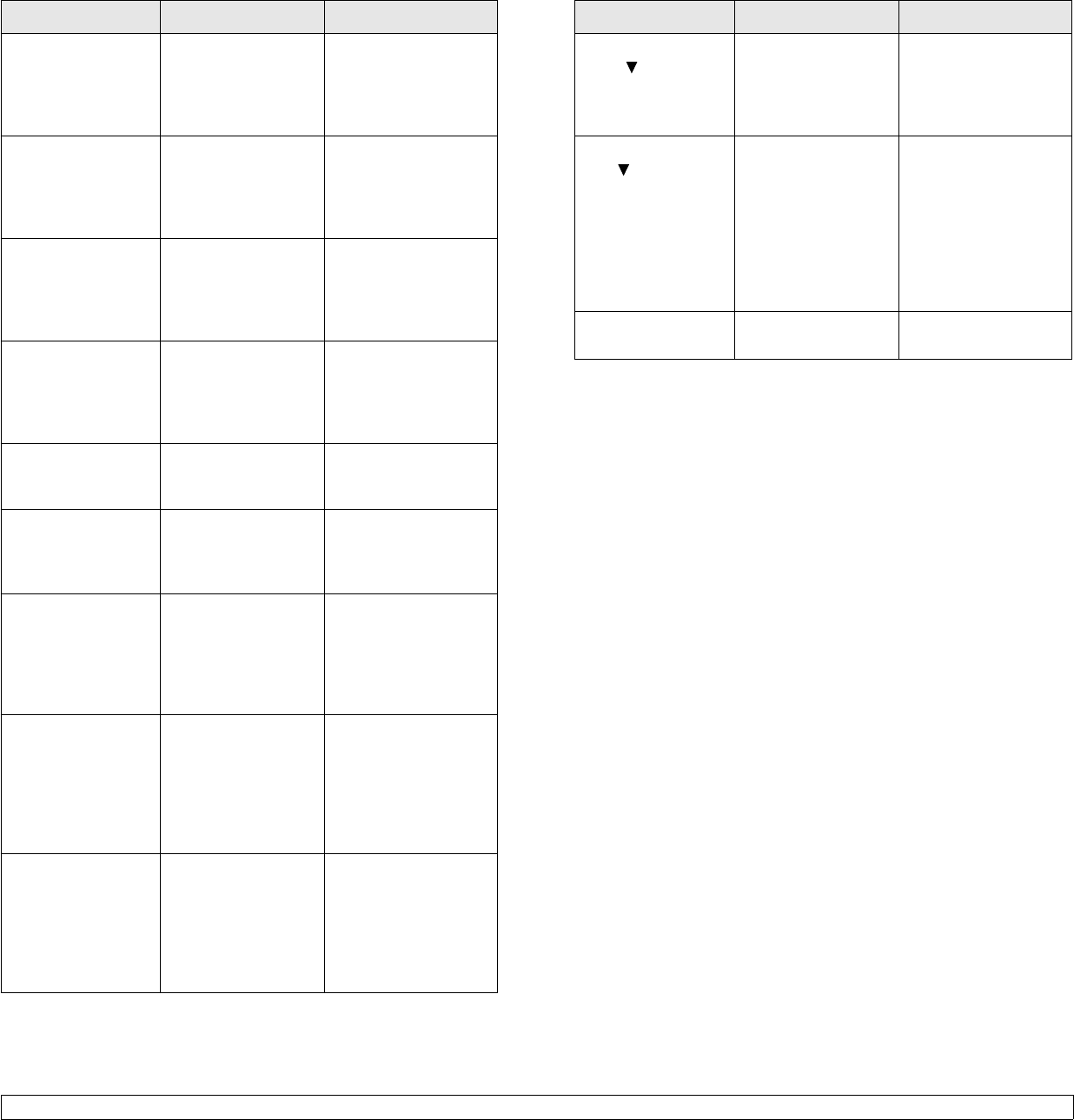
7.10 <
Troubleshooting>
Replace Transfer
Belt
The life of the
transfer belt is
expired.
Replace the paper
transfer belt with a
new one. Please
contact the service
representatives.
Replace Transfer
Belt Soon
The life of the
transfer belt will be
expired soon.
Replace the transfer
belt with a new one.
Please contact the
service
representatives.
Replace [yyy]
Pick-Roller
The life of the tray
pick-roller has
expired.
Replace the pick up -
roller with a new one.
Please contact the
service
representatives.
Self Diagnostics
LSU
The LSU (Laser
Scanning Unit) in
your machine is
checking problems
detected.
Please wait a few
minutes.
Self Diagnostics
Temperature
The engine in your
machine is checking
problems detected.
Please wait a few
minutes.
Sleeping... The machine is in
the power save
mode.
When data is
received, it switches
to on-line
automatically.
System Fan
Locked
There is a problem
with the main fan for
the machine.
Unplug the power
cord and plug it back
in. If the problem
persists, contact the
service
representatives.
Thermistor Open
Cycle Power
There is a problem
in the temperature
sensing device for
the fuser unit. This
device detects a
value above the
normal value range.
Unplug the power
cord and plug it back
in. If the problem
persists, contact the
service
representatives.
Thermistor Short
Cycle Power
There is a problem
in the temperature
sensing device for
the fuser unit. This
device detects a
value below the
normal value range.
Unplug the power
cord and plug it back
in. If the problem
persists, contact the
service
representatives.
Message Explanation Solution
Toner Empty The color print
cartridge which the
arrow indicates has
run out.
Replace the
corresponding print
cartridge with a
Samsung-genuine
cartridge. (Page 6.4)
Toner Low The color print
cartridge which the
arrow indicates is
almost empty.
Take out the
corresponding print
cartridge and
thoroughly shake it.
By doing this, you can
temporarily
reestablish printing
operations.
(Page 6.3)
Tray 2
Paper Jam 0
Paper has jammed
in the optional tray.
Clear the jam.
(Page 7.6)
Message Explanation Solution
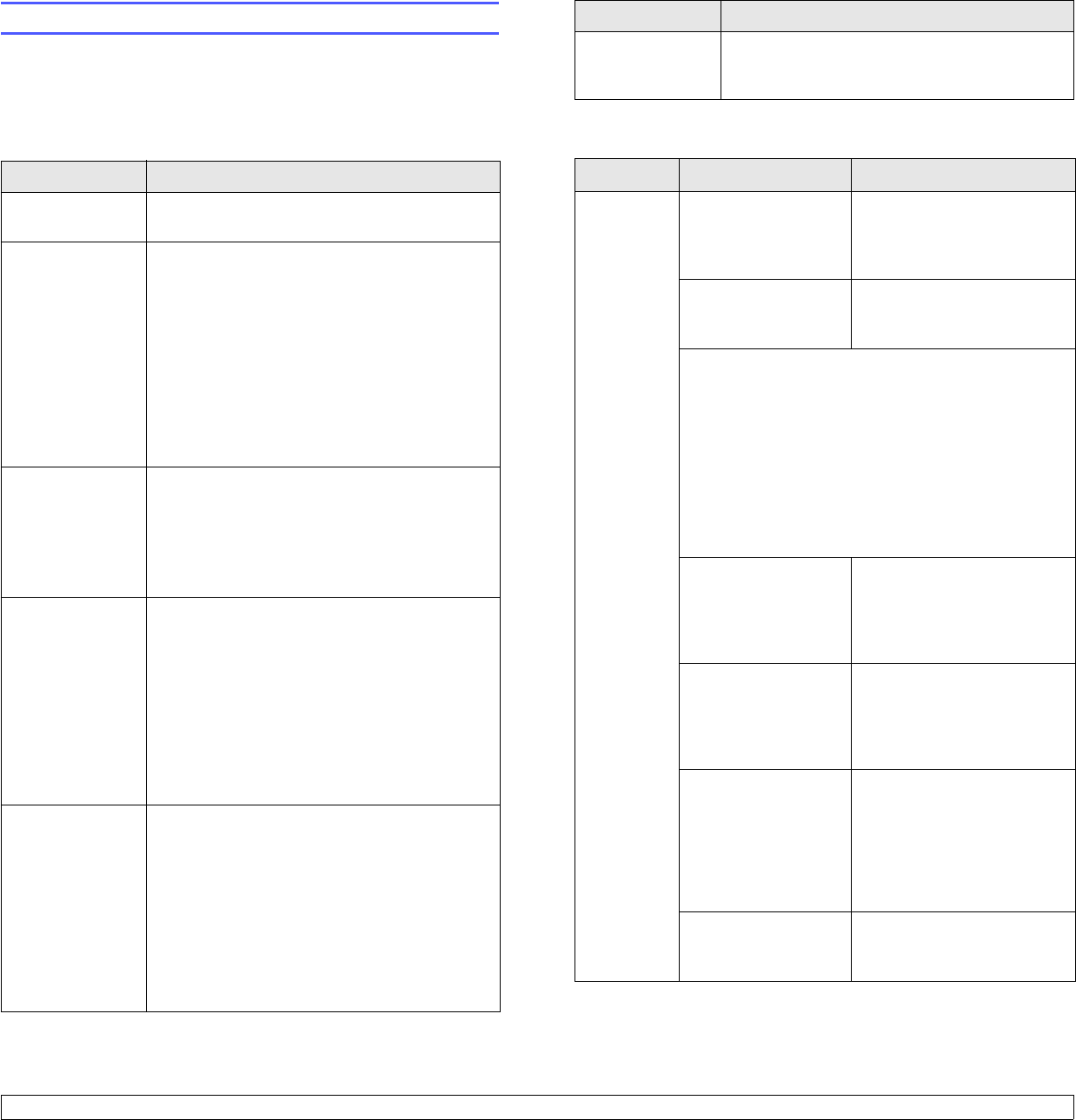
7.11 <
Troubleshooting>
Solving other problems
The following chart lists some conditions that may occur and the
recommended solutions. Follow the suggested solutions until the
problem is corrected. If the problem persists, please call for service.
Paper feeding problems
Condition Suggested solutions
Paper is jammed
during printing.
Clear the paper jam. (See "Clearing paper
jams" on page 7.1.)
Paper sticks
together.
• Ensure that there is not too much paper in the
tray. The tray can hold up to 250 sheets of
paper, depending on the thickness of the
paper.
• Make sure that you are using the correct type
of paper. (See "Specifications on print
media" on page 4.2.)
• Remove paper from the tray and flex or fan
the paper.
• Humid conditions may cause some paper to
stick together.
Multiple sheets of
paper do not
feed.
• Different types of paper may be stacked in the
tray. Load paper of only one type, size, and
weight.
• If multiple sheets have caused a paper jam,
clear the paper jam. (See "Clearing paper
jams" on page 7.1.)
Paper does not
feed into the
machine.
• Paper has not been loaded correctly. Remove
paper from the tray and reload it correctly.
• There is too much paper in the tray. Remove
excess paper from the tray.
• The paper is too thick. Use only paper that
meets the specifications required by the
machine. (See "Specifications on print
media" on page 4.2.)
• Remove any obstructions from inside the
machine.
The paper keeps
jamming.
• There is too much paper in the tray. Remove
excess paper from the tray. If you are printing
on special materials, use the multi-purpose
tray.
• An incorrect type of paper is being used. Use
only paper that meets the specifications
required by the machine. (See "Specifications
on print media" on page 4.2.)
• There may be debris inside the machine.
Open the front cover and remove the debris.
Printing problems
Envelopes skew
or fail to feed
correctly.
Ensure that the paper guides are against both
sides of the envelopes.
Condition Possible cause Suggested solutions
The
machine
does not
print.
The machine is not
receiving power.
Check the power cord
connections. Check the
power switch and the power
source.
The machine is not
selected as the
default printer.
Select a machine name as
your default printer in your
Windows.
Check the machine for the following:
• The cover is not closed. Close the cover.
• Paper is jammed. Clear the paper jam. (See
"Clearing paper jams" on page 7.1.)
• No paper is loaded. Load paper. (See "Loading
paper" on page 4.4.)
• The print cartridge is not installed. Install the print
cartridge.
If a system error occurs, contact your service
representative.
The connection cable
between the
computer and the
machine is not
connected properly.
Disconnect the printer cable
and reconnect it.
The connection cable
between the
computer and the
machine is defective.
If possible, attach the cable
to another computer that is
working properly and print a
job. You can also try using a
different printer cable.
The port setting is
incorrect.
Check the Windows printer
setting to make sure that the
print job is sent to the correct
port. If the computer has
more than one port, make
sure that the machine is
attached to the correct one.
The machine may be
configured
incorrectly.
Check the printer properties
to ensure that all of the print
settings are correct.
Condition Suggested solutions